Sony 75946T GSM/WCDMA/LTE Phone+Bluetooth, DTS/UNII a/b/g/n and NFC User Manual PY7 75946T User Guide
Sony Mobile Communications Inc GSM/WCDMA/LTE Phone+Bluetooth, DTS/UNII a/b/g/n and NFC PY7 75946T User Guide
Sony >
Contents
- 1. PY7-75946T_User Guide
- 2. PY7-75946T_User Startup Guide
- 3. PY7-75946T_User Guide-SAR leaflet
PY7-75946T_User Guide

Draft
User guide
G3212/G3226
Contents
Getting started............................................................................... 6
About this User guide........................................................................ 6
Overview............................................................................................ 6
Assembly........................................................................................... 7
Screen protection...............................................................................9
Starting your device for the first time.................................................9
Why do I need a Google™ account?.................................................9
Device security.............................................................................11
Making sure your device is protected..............................................11
Screen lock...................................................................................... 11
Unlocking your device automatically............................................... 13
SIM card protection......................................................................... 16
Using multiple SIM cards.................................................................16
Finding the identification number of your device.............................17
Finding a lost device ....................................................................... 18
Learning the basics...................................................................... 20
Using the touchscreen.....................................................................20
Locking and unlocking the screen................................................... 22
Home screen....................................................................................22
Application screen........................................................................... 24
Navigating applications....................................................................25
Widgets............................................................................................26
Shortcuts and folders...................................................................... 27
Background and themes..................................................................28
Taking a screenshot......................................................................... 28
Notifications..................................................................................... 29
Icons in the status bar..................................................................... 31
Applications overview...................................................................... 33
Battery and maintenance............................................................. 35
Charging your device....................................................................... 35
Battery and power management..................................................... 36
Updating your device.......................................................................38
Maintenance using a computer....................................................... 39
Storage and memory....................................................................... 40
Backing up and restoring content....................................................42
Downloading applications............................................................45
Downloading applications from Google Play™............................... 45
Downloading applications from other sources................................ 45
2
This is an internet version of this publication. © Print only for private use.
Internet and networks.................................................................. 46
Browsing the web............................................................................ 46
Internet and MMS settings ............................................................. 46
Wi-Fi.................................................................................................47
Sharing your mobile data connection.............................................. 49
Controlling data usage.....................................................................50
Selecting a SIM card for data traffic................................................ 51
Selecting mobile networks...............................................................52
Virtual private networks (VPNs)........................................................52
Synchronising data on your device..............................................54
Synchronising with online accounts................................................ 54
Synchronising with Microsoft® Exchange ActiveSync®................. 54
Basic settings...............................................................................56
Accessing settings...........................................................................56
Volume settings................................................................................56
Do not disturb mode........................................................................ 57
Screen settings................................................................................ 58
Application settings......................................................................... 59
Resetting your applications............................................................. 60
Screen saver.................................................................................... 61
Language settings............................................................................61
Date and time...................................................................................61
Super-vivid mode.............................................................................62
Enhancing the sound output............................................................62
Noise cancellation............................................................................63
Multiple user accounts.....................................................................63
Typing text....................................................................................66
On-screen keyboards...................................................................... 66
Editing text....................................................................................... 67
Calling.......................................................................................... 68
Making calls..................................................................................... 68
Receiving calls................................................................................. 69
Ongoing calls................................................................................... 70
Using the call log............................................................................. 71
Forwarding calls...............................................................................71
Restricting calls................................................................................72
Multiple calls.................................................................................... 73
Conference calls.............................................................................. 73
Voicemail..........................................................................................74
Emergency calls...............................................................................74
Contacts.......................................................................................75
Searching and viewing contacts......................................................75
3
This is an internet version of this publication. © Print only for private use.
Adding and editing contacts............................................................76
Transferring contacts....................................................................... 77
Backing up contacts........................................................................ 78
Adding medical and emergency contact information...................... 78
Favourites........................................................................................ 79
Sending contact information............................................................79
Avoiding duplicate entries in the Contacts application................... 80
Messaging and chat.....................................................................81
Reading and sending messages......................................................81
Organising your messages.............................................................. 82
Calling from Messaging................................................................... 83
Messaging settings.......................................................................... 83
Video chat........................................................................................ 83
Email.............................................................................................84
Setting up email............................................................................... 84
Sending and receiving email messages...........................................84
Organising your email messages..................................................... 85
Email account settings.....................................................................86
Gmail™............................................................................................ 86
Music and FM radio..................................................................... 88
Transferring music to your device....................................................88
Listening to music............................................................................88
Music menu..................................................................................... 90
Playlists............................................................................................ 90
Sharing music.................................................................................. 91
Enhancing the sound....................................................................... 91
Listening to the radio....................................................................... 91
Favourite radio channels..................................................................93
Radio sound settings....................................................................... 93
Camera.........................................................................................94
Taking photos and recording videos................................................94
General camera settings.................................................................. 95
Still camera settings.........................................................................99
Video camera settings................................................................... 102
Photos and videos in Album...................................................... 104
Viewing photos and videos............................................................104
Album home screen menu............................................................. 105
Sharing and managing photos and videos.................................... 106
Editing photos with the Photo editor application...........................107
Editing videos with the Video editor application............................107
Hiding photos and videos.............................................................. 108
Viewing your photos on a map...................................................... 108
4
This is an internet version of this publication. © Print only for private use.
Videos.........................................................................................110
The Video application.................................................................... 110
Transferring video content to your device..................................... 111
Managing video content................................................................ 111
Movie Creator................................................................................ 111
Connectivity............................................................................... 113
Mirroring the screen of your device wirelessly on a TV................. 113
Displaying files on another device using Cast............................... 113
Connecting your device to USB accessories................................ 114
NFC................................................................................................115
Bluetooth® wireless technology....................................................117
Smart apps and features that save you time............................. 120
Google Search & Now....................................................................120
Using the News Suite application..................................................120
Using your device as a wallet........................................................ 120
Travel and maps......................................................................... 121
Using location services.................................................................. 121
Google Maps™ and navigation..................................................... 121
Using data traffic when travelling.................................................. 122
Aeroplane mode.............................................................................122
Clock and Calendar....................................................................123
Calendar.........................................................................................123
Clock..............................................................................................123
Accessibility............................................................................... 126
Magnification gesture.................................................................... 126
Font size.........................................................................................126
Display size.................................................................................... 126
Colour correction........................................................................... 126
TalkBack.........................................................................................126
Mono audio.................................................................................... 127
TTY (Teletypewriter) mode............................................................. 127
Switch Access............................................................................... 127
Support and legal.......................................................................129
Support application....................................................................... 129
Xperia™ Tips..................................................................................129
Help in menus and applications.....................................................129
Running diagnostic tests on your device.......................................129
Restarting, resetting and repairing.................................................129
Help us improve our software........................................................131
Warranty, SAR and usage guidelines.............................................131
Recycling your device....................................................................131
Legal information........................................................................... 131
5
This is an internet version of this publication. © Print only for private use.

Getting started
About this User guide
This is the Xperia™ XA1 Ultra User guide for the Android™ 7.1.1 software version. If
you're not sure which software version your device is running, you can check it in the
Settings menu.
System and application updates can present the features in your device in another way than
described in this User guide. The Android™ version might not be affected in an update. For
more information about software updates, see
Updating your device
on page 38.
To check the current software version of your device
1From your Home screen, tap .
2Find Settings > About phone > Android™ version.
Limitations to services and features
Some of the services and features described in this User guide may not be supported
in all countries or regions, or by all networks or service providers. The GSM
International Emergency Number can always be used in all countries, regions,
networks and by all service providers, provided that the device is connected to the
mobile network. Please contact your network operator or service provider to
determine the availability of any specific service or feature and whether additional
access or usage fees apply.
The use of certain features and applications described in this guide may require
access to the internet. You may incur data connection charges when you connect to
the internet with your device. Contact your wireless service provider for more
information.
Overview
6
This is an internet version of this publication. © Print only for private use.

1. Charging/Notification light
2. Headset jack
3. Front camera lens
4. Second microphone
5. Ear speaker
6. Proximity/Light sensor
7. Front flash
8. Volume button
9. Power key
10. Camera key
11. Main microphone
12. Loudspeaker
13. Charger/USB Type-C™ cable port
14. Wi-Fi/GPS/Bluetooth antenna area
15. Main camera lens
16. Main flash
17. NFC™ detection area
18. Nano SIM/Memory card slot cover
19. Main antenna area
Assembly
Your device only supports nano SIM cards. The nano SIM card and the memory card
have separate slots in the same device. Make sure you don’t confuse the two.
To prevent data loss, make sure you turn off your device before you drag out the holder to
remove the nano SIM card (or cards) or memory card from the device.
To insert one or two nano SIM cards
7
This is an internet version of this publication. © Print only for private use.

1Using your fingernail, drag out the SIM/Memory card tray.
2Firmly place the primary SIM card (SIM 1) in the correct orientation in position
(1) as shown in the illustration.
3Firmly place the additional SIM card (SIM 2) in the correct orientation in
position (2) as shown in the illustration.
4Gently push the tray back into the slot until it fits into place.
To insert the nano SIM cards and the memory card
Do not cut your SIM cards, for example using a blade or scissors, as this may damage your
device.
1Using your fingernail, drag out the SIM card tray.
2Firmly place the primary SIM card (SIM 1) in the correct orientation in position
(1) as shown in the illustration.
3Firmly place the additional SIM card (SIM 2) in the correct orientation in
position (2) as shown in the illustration.
4Insert the memory card in the correct orientation into the memory card slot as
shown in the illustration.
5Gently push the tray back into the slot until it fits into place.
To remove the nano SIM card
1With the screen facing down, open the nano SIM/Memory card slot cover.
2Drag out the nano SIM/Memory card tray using your fingernail.
3Remove the nano SIM card, then gently push the tray back into the slot until it
fits into place.
To remove a memory card
1Turn off your device.
2With the device facing down, open the cover for the nano SIM card card tray.
3Drag out the tray using your fingernail.
4Remove the memory card, then reinsert the tray
5Close the cover.
8
This is an internet version of this publication. © Print only for private use.

Screen protection
Before using your device, remove the protection film by pulling up on the protruding tab.
It is recommended to protect your device with a Sony branded screen cover or a
protector intended for your Xperia™ model. The use of third party screen protection
accessories may prevent your device from working correctly by covering sensors,
lenses, speakers, or microphones and can invalidate the warranty.
Starting your device for the first time
It is recommended that you charge the battery for at least 30 minutes before starting
up your device for the first time. You can still use your device while it is charging, see
Charging your device
on page 35.
The first time you start your device, a setup guide helps you to configure basic
settings, personalise your device and sign in to your accounts, for example a
Google™ account.
To turn on the device
It is important to use the USB Type-C™ cable (provided) when charging your device as other
types of USB cable can damage your device. It is recommended to charge the battery for at
least 30 minutes before you turn on the device for the first time.
1Press and hold down the power key until the device vibrates.
2Enter your PIN for SIM card 1 and SIM card 2 when requested, then tap .
3Wait a moment for the device to start.
Your SIM card PIN is initially supplied by your network operator, but you can change it later
from the Settings menu. To correct a mistake made while entering your SIM card PIN, tap .
To turn off the device
1Press and hold down the power key until the options menu opens.
2In the options menu, tap Power off.
It may take a while for the device to shut down.
Why do I need a Google™ account?
Your Xperia™ device from Sony runs on the Android™ platform developed by
Google™. A range of Google™ applications and services is available on your device
when you purchase it, for example, Gmail™, Google Maps™, YouTube™ and the
Play Store™ application, which gives you access to the Google Play™ online store
for downloading Android™ applications. To get the most out of these services, you
need a Google™ account. For example, a Google™ account enables you to do all of
the following:
•Download and install applications from Google Play™.
•Synchronise your email, contacts and calendar using Gmail™.
•Chat with friends using the Hangouts™ application.
•Synchronise your browsing history and bookmarks using the Google Chrome™ web
browser.
•Identify yourself as the authorised user after a software repair using Xperia™
Companion.
•Remotely find, lock or clear a lost or stolen device using the my Xperia™ or
Android™ Device Manager services.
For more information about Android™ and Google™, go to
http://support.google.com
.
It is crucial that you remember your Google™ account username and password. In some
situations, you may need to identify yourself for security reasons using your Google™ account.
If you fail to give your Google™ username and password in such situations, your device is
9
This is an internet version of this publication. © Print only for private use.

locked. Also, if you have more than one Google™ account, make sure to enter the details for
the relevant account.
To set up a Google™ account on your device
1From your Home screen, tap .
2Find and tap Settings > Accounts & sync > Add account > Google.
3Follow the registration wizard to create a Google™ account, or sign in if you
already have an account.
You can also sign in to or create a Google™ account from the setup guide the first time you
start your device. Alternatively, you can go online and create an account at
www.google.com/accounts
.
To remove a Google™ account
1From your Home screen, tap .
2Tap Settings > Accounts & sync > Google.
3Select the Google™ account that you want to remove.
4Tap > Remove account.
5Tap Remove account again to confirm.
If you remove your Google™ account, any security features that are linked to your Google™
account will no longer be available.
10
This is an internet version of this publication. © Print only for private use.

Device security
Making sure your device is protected
Your device includes several security options, strongly recommended in case of loss
or theft.
These options are as follows:
•Set a secure screen lock on your device using a PIN, password or pattern to prevent
anyone from accessing or resetting your device.
•Add a Google™ account to prevent others from using your device if it gets stolen or
wiped.
•Activate either the “Protection by my Xperia” or the Android™ Device Manager web
service. Using one of these services, you can remotely locate, lock or clear a lost
device.
Verifying the ownership of your device
Certain protection features require you to either unlock your screen with your PIN,
password, pattern, or enter your Google™ account information. Below are examples
of protection features and some of the required credentials:
Factory Data
Reset
protection
You must unlock your screen before you are allowed to perform a
Factory Data Reset.
Protection by
my Xperia If you remotely reset your device using this service, you must enter
the username and password for a Google™ account associated with
the service. The device must be connected to the internet before the
setup process can be completed. Otherwise, you will not be able to
use your device after the reset.
Android™
Device
Manager
If you remotely reset your device using this service, you must enter
the username and password for a Google™ account. The device must
be connected to the internet before the setup process can be
completed. Otherwise, you will not be able to use your device after
the reset.
Software repair If you use the Xperia™ Companion software to perform a software
repair, you’re asked to enter your Google™ account username and
password when you start the device after the repair is complete.
For Android™ Device Manager, it is necessary to enter information from a Google™ account.
This can be any Google™ account which you have set up on the device as an owner. If you
cannot provide the relevant account information during a setup process, you won't be able to
use the device at all.
Screen lock
There are several screen lock options available. The security level of each lock type is
listed below in order of weakest to strongest:
•Swipe: no protection, but you have quick access to the Home screen.
•Pattern: draw a simple pattern with your finger to unlock your device.
•PIN: enter a numeric PIN of at least four digits to unlock your device.
•Password: enter an alpha-numeric password to unlock your device.
It is very important that you remember your screen lock pattern, PIN or password. If
you forget this information, it may not be possible to restore important data such as
contacts and messages. If you have set up a Microsoft® Exchange ActiveSync®
(EAS) account on your Xperia™ device, the EAS security settings may limit the lock
screen type to only a PIN or password. This occurs when your network administrator
specifies a lock screen type for all EAS accounts for enterprise security reasons.
11
This is an internet version of this publication. © Print only for private use.

Contact the network administrator of your company or organisation to check what
network security policies are implemented for mobile devices.
For more settings for each screen lock type tap beside Screen lock.
To create a screen lock pattern
1From your Home screen, tap .
2Find and tap Settings > Lock screen & security > Screen lock > Pattern.
3Choose an option and follow the instructions on your device.
If you enter an incorrect lock pattern five times in a row, you must wait 30 seconds before
trying again.
To change your screen lock type
1From your Home screen, tap .
2Find and tap Settings > Lock screen & security > Screen lock.
3Choose an option and follow the instructions on your device.
To change the screen lock pattern
1From your Home screen, tap .
2Find and tap Settings> Lock screen & security > Screen lock.
3Draw your screen unlock pattern.
4Tap Pattern, choose an option and follow the instructions on your device.
To create a screen lock PIN
1From your Home screen, tap .
2Find and tap Settings > Lock screen & security > Screen lock > PIN.
3Choose an option. Enter a numeric PIN, then tap CONTINUE.
4Re-enter and confirm your PIN, then tap OK.
To create a screen lock password
1From your Home screen, tap .
2Find and tap Settings > Lock screen & security > Screen lock > Password.
3Choose an option and follow the instructions on your device.
To activate the Swipe unlock function
1From your Home screen, tap .
2Find and tap Settings > Lock screen & security > Screen lock.
3Draw your screen unlock pattern, or enter your PIN or password depending on
which of these screen lock types is enabled.
4Tap Swipe, then tap YES, REMOVE.
Resetting a forgotten screen lock
If you’ve forgotten your screen lock PIN, password or pattern, you may be able to
reset it using the Protection by my Xperia service. No content on your device is lost
after you have performed a screen lock reset using this service.
To reset the screen lock using Protection by my Xperia
1Make sure you know your Google™ account username and password and that
you have enabled the Protection by my Xperia service on your device.
2Go to
myxperia.sonymobile.com
using any internet-connected device.
3Sign in using the same Google™ account that you have set up on your device.
4Click the picture of your device under Your devices.
5Select Lock to replace the current screen lock with a new PIN code.
6Follow the on-screen instructions provided by Protection by my Xperia.
Depending on your security settings, your device may lock after a screen lock reset. You then
need to enter your Google™ account username and password in order to use the device.
12
This is an internet version of this publication. © Print only for private use.

Unlocking your device automatically
The Smart Lock feature makes unlocking your device easier by letting you set it to
unlock automatically in certain situations. You can keep your device unlocked, for
example, when it’s connected to a Bluetooth® device or when you’re carrying it with
you. With Smart Lock enabled you still need to unlock your device manually after
restarting, and after leaving the device inactive for 4 hours
You can set Smart Lock to keep your device unlocked using the following settings:
•On-body detection: Keep your device unlocked when you're carrying it with you.
•Trusted places: Keep your device unlocked when you're in a familiar, secure location
such as your home.
•Trusted devices: Keep your device unlocked when a trusted Bluetooth® or NFC
device is connected.
•Trusted face: Unlock your device by looking at it.
•Trusted voice: Set up voice recognition to search in any screen.
The Smart Lock feature is developed by Google™ and its exact functionality may change over
time due to updates from Google™. Furthermore the feature may not be available in every
market, country or region.
To enable Smart Lock
1Set a pattern, PIN or password as a screen lock if you have not already done
so.
2From your Home screen, tap .
3Find and tap Settings > Lock screen & security > Trust agents.
4Tap the Smart Lock (Google) slider to enable the function.
5Tap the back arrow next to Trust agents.
6Find and tap Smart Lock.
7Enter your pattern, PIN or password. You need to enter these credentials
whenever you want to change your Smart Lock settings.
8Select a Smart Lock type.
To set up or remove trusted face
1From your Home screen, tap .
2Find and tap Settings > Lock screen & security > Smart Lock > Trusted face.
3Tap SET UP > NEXT. Follow the instructions on your device, then tap
FINISHED.
4To remove a trusted face, tap Remove trusted face > REMOVE.
For enhanced accuracy, tap Trusted face > Improve face-matching.
To set up trusted voice
1From your Home screen, tap .
2Find and tap Settings > Lock screen & security > Smart Lock > Trusted voice.
3Follow the instructions on your device.
Keeping your device unlocked while you’re carrying it
Using the On-body detection feature, you can keep your device unlocked while
you're carrying it in your hand or in a pocket or bag. The accelerometer in your device
keeps your device unlocked while it senses that it's being carried. The device locks
when the accelerometer detects that the device has been put down.
When you use the On-body detection feature, you need to be aware of the following
behaviours:
•Any time you put your device down and it senses that it's no longer being carried, it
locks automatically.
•The device can take up to one minute to lock.
•After you get into a car, bus, train or other land vehicle, your device can take between
5 and 10 minutes to lock.
13
This is an internet version of this publication. © Print only for private use.

•Note that when you get on an aeroplane or a boat (or another non-land based
vehicle), your device may not lock automatically, so make sure to lock it manually if
needed.
•When you pick up your device again or get out of the vehicle, just unlock it once and
your device then stays unlocked for as long as you have it on you.
The On-body detection feature can't distinguish whose body is connected. If you give your
device to someone else while it's unlocked using On-body detection, your device may stay
unlocked for the other user. Keep in mind that On-body detection as a security feature is less
secure than a pattern, PIN, or password.
To enable or disable On-body detection
1From your Home screen, tap .
2Find and tap Settings > Lock screen & security > Smart Lock > On-body
detection.
3Tap the slider to enable the function, then tap CONTINUE. To disable the
function tap the slider beside On.
Connecting to trusted devices
You can designate a connected device as trusted and keep your Xperia™ device
unlocked while connected. If you have a device that you connect to regularly using
Bluetooth® or NFC, for example, a home entertainment system or a fitness tracker,
you can add it as a trusted device and bypass the added security of the lock screen
to save time. This feature is suitable if you’re normally in a relatively secure place
when you use these devices. In some cases, you may still need to manually unlock
your device before a trusted device can be connected.
It is not recommended to add devices that are constantly connected to your device as trusted
devices, for example, Bluetooth® keyboards or cases.
As soon as a trusted device is switched off or moves out of range, your screen locks and you
need your PIN, pattern or password to unlock it.
To add or remove a trusted Bluetooth® device
1Make sure your device is paired and connected to the Bluetooth® device that
you want to add as a trusted device.
2From your Home screen, tap .
3Find and tap Settings > Lock screen & security > Smart Lock.
4In the Smart lock menu tap Trusted devices > ADD TRUSTED DEVICE >
Bluetooth.
5Tap a device name to select it from the list of connected and paired devices,
then tap YES, ADD.
6To remove a paired device, select it from the list and tap REMOVE TRUSTED
DEVICE.
To add or remove a trusted NFC device
1Make sure your device is paired and connected to the Bluetooth® device that
you want to add as a trusted device.
2Find and tap Settings > Lock screen & security > Smart Lock.
3Tap Trusted devices > ADD TRUSTED DEVICE > NFC.
4Follow the on-screen instructions.
5To remove a paired device, select it from the list and tap REMOVE TRUSTED
DEVICE
Making sure you're secure when using trusted devices
Different Bluetooth® devices support different Bluetooth® standards and security
capabilities. There's a possibility that someone could keep your Xperia™ device
unlocked by imitating your Bluetooth® connection, even if your trusted device is no
longer nearby. Your device is not always able to determine whether your connection
is secure from someone trying to imitate it.
14
This is an internet version of this publication. © Print only for private use.

When your device can't determine whether you're using a secure connection, you'll
get a notification on your Xperia™ device and may need to manually unlock it before
the trusted device can keep it unlocked.
Bluetooth® connectivity range can vary depending on factors like the model of your device,
the connected Bluetooth® device, and your environment. Depending on these factors,
Bluetooth® connections can work over distances up to 100 metres.
Connecting to trusted places
When the Trusted places feature is set up, the lock screen security on your Xperia™
device gets disabled when you are in a designated trusted location. For this feature to
work, you must have an internet connection (preferably over Wi-Fi) and allow your
device to use your current location.
To set up trusted places, first make sure that high accuracy location mode or battery-
saving location mode is enabled on your device before you add home or custom
locations.
The exact dimensions of a trusted location are an estimate and may extend beyond the
physical walls of your home or other areas that you have added as a trusted locations. This
feature can keep your device unlocked within a radius of up to 80 metres. Also be aware that
location signals can be replicated or manipulated. Someone with access to specialised
equipment could unlock your device.
To add your home location
1From your Home screen, tap .
2Find and tap Settings > Lock screen & security > Smart Lock > Trusted places
> Home.
3To enter the desired location type the address in the search bar. Your device
searches for the entered location.
To edit your home location
1From your Home screen, tap .
2Find and tap Settings > Lock screen & security > Smart Lock > Trusted places.
3Select your home location.
4Tap Edit.
5In the search bar, enter the location that you want to use as your home
location.
If other residences share your street address, you can add the actual location of your home
within the building complex as a custom place.
To remove your home location
1From your Home screen, tap .
2Find and tap Settings > Lock screen & security > Smart Lock > Trusted places
> Home.
3Tap Edit > .
Using custom locations
You can add any location as a trusted, custom place where your device can remain
unlocked.
To add a custom place
1From your Home screen, tap .
2Find and tap Settings > Lock screen & security > Smart Lock > Trusted places.
3Tap Add trusted place.
4To use your current location as a custom place, tap Select this location.
5Alternatively, to enter another location, tap and type the address. Your
device searches for the entered location. Tap the suggested address, to use it.
6To fine-tune the location, tap the back arrow next to the address, drag the
location pin to the desired location, then tap Select this location.
15
This is an internet version of this publication. © Print only for private use.

To edit a custom place
1From your Home screen, tap .
2Find and tap Settings > Lock screen & security > Smart Lock > Trusted places.
3Select the place that you want to edit.
4Tap Edit Address.
5To enter another location, tap and then type the address. Your device
searches for the entered location. To use the suggested address, tap the
address.
6To fine-tune the location, tap the back arrow next to the address, drag the
location pin to the desired location, then tap Select this location.
To remove a custom place
1From your Home screen, tap .
2Find and tap Settings > Lock screen & security > Smart Lock > Trusted places.
3Select the place that you want to remove.
4Tap Delete.
SIM card protection
You can lock and unlock each SIM card that you use in your device with a PIN
(Personal Identification Number). When a SIM card is locked, the subscription linked
to the card is protected against misuse, meaning that you have to enter a PIN every
time you start your device.
If you enter the PIN incorrectly too many times, your SIM card will get blocked. You
then need to enter your PUK (Personal Unblocking Key) and a new PIN. Your PIN and
PUK are supplied by your network operator.
To set up or remove a SIM card lock
1From the Home screen, tap .
2Find and tap Settings > Lock screen & security > Set up SIM card lock.
3Select a SIM card.
4Tap the Lock SIM card slider to enable or disable the SIM card lock.
5Enter the SIM card PIN and tap OK. The SIM card lock is now active and you
will be prompted to enter the PIN every time you restart the device.
To change the SIM card PIN
1From the Home screen, tap .
2Find and tap Settings > Lock screen & security > Set up SIM card lock.
3Select a SIM card.
4Tap Change SIM PIN.
5Enter the old SIM card PIN and tap OK.
6Enter the new SIM card PIN and tap OK.
7Re-type the new SIM card PIN and tap OK.
To unlock a blocked SIM card using the PUK code
1Enter the PUK code and tap .
2Enter a new PIN code and tap .
3Re-enter the new PIN code and tap .
If you enter an incorrect PUK code too many times, you need to contact your network operator
to get a new SIM card.
Using multiple SIM cards
Your device works with either one or two SIM cards inserted. You get incoming
communication to both SIM cards and you can select from which number you want
to place outgoing communication. Before you can use both SIM cards, you need to
enable them and select the SIM card that will handle data traffic.
16
This is an internet version of this publication. © Print only for private use.

You can forward calls that come in on SIM card 1 to SIM card 2 when SIM card 1 is
unreachable, and vice versa. This function is called Dual SIM reachability. You must
enable it manually. See
Forwarding calls
on page 71.
To enable or disable the use of two SIM cards
1From the Home screen, tap .
2Find and tap Settings > SIM cards.
3Tap the SIM1 and SIM2 sliders to enable or disable the SIM cards.
To rename a SIM card
1From the Home screen, tap .
2Find and tap Settings > SIM cards.
3Select a SIM card and enter a new name for it.
4Tap OK.
To select which SIM card handles data traffic
1From your Home screen, tap .
2Find and tap Settings > Dual SIM > Cellular data.
3Select the SIM card you want to use for data traffic.
For higher data speeds, select the SIM card that supports the fastest mobile network, for
example, 3G.
Finding the identification number of your device
Your device has a unique identification number. This number is referred to as the IMEI
(International Mobile Equipment Identity). You should keep a copy of this number.
You may require it, for example, when you access the Xperia™ Care support service
to register your device. Also, if your device is stolen, some network providers can use
this number to stop the device from accessing the network in your country or region.
For devices with two SIM cards, there are two IMEI numbers, one for each SIM card slot.
To view your IMEI numbers on the label strip
1Open the cover for the nano SIM and memory card slot.
2Remove the SIM Card tray.
3Drag the strip outwards using your fingernail. The IMEI numbers are displayed
on the strip.
You can also view the IMEI numbers by opening the phone dialer and entering *#06#.
To view your IMEI numbers via the device settings
1From your Home screen, tap .
2Find and tap Settings > About phone > Status >IMEI information.
17
This is an internet version of this publication. © Print only for private use.

Finding a lost device
If you have a Google™ account, the “Protection by my Xperia” web service can help
you locate and secure your device if you ever lose it. If you have activated this service
on your device, you can:
•Locate your device on a map.
•Sound an alert even if the device is in Do not disturb mode.
•Remotely lock the device and make the device display your contact details to anyone
who finds it.
•Remotely clear the internal and external memory of the device as a last resort.
If you’ve cleared the internal memory of the device using the “Protection by my Xperia” web
service, you must sign in to a Google™ account that was previously synced on this device the
next time you turn on the device.
The “Protection by my Xperia” service may not be available in all countries or regions.
To activate Protection by my Xperia
1Make sure you have an active data connection, and enable location services
on your device.
2From your Home screen, tap .
3Find and tap Settings > Lock screen & security > Protection by my Xperia >
ACTIVATE.
4Mark the checkbox to agree to the terms and conditions of the service, then
tap ACCEPT.
5If prompted, sign in to your Google™ account, or create a new account if you
don’t already have one.
6To verify that Protection by my Xperia can locate your device, go to
myxperia.sonymobile.com
and sign in to your Google™ account.
If you are sharing a device with multiple users, note that the Protection by my Xperia service is
only available to the user who is logged in as the owner.
Finding a lost device using Android™ Device Manager
Google™ offers a location and security web service called Android™ Device
Manager. You can use it in parallel with, or as an alternative to, the Protection by my
Xperia service. If you lose your device, you can use Android™ Device Manager to:
•Find and show where your device is located.
•Ring or lock your device, erase everything on it, or add a phone number to the lock
screen.
For additional information about Android™ Device Manager, go to
www.support.google.com
.
Android™ Device Manager does not work if your device is turned off or if it does not have a
connection to the internet. The Android™ Device Manager service may not be available in all
countries or regions.
18
This is an internet version of this publication. © Print only for private use.

To activate Android™ Device Manager
1If you are sharing a device with multiple users, make sure that you are logged
in as the owner.
2Make sure that you have an active data connection and that location services
are enabled.
3From your Home screen, tap .
4Find and tap Settings > Google > Security.
5Tap the sliders beside Remotely locate this device and Allow remote lock and
erase to enable both functions.
6If prompted, agree to the terms and conditions by tapping Activate this device
administrator.
7To verify that Android™ Device Manager can locate your device after you
activate the service, go to
www.android.com/devicemanager
and sign in using
your Google™ account.
You can also activate Android™ Device Manager from Lock screen & security under Device
administrators.
19
This is an internet version of this publication. © Print only for private use.

Learning the basics
Using the touchscreen
Tapping
•Open or select an item.
•Mark or unmark a checkbox or option.
•Enter text using the on-screen keyboard.
Touching and holding
•Move an item.
•Activate an item-specific menu.
•Activate selection mode, for example, to select several items from a list.
20
This is an internet version of this publication. © Print only for private use.

Pinching and spreading
•Zoom in or out on web pages, photos and maps, and when you’re taking photos or
shooting videos.
Swiping
•Scroll up or down a list.
•Scroll left or right, for example, between Home screen panes.
•Swipe left or right to reveal more options.
Flicking
•Scroll quickly, for example, in a list or on a web page. You can stop the scrolling
movement by tapping the screen.
21
This is an internet version of this publication. © Print only for private use.
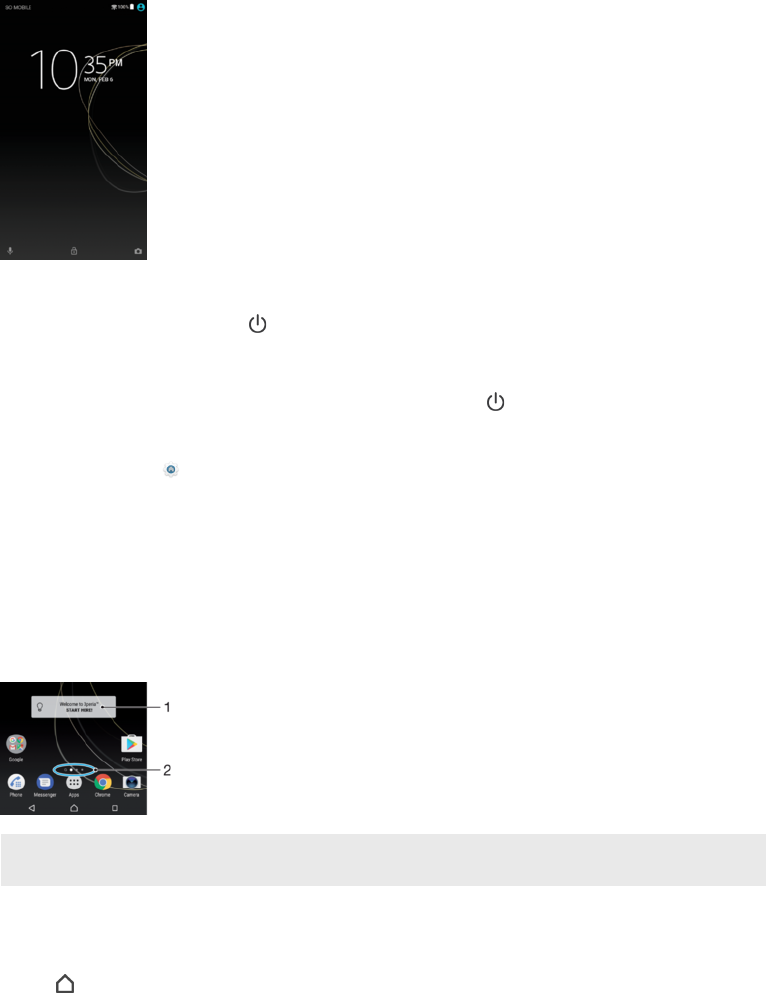
Locking and unlocking the screen
When your device is on and left idle for a set period of time, the screen darkens to
save battery power and locks automatically. This lock prevents unwanted actions on
the touchscreen when you are not using it. When you buy your device, a basic screen
swipe lock is already set. This means that you have to swipe left or upwards on the
screen to unlock it. You can change the security settings later and add other kinds of
locks. See
Screen lock
on page 11.
To activate the screen
•Briefly press the power key .
To lock the screen
1When the screen is active, briefly press the power key .
2Alternatively, double tap any empty area on the Home screen. To enable this
function, touch and hold any area on your Home screen until the device
vibrates, then tap and tap the slider beside Double-tap to sleep.
Home screen
The Home screen is the starting point for using your device. It's similar to the desktop
on a computer screen. Your Home screen can have up to twenty panes, which
extend beyond the regular screen display width. The number of Home screen panes
is represented by a series of dots at the lower part of the Home screen. The
highlighted dot shows the pane that is currently displayed.
1 Welcome to Xperia™ widget — Tap to open the widget and select a task such as copying content
from your old device or setting up Xperia™ services
2 Dots — Represents the number of Home screen panes
To go to the Home screen
•Press .
22
This is an internet version of this publication. © Print only for private use.
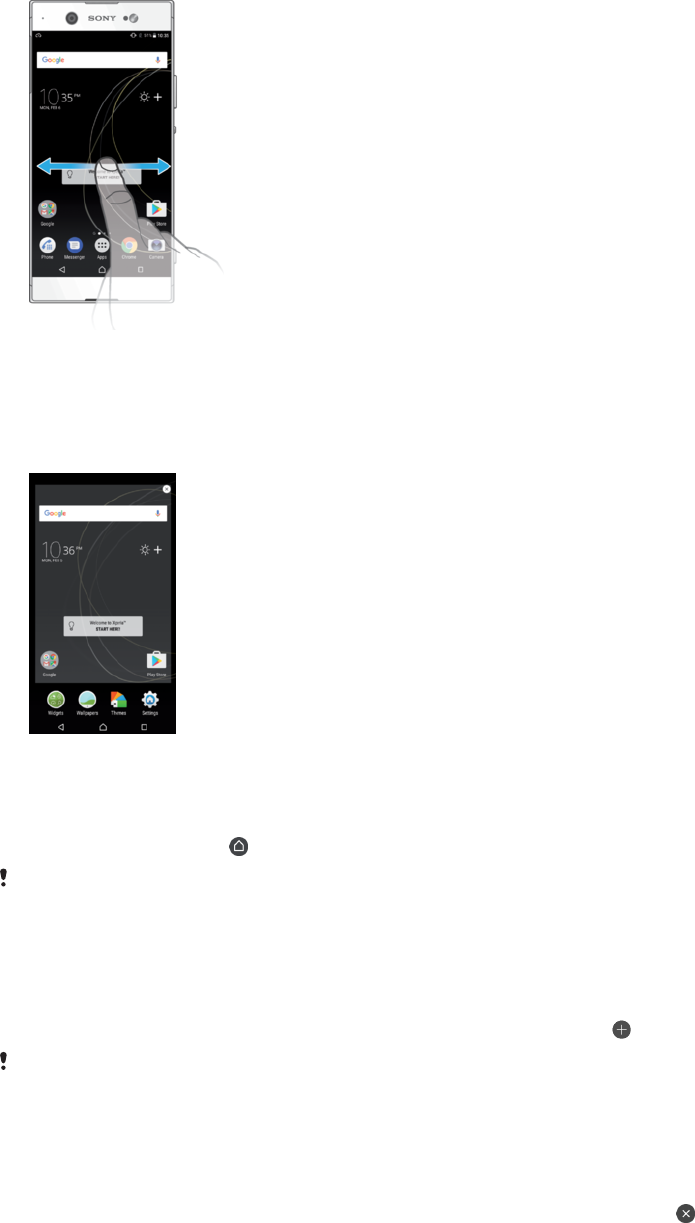
To browse the Home screen
Home screen panes
You can add new panes to your Home screen (up to a maximum of twenty panes)
and delete panes. You can also set the pane that you want to use as the main Home
screen pane.
To set a pane as the main Home screen pane
1Touch and hold any area on your Home screen until the device vibrates.
2Flick left or right to browse to the pane that you want to set as your main Home
screen pane, then tap .
When Google Search & Now is enabled, the left-most pane is reserved for this service and the
main Home screen pane cannot be changed. For more information, see
Google Search & Now
on page 120.
To add a pane to your Home screen
1Touch and hold any area on your Home screen until the device vibrates.
2To browse the panes, flick all the way to the right or left, then tap .
When Google Search & Now is enabled, the left-most pane is reserved for this service and
additional panes cannot be added to the left. For more information, see
Google Search & Now
on page 120.
To delete a pane from your Home screen
1Touch and hold any area on your Home screen until the device vibrates.
2Flick left or right to browse to the pane that you want to delete, then tap on
the top right corner of the pane.
23
This is an internet version of this publication. © Print only for private use.

Home screen settings
To disable or uninstall an application from the Home screen
Disabling a pre-installed app deletes all data, but the app can be enabled again from Settings
> Apps. Only downloaded apps can be fully uninstalled.
1Touch and hold any area on your Home screen until the device vibrates.
2Flick left or right to browse the panes. All applications that can be disabled or
uninstalled are indicated by .
3Tap the relevant application, then tap DISABLE if the app came pre-installed
on your device or OK if the app was downloaded and you would like to
uninstall it.
To adjust the size of icons on your Home screen
1Touch and hold any area on your Home screen until the device vibrates, then
tap .
2Tap Icon size, then select an option.
Application screen
The Application screen, which you open from the Home screen, contains the
applications that come pre-installed on your device as well as applications that you
download.
To view all applications on the Application screen
1From your Home screen, tap .
2Flick left or right on the Application screen.
To enable or disable the recommended apps listings
The first time you access the application screen you get the option to enable or
disable recommended apps listings. You can also enable or disable this feature later
by following the steps below:
1Touch and hold any area on your Home screen until the device vibrates, then
tap .
2Tap the App recommendations slider.
To open an application from the Application screen
•When the Application screen is open, flick left or right to find the application,
and then tap the application.
To search for an application from the Application screen
1When the Application screen is open, tap Search applications or simply swipe
down on the Application screen or Home screen.
2Enter the name of the application that you want to search for.
24
This is an internet version of this publication. © Print only for private use.

To arrange applications on the Application screen
1When the Application screen is open, tap .
2Tap Sort apps, then select an option.
To add an application shortcut to the Home screen
1On the Application screen, touch and hold an application icon until the device
vibrates, then drag the icon to the top of the screen. The Home screen opens.
2Drag the icon to the desired location on the Home screen, then release it.
To move an application on the Application screen
1When the Application screen is open, tap .
2Make sure that Own order is selected under Sort apps.
3Touch and hold the application until the device vibrates, then drag it to the new
location.
To disable or uninstall an application from the Application screen
Disabling a pre-installed app deletes all data, but the app can be enabled again from Settings
> Apps. Only downloaded apps can be fully uninstalled.
1Touch and hold any area on the Application screen until the device vibrates. All
applications that can be disabled or uninstalled are then indicated by .
2Tap the relevant application, then tap DISABLE if the app came pre-installed
on your device or OK if the app was downloaded and you would like to
uninstall it.
Navigating applications
You can navigate between applications using the navigation keys and the recently
used applications window, which lets you switch easily between all recently used
applications. The navigation keys are the Back key, the Home key, and the Recent
apps key. You can also pop open two applications on the screen at once using the
split screen mode, if the application supports multi-window function. Some
applications get closed when you press the Home key to exit while others are
paused or continue to run in the background. If an application is paused or running in
the background, you can continue where you left off the next time you open the
application.
1 Clear all – Close all the recently used applications
2 Recently used applications window – Open a recently used application
3 Recent apps key – Open the recently used applications window and the favourites bar
4 Home key – Exit an application and go back to the Home screen
5 Back key – Go back to the previous screen within an application or close the application
25
This is an internet version of this publication. © Print only for private use.
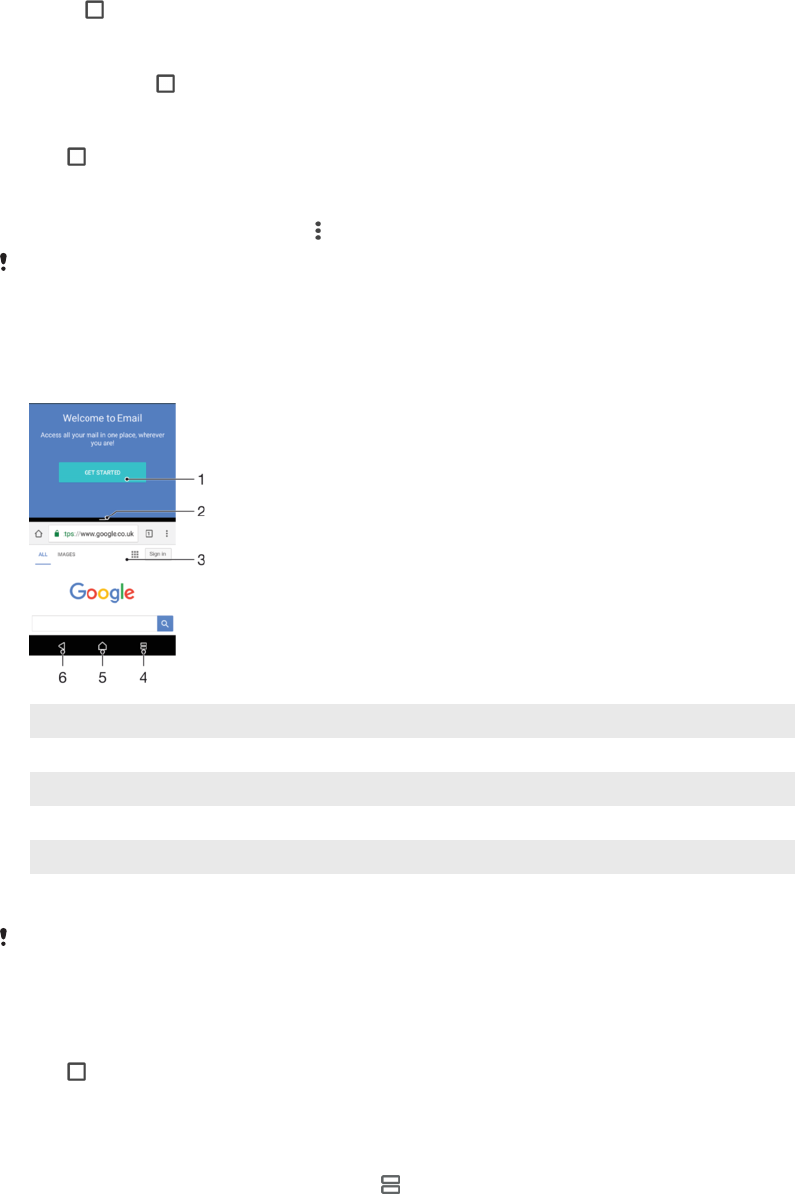
To open the recently used applications window
•Press .
To quickly switch between recently used applications
•Quickly press twice.
To close all the recently used applications
•Tap and then tap CLEAR ALL.
To open a menu in an application
•While using the application, tap .
A menu is not available in all applications.
Split screen mode
Split screen mode enables you to view two applications at once, for example, if you
want to view your email inbox and a web browser at the same time.
1 Application 1 in upper window
2 Split screen border – Drag to resize windows
3 Application 2 in lower window
4 Split screen key – Select a recently used application
5 Home key – Go back to the Home screen
6 Back key – Go back to the previous screen within an application or close the application
Not all applications support split screen mode.
To use split screen mode
1Make sure that the two applications that you want to use in split screen mode
are open and running in the background.
2Tap , and then drag and drop the desired application to the top part of the
screen.
3In the lower part of the screen, tap the second desired application.
4In portrait orientation drag the black bar in the centre up or down to resize the
windows.
5To exit split screen mode, tap and hold .
Widgets
Widgets are small applications that you can use directly on your Home screen. They
also function as shortcuts. For example, the Weather widget allows you to see basic
weather information directly on your Home screen. When you tap the widget, the full
Weather application opens. You can download additional widgets from Google
Play™.
26
This is an internet version of this publication. © Print only for private use.

To add a widget to the Home screen
1Touch and hold any empty area on your Home screen until the device vibrates,
then tap Widgets.
2Find and tap the widget that you want to add.
To resize a widget
1Touch and hold a widget until the device vibrates, then release it. If the widget
can be resized, for example, the Calendar widget, then a highlighted frame and
resizing dots appear.
2Drag the dots inward or outward to shrink or expand the widget.
3To confirm the new size of the widget, tap anywhere on the Home screen.
To move a widget
•Touch and hold the widget until the device vibrates, then drag it to the new
location.
To remove a widget
•Touch and hold the widget until the device vibrates, then drag it to Remove
from home screen.
Shortcuts and folders
Use shortcuts and folders to manage your applications and keep your Home screen
tidy.
1 Access an application using a shortcut
2 Access a folder containing applications
To add an application shortcut to your Home screen
1Touch and hold an empty area on your Home screen.
2In the customisation menu, tap Widgets > Shortcuts.
3Scroll through the list and select an application. The selected application gets
added to the Home screen.
To move an item on the Home screen
•Touch and hold the item until the device vibrates, then drag the item to the new
location.
To remove an item from the Home screen
•Touch and hold the item until the device vibrates, then drag the item to
Remove from home screen on the top of the screen.
To create a folder on the Home screen
•Touch and hold an application icon or a shortcut until the device vibrates, then
drag and drop it on top of another application icon or shortcut.
27
This is an internet version of this publication. © Print only for private use.

To add items to a folder on the Home screen
•Touch and hold an item until the device vibrates, then drag the item to the
folder.
To rename a folder on the Home screen
1Tap the folder to open it.
2Tap the folder's title bar to show the Folder name field.
3Enter the new folder name and tap DONE .
Background and themes
Your device comes with a default background, but you can adapt the Home screen
and Lock screen to your own style using wallpapers and themes featuring different
colours and patterns.
A wallpaper may be used without changing any of the other elements of your Home
screen and Lock screen. Live wallpapers add visual effects to your interactions with
the touch screen, letting the display change dynamically.
Themes can include a wallpaper, a screensaver, title bars, and a sound scheme that
all fit together to create a unique look and feel for your device.
To change your wallpaper
1Touch and hold any empty area on your Home screen until the device vibrates.
2Tap Wallpapers and select an option.
You can also change your Lock screen wallpaper or set the same image for both your Home
screen and Lock screen. Follow the steps above, then tap Album. Tap the desired image and
choose an option.
To set a theme
1Touch and hold an empty area on your Home screen until the device vibrates.
2Tap Themes.
3Choose an option:
•To use an existing theme, select the theme, then tap APPLY THEME.
•To download a new theme, tap GET MORE THEMES.
When you change a theme, the background also changes in some applications.
Taking a screenshot
You can capture still images of any screen on your device as a screenshot.
Screenshots you take are automatically saved in Album.
To take a screenshot
1Press and hold down the power key until a prompt window appears.
2Tap .
You can also take a screenshot by pressing and holding the power key and volume down key
at the same time.
To view your screenshot
1Double-tap the status bar to display the Notification panel.
2Tap the screenshot.
You can also view your screenshots in the Album application.
28
This is an internet version of this publication. © Print only for private use.

Notifications
Notifications inform you of events such as new messages and calendar notifications
as well as activities in progress such as file downloads. Notifications appear in the
following places:
•The status bar
•The Notification panel
•The lock screen
To open or close the Notification panel
1To open the Notification panel, drag the status bar downwards, or simply
double-tap it.
2To close the Notification panel, drag or flick the panel upwards.
After opening the Notification panel, you can access the Quick settings panel by dragging the
status bar down again.
To take action on a notification in the Notification panel
•Tap the notification.
You can directly reply to chat or email messages in the Notification panel.
To dismiss a notification from the Notification panel
•Swipe the notification left or right.
Not all notifications can be dismissed.
To change settings for notifications, simply drag the notification slowly to the left or right, then
tap .
To expand a notification on the Notification panel
•Drag the notification downwards to expand and view more information about
the notification without opening the app.
Not all notifications are expandable.
To clear all notifications from the Notification panel
•Tap CLEAR ALL.
To take action on a notification from the lock screen
•Double-tap the notification.
To dismiss a notification from the lock screen
•Swipe the notification left or right.
29
This is an internet version of this publication. © Print only for private use.

To expand a notification on the lock screen
•Drag the notification downwards.
Not all notifications are expandable.
Managing notifications on the lock screen
Show all
notification content
Get all notifications on the lock screen. When you have this setting turned on, keep
in mind that all content (including the content of incoming emails and chat
messages) will be visible on your lock screen unless you designate the relevant
apps as Hide sensitive content in the App notifications settings menu.
Hide sensitive
notification content
You must have a PIN, password, or pattern set up as your screen lock in order for
this setting to be available. Contents hidden is displayed on the lock screen when
sensitive notifications arrive. For example, you'll get a notification for an incoming
email or chat, but the content won't be visible on your lock screen.
Don't show
notifications at all
You won't get any notifications on the lock screen.
To select the notifications to display on the lock screen
1From your Home screen, tap .
2Find and tap Settings > Notifications.
3Tap , and then tap On the lock screen.
4Select an option.
You can keep notifications on the lock screen until you swipe to dismiss them. To enable this
feature, tap the Keep notifications on lock screen slider.
Setting the notification level for an app
Block all Never receive notifications from the selected app.
Sounds and vibrations off Receive notifications but without sound, vibration or peeking into view.
Interrupts in Priority only Receive notifications from this app even when Do not disturb is set to Priority
only.
To set the notification level for an app
1From your Home screen, tap .
2Find and tap Settings > Notifications.
3Select the desired app.
4Tap the sliders to adjust notification settings as desired.
Notification light
The notification light informs you about battery status and some other events. For
example, a flashing white light means there is a new message or a missed call. The
notification light is enabled by default but can be disabled manually.
When the notification light is disabled, it only lights up when there is a battery status warning,
for example, when the battery level goes below 15 percent.
30
This is an internet version of this publication. © Print only for private use.

To enable or disable the notification light
1From your Home screen, tap .
2Find and tap Settings > Notifications > .
3Tap the slider beside Notification light to enable or disable the function.
Icons in the status bar
Status icon
No SIM card
Signal strength
No signal
Roaming
Sending and downloading LTE data
Sending and downloading GPRS data
Sending and downloading EDGE data
Sending and downloading 3G data
Sending and downloading HSPA+ data
A Wi-Fi connection is enabled and data is being transmitted
A Wi-Fi connection is enabled but there is no internet connection.
This icon also appears when you are trying to connect to a secured Wi-Fi
network. After a successful login, the exclamation mark disappears.
If Google™ is blocked in your area, the exclamation mark may appear even
when the device is connected to a Wi-Fi network and there is a working
internet connection.
Battery status
The battery is charging
Airplane mode is activated
The Bluetooth® function is activated
The microphone is muted
The speakerphone is on
Do not disturb mode is activated
Vibrate mode
An alarm is set
GPS is activated
Synchronisation is ongoing
Problem with sign-in or synchronisation
Depending on your service provider, network or region, the functions or services represented
by some icons in this list may not be available.
31
This is an internet version of this publication. © Print only for private use.

To manage status bar icons
1From your Home screen, tap .
2Find and tap Settings > Display> System icons.
3Mark the checkboxes for the system icons that you want to appear in the
status bar.
Notification icons
New text message or multimedia message
Ongoing call
Missed call
Call on hold
Call forwarding is turned on
New voicemail message
New email message
Downloading data
Uploading data
Mobile data is disabled
Perform a basic setup of your device
A software update is available
System updates are available
Downloading system updates
Tap to install the downloaded system updates
STAMINA mode is activated
Ultra STAMINA mode is activated
Screenshot captured
Video chat with friends using the Duo™ application
A song is playing
The radio is on
The device is connected to a computer via a USB cable
Internal storage is 75% full — tap to transfer data to a memory card
Warning
More undisplayed notifications
Not all icons that may appear on your device are listed here. This list is for reference purposes
only, and changes may be made without notice.
To block an application from sending notifications
1From your Home screen, tap .
2Find and tap Settings > Notifications.
3Select an application.
4Tap the Block all slider.
32
This is an internet version of this publication. © Print only for private use.

Applications overview
Some applications may not be included on your device or may not be supported by all
networks or service providers in all areas.
Use the Album application to manage, view and edit your photos and videos.
Browse, search and buy thousands of products right from your device.
Protect your device against viruses, malware, spyware, phishing attempts and
online exploitation.
Use the Calculator application to perform basic calculations.
Use the Calendar application to keep track of events and manage your
appointments.
Use the Camera to take photos and record video clips.
Use the Chrome web browser to navigate and view web pages, manage
bookmarks, text and images.
Use the Clock application to set various kinds of alarms and timers.
Use the Contacts application to manage phone numbers, email addresses
and other information related to your contacts.
Create, edit and collaborate with others on documents.
Access your downloaded applications, documents and pictures.
Use the Duo™ application to make video calls.
Save your documents and files for easy access from any device, share them
with your friends, and collaborate with colleagues.
Use the Email application to send and receive emails through both personal
and work accounts.
Use the Facebook™ application for social networking with friends, family
members and colleagues around the world.
Browse and listen to FM radio stations.
Use the Gmail™ application to read, write and organise email messages.
Search for information on your device and on the web.
Enjoy music, movies, apps and games on your device, and get exclusive
access to unique content available only with Xperia™ devices.
View your current location, find other locations and plan routes using Google
Maps™.
Use the Messaging application to send and receive text and multimedia
messages.
The Xperia™ Movie Creator automatically creates short video collages using
your existing photo and video collection.
Use the Music application to organise and play music and audio books.
View news stories from News Suite.
Make phone calls by dialling the number manually or by using the smart dial
function.
Organise, search or browse through all your photos and videos.
33
This is an internet version of this publication. © Print only for private use.

Use the Google Play Movies & TV application to watch movies and TV shows
purchased or rented on Google Play.
Discover and play thousands of songs with the Google Play Music
application.
Use the Play Store™ application to find applications to buy or download free.
Stay connected with your gaming friends and the games you love to play,
shop on the PlayStation®Store, and more.
Optimise settings to suit your own requirements.
Create, edit and collaborate with others on spreadsheets.
Use the Sketch application to create and explore images, then share them
with your friends.
Create, edit and collaborate with others on presentations.
Use the Support application to access user support on your device. For
example, you can access a User guide, troubleshooting information, plus tips
and tricks.
Use the Video application to play videos on your device and share content
with your friends.
Search content on the web using your voice.
Use the Weather application to view weather forecasts.
Use the What’s New application to discover new games, apps and media
content.
Use YouTube™ to watch videos from users around the world, and share your
own.
34
This is an internet version of this publication. © Print only for private use.

Battery and maintenance
Charging your device
Always use an original Sony charger and USB Type-C™ cable intended for your specific
Xperia™ model. Other chargers and cables may increase charging time, not charge at all, or
may even damage your device. Make sure all USB ports and connectors are completely dry,
before inserting the USB Type-C™ cable.
A wall socket charger will charge your device faster than charging via your computer.
You can still use your device while charging.
If the battery is depleted, it may take up to 30 minutes for your device to respond to
the charging. During this time, the screen may remain completely dark, not showing
the charging icon. Also note that it can take up to 4 hours for a completely drained
battery to be fully charged.
Your device has an embedded, rechargeable battery that can only be replaced by an
authorised Sony repair centre. You should never try to open or take apart the device yourself.
Doing so can cause damage and void your warranty.
To charge your device
1Plug the charger into a power outlet.
2Plug one end of the USB Type-C™ cable into the charger (or into the USB port
of a computer).
3Plug the other end of the cable into the USB Type-C™ port on your device. The
notification light illuminates when charging begins.
4When the device is fully charged, disconnect the cable from your device by
pulling it straight outwards. Make sure not to bend the connector.
It is important to use the USB Type-C™ cable (provided) when charging your device as other
types of USB cables can damage your device.
If the battery is completely depleted, it may take a few minutes before the notification light
illuminates and the charging icon appears.
35
This is an internet version of this publication. © Print only for private use.

Battery notification light status
Green The battery is charging and the battery charge level is greater than 90%
Orange The battery is charging and the battery charge level is less than 90%
Red The battery is charging and the battery charge level is less than 15%
Battery and power management
Your device has an embedded battery. To get the most use from it, keep track of the
power consumed by different apps and features. Background power saving features
are activated by default to help you reduce battery consumption, and additional
power saving modes are available to help you reduce battery consumption further
when necessary.
Power saving features lower the priority for certain non-essential device functions,
such as higher grade image performance, network activities such as location
services, app synchronisation and background Wi-Fi scanning. If you do not want an
application to be affected, you can exempt it in the Battery optimisation menu. Phone
calls and SMS are not affected.
System updates may change the power saving features available on your device.
To view battery consumption, estimated time, and power saving tips
1From your Home screen, tap .
2Find and tap Settings > Battery. An overview appears showing the battery
percentage and an estimated battery time.
3Tap SHOW BATTERY USAGE to view a list of features and services that have
consumed battery power since the last charging cycle. Tap an item to get
information on how to reduce its battery consumption.
To view battery consumption for applications
1From your Home screen, tap .
2Find and tap Settings > Apps.
3Select an application and review its battery consumption under Battery usage.
General usage tips to improve battery performance
The following tips can help you improve battery performance:
•Lower the screen brightness level, see
Screen settings
on page 58.
•Turn off Bluetooth®, Wi-Fi and location services when you don't need these
features.
•Turn off your device or use Airplane mode if you are in an area with no or low
network coverage. Otherwise, your device repeatedly scans for available
networks, and this consumes power.
•Use a Wi-Fi network instead of roaming when abroad. Roaming is scanning for
your home network and puts additional demands on your battery as your
device must transmit with a higher output power, see
Wi-Fi
on page 47.
•Change the synchronisation settings for your email, calendar and contacts, see
Synchronising with online accounts
on page 54.
•Check the applications that have a high battery consumption and consider the
battery saving tips provided on your device for these applications.
•Change the notification level for an application, see
Notifications
on page 29.
•Turn off the location-sharing permission for an application, see
Application
settings
on page 59.
•Uninstall applications that you are not using, see
Application screen
on
page 24.
•Use a Sony original handsfree device to listen to music. Handsfree devices
consume less battery than your device's loudspeakers.
•Restart your device every now and then.
36
This is an internet version of this publication. © Print only for private use.

To make exceptions to power saving features for apps
1From your Home screen, tap .
2Find and tap Settings > Battery.
3Tap and select Battery optimisation. You will see a list of applications that are
not optimised.
4To add or remove applications from this list, tap APPS and select or de-select
an application from the list to edit its optimisation settings.
5The list of applications that are not optimised will get updated according to
your settings.
You cannot exempt applications from being optimised by Ultra STAMINA mode.
You can also configure Battery optimisation from Settings > Apps > > Special access.
STAMINA mode
Depending on the STAMINA level, different features will be restricted or disabled in
order to reduce battery consumption. These include rendering performance,
animation and screen brightness, image enhancement, background app data
syncing, vibration (except for incoming calls), streaming and GPS (while the screen is
off). appears in the status bar.
If you are sharing a device with multiple users, you may need to log in as the owner, that is, the
primary user, to activate or deactivate STAMINA mode.
To activate or deactivate STAMINA mode
1From your Home screen, tap .
2Find and tap Settings > Battery.
3Tap STAMINA mode and tap the slider to activate or deactivate the function.
When STAMINA mode is activated you can select additional options, for
example you can adjust the Auto-start percentage according to your
preferences.
You can exempt applications from being optimised by STAMINA mode in the Battery
optimisation menu.
Ultra STAMINA mode
Your battery time is extensively prolonged, but available apps are limited and mobile
data and Wi-Fi are disabled. Calling and SMS are still available. Your Home screen is
changed and appears in the status bar.
If you are sharing a device with multiple users, you may need to log in as the owner, that is, the
primary user, to activate or deactivate Ultra STAMINA mode.
To activate Ultra STAMINA mode
1From your Home screen, tap .
2Find and tap Settings > Battery.
3Tap Ultra STAMINA mode and then tap ACTIVATE .
4Confirm to activate.
You cannot exempt applications from being optimised by Ultra STAMINA mode.
To deactivate Ultra STAMINA mode
1Drag down the status bar to access the Notification panel.
2Tap Deactivate Ultra STAMINA mode.
3Tap OK.
Deactivating Ultra STAMINA mode will restart your device.
37
This is an internet version of this publication. © Print only for private use.

Updating your device
You should update the software on your device to get the latest functionality,
enhancements and bug fixes in order to ensure optimal performance. When a
software update is available, appears in the status bar. You can also check for new
updates manually, or schedule an update.
The easiest way to install a software update is to do it wirelessly from your device.
However, some updates are not available for wireless download. You then need to
use the Xperia™ Companion software on a PC or on an Apple® Mac® computer to
update your device.
Before updating your device, consider the following:
•Ensure you have sufficient storage capacity before attempting to update.
•If you are using a device with multiple users, you must log in as the owner, that is, the
primary user, to update the device.
•System and application updates can present the features on your device in another
way than described in this User guide. The Android™ version might not be affected
after an update.
For more information about software updates, go to
www.sonymobile.com/update/
.
To check for new software
1If you are using a device with multiple users, make sure you are logged in as
the owner.
2From your Home screen, tap .
3Find and tap Settings > About phone > Software update.
If no new software is available, it’s possible that you may not have enough free memory on
your device. If your Xperia™ device has less than 500 MB of free internal memory available,
you do not receive any information about new software. In this case you receive a warning in
the Notification panel: “Storage space running out. Some system functions may not work.” If
you receive this notification, you must free up internal memory to get notifications about new
available software.
Updating your device wirelessly
Use the Software update application to update your device software wirelessly. The
updates you can download over a mobile network depend on your operator. It is
recommended to use a Wi-Fi network instead of a mobile network to download new
software so that you can avoid data traffic costs.
To install a system update
1If you are sharing a device with multiple users, make sure you are logged in as
the owner.
2From your Home screen, tap .
3Find and tap Settings > About phone > Software update.
4If a system update is available, tap CONTINUE, then tap INSTALL NOW.
To schedule a system update
1If you are sharing a device with multiple users, make sure you are logged in as
the owner.
2From your Home screen, tap .
3Find and tap Settings > About phone > Software update.
4If a system update is available, tap CONTINUE, then tap the Schedule
installation slider.
5Tap OK > Set time.
6Set the desired time for the software update, then tap OK.
7Your device will be updated at the set time automatically.
38
This is an internet version of this publication. © Print only for private use.

To set up automatic download of system updates
1From your Home screen, tap .
2Find and tap Settings > About phone > Software update.
3Tap , then tap Settings > Auto download system updates.
4Select an option.
To enable or disable automatic updates for applications
1From your Home screen, tap .
2Find and tap Settings > About phone > Software update.
3Tap , then tap Settings > Auto-update apps.
4Select the preferred option.
To update your device using a computer
1Using a USB Type-C™ cable, connect your device to the computer.
2Make sure that the screen of your device is unlocked, and that the USB
connection mode on the device is set to Transfer files.
3Open Xperia™ Companion, if it is not automatically launched.
4Make sure that the computer can access the internet.
5Computer: If a new software update is detected, a popup window appears.
Follow the on-screen instructions to run the relevant software updates.
If you don’t have the Xperia™ Companion software installed on the relevant computer, connect
your device to the computer and follow the on-screen installation instructions. Make sure that
you are using the USB Type-C cable that came with your device and that it is properly
connected to the device and computer.
Maintenance using a computer
Xperia™ Companion
Xperia™ Companion is a software service which provides a collection of tools and
applications you can use when you connect your device to a computer. With Xperia™
Companion, you can:
•Update or repair your device’s software.
•Transfer your content from an old device using Xperia™ Transfer.
•Back up and restore content on your computer.
•Sync multimedia content – photos, videos, music and playlists – between your device
and computer.
•Browse files on your device.
To use Xperia™ Companion, you need an internet-connected computer running one
of the following operating systems:
•Microsoft® Windows® 7 or later
•Mac OS® X 10.11 or later
Learn more and download Xperia™ Companion for Windows at
http://support.sonymobile.com/tools/xperia-companion/ or Xperia™ Companion for
Mac at http://support.sonymobile.com/tools/xperia-companion-mac/.
Managing files using a computer
Use a USB Type-C™ cable connection between a Windows® computer and your
device to transfer and manage your files.
Once the two devices are connected, you can choose whether to charge your device,
transfer files or use it for MIDI input. Your computer will detect your device when you
select the Transfer files connection mode. The default connection mode is set to
Charge this device.
39
This is an internet version of this publication. © Print only for private use.

With Xperia™ Companion you can access the file system of your device. If you do
not have Xperia™ Companion installed, you are requested to install it when you
connect your device to the computer.
Always use the USB cable type intended for your Xperia™ model and make sure it is
completely dry.
USB connection mode
You can use the Transfer files connection mode for managing files and updating
device software. This USB mode is used with Microsoft® Windows® computers.
Charging is enabled by default.
Using the Use device as MIDI mode, your device can function as a MIDI input for
musical instrument apps.
To change USB connection mode
1Attach a USB connector to your device.
2Drag down the Status bar, and then tap Charge this device.
3Tap either Transfer files or Use device as MIDI as desired.
Storage and memory
Your device has several different storage and memory options.
•The internal storage is about 64 GB and is used to store downloaded or transferred
content along with personal settings and data. Some examples of data saved to the
internal storage are alarm, volume and language settings, emails, bookmarks,
calendar events, photos, videos and music.
•You can use a removable memory card with a storage capacity of up to 256 GB to
get more storage space. Media files and some apps, along with their associated data,
can be moved to this type of memory to free up internal storage. Some apps, for
example, the Camera app, can save data directly to a memory card.
•The dynamic memory (RAM) is about 4 GB and cannot be used for storage. RAM is
used to handle running applications and the operating system.
You may have to purchase a memory card separately.
Read more about the use of memory in Android devices by downloading the White paper for
your device at
www.sonymobile.com/support/
.
Improving memory performance
Your device memory tends to fill up as a result of normal usage. If the device starts to
slow down, or applications suddenly shut down, you should consider the following:
•Always try to keep at least 500 MB of free internal storage available.
•Close running applications that you are not using.
•Clear the cache memory for all applications.
•Uninstall downloaded applications that you don't use.
•Move applications to the memory card if the internal storage is full.
•Transfer photos, videos and music from the internal memory to the memory card.
40
This is an internet version of this publication. © Print only for private use.

•If your device can't read content on the memory card, you may need to format the
card. Note that all content on the card gets erased when you format it.
If you are sharing a device with multiple users, you must log in as the owner, that is, the
primary user, to be able to perform certain actions, such as transferring data to the memory
card and formatting the memory card.
To view the memory status
1From your Home screen, tap .
2Find and tap Settings > Storage & memory.
To view the amount of free and used RAM
1From your Home screen, tap .
2Find and tap Settings > Storage & memory.
3Tap , then tap Advanced > Memory.
To clear the cache memory for all applications
1From your Home screen, tap .
2Find and tap Settings > Storage & memory.
3Tap , then tap Advanced > Storage, then find and tap Cached data > OK. If
you have a memory card inserted, select Internal shared storage after tapping
Storage.
When you clear the cache memory, you don't lose any important information or settings.
To transfer media files to the memory card
1Make sure you have a memory card inserted into your device.
2From your Home screen, tap .
3Find and tap Settings > Storage & memory > Transfer data.
4Mark the files that you want to transfer to the memory card.
5Tap Transfer.
To stop applications and services from running
1From your Home screen, tap .
2Find and tap Settings > Apps.
3Select an application or service, then tap FORCE STOP > OK.
To format the memory card
1From your Home screen, tap .
2Find and tap Settings > Storage & memory.
3Tap , then tap Advanced > Storage > SD Card > , then tap Settings > Format
> Erase & format.
All content on the memory card gets erased when you format it. Make sure you first make
backups of all data that you want to save. To back up your content, you can copy it to a
computer. For more information, see
Managing files using a computer
on page 39.
Smart cleaner
Using Smart cleaner you can improve device performance by automatically
optimising storage and memory depending on frequency of app use.
To enable or disable Smart cleaner
1From your Home screen, tap .
2Find and tap Settings > Storage & memory.
3Tap the slider beside Smart cleaner.
You can also modify, copy or delete files manually if you go to Settings > Storage & memory >
> Advanced > Storage > Explore
41
This is an internet version of this publication. © Print only for private use.

Backing up and restoring content
Generally, you should not save photos, videos and other personal content solely on
the internal memory of your device. If your device is damaged, lost or stolen, the data
stored on its internal memory may be impossible to recover. It is recommended to
use the Xperia™ Companion software to make backups which save your data safely
to an external device. This method is especially recommended if you are updating
your device software to a newer Android version.
The Xperia™ Backup & restore application is recommended for backing up data
before you do a factory data reset. With this application you can back up data to an
online account, an SD card or to an external USB storage device that you have
connected to your device using a USB host adapter.
With the Google Backup & restore application, you can back up data to a Google
server.
Backing up data to a computer
Use the Xperia™ Companion software to back up data from your device to a PC or
an Apple® Mac® computer. You can back up the following types of data:
•Call logs
•Text messages
•Calendar
•Settings
•Media files such as music and videos
•Photos and images
To back up your data using a computer
1Unlock the screen of your device and connect it to the computer using a USB
Type-C™ cable.
2Open the Xperia™ Companion software on your computer if it is not
automatically launched. After a few moments, the computer detects your
device. Make sure to select Transfer files mode on your device.
3Click on Backup on the Xperia™ Companion main screen.
4Follow the on-screen instructions to back up data from your device.
If you do not have Xperia™ Companion installed, you are requested to install it when you
connect your device to the computer.
To restore your data using a computer
1Unlock the screen of your device and connect it to the computer using a USB
Type-C™ cable.
2Open the Xperia™ Companion software on your computer if it is not
automatically launched. After a few moments, the computer detects your
device. Make sure to select Transfer files mode on your device.
3Click on Restore on the Xperia™ Companion main screen.
4Select a backup file from the backup records, then click on Next and follow the
on-screen instructions to restore data to your device.
If you do not have Xperia™ Companion installed, you are requested to install it when you
connect your device to the computer.
Backing up data with the Xperia™ Backup & restore application
Using the Xperia™ Backup & restore application, you can make an online or a local
data backup. You can do so manually or turn on the automatic backup function to
save data periodically.
The Xperia™ Backup & restore application is recommended for backing up data
before you do a factory data reset. With this application you can back up the
following types of data to an online account, an SD card or to an external USB
storage device that you have connected to your device using a USB host adapter:
42
This is an internet version of this publication. © Print only for private use.

•Contacts
•Conversations
•Call log
•Calendar
•Email accounts
•Wi-Fi accounts
•Device settings
•Applications
•Xperia™ Home layout
To set up the automatic backup function
1If you are backing up content to a USB storage device, make sure the storage
device is connected to your device using a USB host adapter. If you are
backing up to an SD card, make sure that the SD card is mounted properly into
your device. If you are backing up content to an online account, make sure you
have signed in to your Google ™ account.
2From your Home screen, tap .
3Find and tap Settings > Backup & reset.
4Under Xperia™ Backup & Restore, tap Automatic backup.
5To enable the automatic backup function, tap the on-off switch.
6Select where to save backup files.
7If desired, select a backup frequency, when to back up and the specific data to
back up. Otherwise the backup is completed according to the default settings.
8To save your settings, tap .
To back up content manually
1If you are backing up content to a USB storage device, make sure the storage
device is connected to your device using a USB host adapter. If you are
backing up to an SD card, make sure the SD card is properly inserted into your
device. If you are backing up content to an online account, make sure you have
signed in to your Google ™ account.
2From your Home screen, tap .
3Find and tap Settings > Backup & reset.
4Under Xperia™ Backup & Restore, tap More.
5Tap Manual backup, then select a backup destination and the data that you
want to back up.
6Tap Back up.
7After the data is backed up, tap Finish.
To edit a backup file
1From your Home screen, tap .
2Find and tap Settings > Backup & reset.
3Under Xperia™ Backup & Restore, tap More.
4Tap Edit backup file, then select a backup source and the data types that you
want to delete.
5Tap Delete data.
6Tap OK to confirm.
7After the data is deleted, tap Finish.
43
This is an internet version of this publication. © Print only for private use.

To restore backed up content
1If you are restoring content from a USB storage device, make sure that the
storage device is connected to your device using the USB Host adapter. If you
are restoring content from an SD card, make sure that the SD card is properly
inserted into your device. If you are restoring content from Xperia Backup &
Restore service, make sure you have signed in to your Google™ account.
2From your Home screen, tap .
3Find and tap Settings > Backup & reset.
4Under Xperia™ Backup & Restore, tap Restore data, then select a restore
source and the data that you want to restore.
5Tap Restore data.
6After the content is restored, tap Finish.
Remember that any changes that you make to your data and settings after you create a
backup - such as any new apps you install - get deleted during any subsequent restore
procedure.
Backing up data with the Google Backup & restore application
Using the Google Backup & restore application, you can back up data to a Google
server. You can also turn on the automatic restore function to restore application data
and settings when you reinstall an application.
With this application you can back up the following types of data:
•Applications
•Bookmarks
•Wi-Fi networks
•Other settings
To back up data to a Google™ account
1From your Home screen, tap .
2Find and tap Settings > Backup & reset.
3Under Google™ Backup & Restore, tap Back up my data and then tap the
slider.
To enable or disable automatic restore when you reinstall an application
1From your Home screen, tap .
2Find and tap Settings > Backup & reset.
3Under Google™ Backup & Restore, tap the Automatic restore slider.
44
This is an internet version of this publication. © Print only for private use.

Downloading applications
Downloading applications from Google Play™
Google Play™ is the official online Google store for downloading applications,
games, music, movies and books. It includes both free and paid applications. Before
you start downloading from Google Play™, make sure that you have a working
internet connection, preferably over Wi-Fi to limit data traffic charges.
To use Google Play™, you need to have a Google™ account. Google Play™ may not be
available in all countries or regions.
To download an application from Google Play™
1From the Home screen, tap .
2Find and tap Play Store.
3Find an item you wish to download by browsing categories, or by using the
search function.
4Tap the item to view its details, and follow the instructions to complete the
installation.
Some applications may need to access data, settings and various functions on your device in
order to work properly. Only install and give permissions to applications that you trust. You can
view the permissions granted to a downloaded application and also change their status by
tapping the application under Settings > Apps.
Downloading applications from other sources
When your device is set to allow downloads from sources other than Google Play™,
you can download applications directly from other websites by following the relevant
download instructions.
Installing applications of unknown or unreliable origin can damage your device. Download
applications only from reliable sources. Contact the application provider if you have any
questions or concerns.
If you are using a device with multiple users, only the owner, that is, the primary user, can
allow downloads from sources other than Google Play™. Changes made by the owner affect
all other users.
To enable or disable the downloading of applications from other sources
1From your Home screen, tap .
2Find and tap Settings > Lock screen & security.
3Tap the Unknown sources slider.
4Tap OK.
Some applications may need to access data, settings and various functions on your device in
order to work properly. Only install and give permissions to applications that you trust. You can
view the permissions granted to a downloaded application and also change their status by
tapping the application under Settings > Apps.
45
This is an internet version of this publication. © Print only for private use.

Internet and networks
Browsing the web
The Google Chrome™ web browser for Android™ devices comes pre-installed in
most markets. Go to http://support.google.com/chrome and click the "Chrome for
Mobile" link to get more detailed information about how to use this web browser.
To browse the web
1From your Home screen, tap .
2Find and tap .
3If you are using Google Chrome™ for the first time, select to either sign in to a
Google™ account or browse with Google Chrome™ anonymously.
4Enter a search term or web address in the search and address field, then tap
on the keyboard.
Internet and MMS settings
To send multimedia messages, or to access the internet when there is no available
Wi-Fi network, you must have a working mobile data connection with the correct
internet and MMS (Multimedia Messaging Service) settings. Here are some tips:
•For most mobile networks and operators, internet and MMS settings come pre-
installed on your device. You can then start using the internet and send multimedia
messages right away.
•It is possible to download these settings via Wi-Fi.
•You can manually add, change or delete internet and MMS settings on your device at
any time. If you change or delete an internet or MMS setting by mistake, download
the internet and MMS settings again.
•If you cannot access the internet over a mobile network or if multimedia messaging is
not working, even though the internet and MMS settings have been downloaded
successfully to your device, refer to the troubleshooting tips for your device at
www.sonymobile.com/support/
for network coverage, mobile data, and MMS issues.
•If the Battery time preferred setting of STAMINA mode is activated to save power, all
mobile data traffic gets paused when the screen is off. If this causes connection
problems, try excluding some applications and services from being paused, or
deactivate STAMINA mode temporarily.
•If you are sharing a device with multiple users, only the owner, that is, the primary
user, can download internet and messaging settings from the Settings menu, but the
downloaded settings are applicable to all users.
To download internet and MMS settings
1From your Home screen, tap .
2Find and tap Settings > More > Internet settings.
3Tap ACCEPT. Once the settings have been downloaded successfully,
appears in the status bar and mobile data traffic is turned on automatically.
If the settings cannot be downloaded to your device, check the signal strength of your mobile
or Wi-Fi network connections. Move to an open location free from obstructions or get close to
a window and then try again.
46
This is an internet version of this publication. © Print only for private use.

To add internet and MMS settings
1From your Home screen, tap .
2Find and tap Settings > More > Mobile networks.
3Select a SIM card.
4Tap Access Point Names > .
5Tap Name and enter a name of your choice, then tap OK.
6Tap APN and enter the access point name, then tap OK.
7Enter all other required information. If you don’t know what information is
required, contact your network operator for more details.
8When you're done, tap , then tap Save.
To view downloaded internet and MMS settings
1From your Home screen, tap .
2Find and tap Settings > More > Mobile networks.
3Select a SIM card.
4Tap Access Point Names.
5To view more details, tap any of the available items.
Wi-Fi
Use Wi-Fi to surf the internet, download applications, or send and receive emails.
Once you have connected to a Wi-Fi network, your device remembers the network
and automatically connects to it the next time you come within range.
Some Wi-Fi networks require you to log in to a web page before you can get access.
Contact the relevant Wi-Fi network administrator for more information.
Available Wi-Fi networks may be open or secured:
•Open networks are indicated by next to the Wi-Fi network name.
•Secured networks are indicated by next to the Wi-Fi network name.
Some Wi-Fi networks do not show up in the list of available networks because they do not
broadcast their network name (SSID). If you know the network name, you can add it manually
to your list of available Wi-Fi networks.
To turn Wi-Fi on or off
1From your Home screen, tap .
2Find and tap Settings > Wi-Fi.
3Tap the slider to enable or disable Wi-Fi.
It may take a few seconds before Wi-Fi is enabled.
To connect to a Wi-Fi network
1From your Home screen, tap .
2Find and tap Settings > Wi-Fi.
3Tap the slider to turn on Wi-Fi. All available Wi-Fi networks are displayed.
4Tap a Wi-Fi network to connect to it. For secured networks, enter the relevant
password. is displayed in the status bar once you are connected.
To search for new available networks, tap , then tap Refresh. If you cannot connect to a Wi-Fi
network successfully, refer to the relevant troubleshooting tips for your device at
www.sonymobile.com/support/
.
47
This is an internet version of this publication. © Print only for private use.

To add a Wi-Fi network manually
1From your Home screen, tap .
2Find and tap Settings > Wi-Fi.
3Scroll down and tap at the end of the listed items.
4Enter the Network name (SSID) information.
5To select a security type, tap the Security field.
6If required, enter a password.
7To edit advanced options such as proxy and IP settings, tap Advanced options
and then edit the options as desired.
8Tap SAVE.
Contact your Wi-Fi network administrator to get the network SSID and password.
Increasing Wi-Fi signal strength
There are a number of things you can do to improve Wi-Fi reception:
•Move your device closer to the Wi-Fi access point.
•Move the Wi-Fi access point away from any potential obstructions or interference.
•Don’t cover the Wi-Fi antenna area of your device (the highlighted area in the
illustration).
Wi-Fi settings
When you are connected to a Wi-Fi network or when there are Wi-Fi networks
available in your vicinity, you can view the status of these networks. You can also
enable your device to notify you whenever an open Wi-Fi network is detected.
To enable or disable Wi-Fi network notifications
1Turn on Wi-Fi , if it is not already on.
2From your Home screen, tap .
3Find and tap Settings > Wi-Fi.
4Tap , then tap the Network notification slider.
To view detailed information about a connected Wi-Fi network
1From the Home screen, tap .
2Find and tap Settings > Wi-Fi.
3Tap the Wi-Fi network that you are currently connected to. Detailed network
information is displayed.
To add a Wi-Fi sleep policy
1From the Home screen, tap .
2Find and tap Settings > Wi-Fi.
3Tap , then tap Keep Wi-Fi on during sleep.
4Select an option.
48
This is an internet version of this publication. © Print only for private use.

To find the MAC address for your device
1From the Home screen, tap .
2Find and tap Settings > Wi-Fi.
3Tap . The MAC address is displayed in the list.
WPS
WPS (Wi-Fi Protected Setup™) is a wireless networking standard that helps you
establish secure wireless network connections. WPS makes it easy for you to set up
Wi-Fi Protected Access® (WPA) encryption to secure your network. You can also add
new devices to an existing network without entering long passwords.
Use one of these methods to enable WPS:
•Push button method – simply push a button on a WPS-supported device, for
example, a router.
•PIN method – your device creates a random PIN (Personal Identification Number),
which you enter on the WPS-supported device.
To connect to a Wi-Fi network using a WPS button
1From the Home screen, tap .
2Find and tap Settings > Wi-Fi.
3Turn on Wi-Fi if it is not already on.
4Tap , then tap Advanced > WPS Push Button, then press the WPS button on
the WPS-supported device.
To connect to a Wi-Fi network using a WPS PIN
1From your Home screen, tap .
2Find and tap Settings > Wi-Fi.
3Turn on Wi-Fi if it is not already on.
4Tap > Advanced > WPS PIN Entry.
5On the WPS-supported device, enter the PIN that appears on your device.
Sharing your mobile data connection
You can share your mobile data connection with other devices in several ways, listed
below.
•USB tethering: share your mobile data connection with a single computer using a
USB cable.
•Portable Wi-Fi hotspot: share your mobile data connection simultaneously with up to
10 other devices, including devices that support WPS technology.
•One-touch portable hotspot
: touch devices to start sharing your mobile connection over Wi-Fi.
•Bluetooth® tethering: share your mobile data connection with up to four other
devices via Bluetooth®.
To share your data connection using a USB cable
1Connect your device to a computer, using the USB cable that came with it.
2From your Home screen, tap .
3Find and tap Settings > More > Tethering & portable hotspot.
4Tap the USB tethering slider, then tap OK if prompted. is displayed in the
status bar once you are connected.
5To stop sharing your data connection, tap the USB tethering slider or
disconnect the USB cable.
You cannot share your device's data connection and SD card over a USB cable at the same
time.
49
This is an internet version of this publication. © Print only for private use.

To share your mobile data connection with another Bluetooth® device
1Make sure that your device and the other Bluetooth® device are paired with
each other and that mobile data traffic is activated on your device.
2Your device: From your Home screen, tap .
3Find and tap Settings > More > Tethering & portable hotspot and then tap the
Bluetooth tethering slider to enable the function.
4Bluetooth® device: Set up the device so that it obtains its network connection
using Bluetooth®. If the device is a computer, refer to the relevant instructions
to complete the setup. If the device runs on the Android™ operating system,
tap the settings icon beside the name of the device that it is paired with under
Settings > Bluetooth > Paired devices, then mark the Internet access checkbox.
5Your device: Wait for to appear in the status bar. Once it appears, the setup
is complete.
6Tap the Bluetooth tethering slider again to disable the function.
The Bluetooth tethering function is turned off every time you turn off your device or turn off the
Bluetooth® function.
To use your device as a portable Wi-Fi hotspot
1From your Home screen, tap .
2Find and tap Settings > More > Tethering & portable hotspot.
3Tap Portable hotspot settings > Configure hotspot.
4Enter the Network name (SSID) information.
5To select a security type, tap the Security field. If required, enter a password.
6Tap SAVE.
7Tap , then tap the Portable hotspot slider to enable the function.
8If prompted, tap OK to confirm. appears in the status bar once the portable
Wi-Fi hotspot is active.
To allow a WPS-supported device to use your mobile data connection
1Make sure that your device is functioning as a portable hotspot.
2From your Home screen, tap .
3Find and tap Settings > More > Tethering & portable hotspot > Portable hotspot
settings.
4Under Configure hotspot, make sure that your portable hotspot is secured by a
password.
5Enable Discoverable, if it was disabled.
6Tap WPS Push Button, then follow the relevant instructions. Alternatively, tap
> WPS PIN Entry, then enter the PIN that appears on the WPS-supported
device.
To rename or secure your Mobile Hotspot
1From the Home screen, tap .
2Find and tap Settings > More > Tethering & portable hotspot.
3Tap Portable hotspot settings > Configure hotspot.
4Enter the Network name (SSID) information.
5To select a security type, tap the Security field.
6If required, enter a password.
7Tap SAVE.
Controlling data usage
You can keep track of the amount of data transferred to and from your device over
your mobile data or Wi-Fi connection during a given period. For example, you can
view the amount of data used by individual applications. For data transferred over
your mobile data connection, you can also set data usage warnings and limits to
avoid additional charges.
Adjusting data usage settings can help you keep greater control over data usage, but cannot
guarantee the prevention of additional charges.
50
This is an internet version of this publication. © Print only for private use.

To help reduce data usage
1From your Home screen, tap .
2Find and tap Settings > Data usage > Data Saver.
3Tap the slider to enable or disable the function.
To turn data traffic on or off
1From your Home screen, tap .
2Find and tap Settings > Data usage.
3Tap the Mobile data slider to turn data traffic on or off.
When data traffic is turned off, your device can still establish Wi-Fiand Bluetooth®
connections.
To set a data usage warning
1Make sure that mobile data traffic is turned on.
2From your Home screen, tap .
3Find and tap Settings > Data usage > Billing cycle.
4To set the warning level, tap Data warning, enter the desired data limit and tap
SET. You receive a warning notification when the amount of data traffic
reaches the level you set.
To set a mobile data limit
1Make sure that mobile data traffic is turned on.
2From your Home screen, tap .
3Find and tap Settings > Data usage.
4Tap the slider beside Set data limit.
Once your mobile data usage reaches the set limit, mobile data traffic on your device gets
turned off automatically.
To control the data usage of individual applications
1From your Home screen, tap .
2Find and tap Settings > Apps.
3Tap the application that you want to control, then tap Data usage.
The performance of individual applications may be affected if you change the related data
usage settings.
To check your data usage
1From your Home screen, tap .
2Find and tap Settings > Data usage.
3To view information about the amount of data transferred via mobile data
connection, tap Mobile data usage.
4To view information about the amount of data transferred via Wi-Fi connection,
tap the Wi-Fi data usage.
Selecting a SIM card for data traffic
Either of the two SIM cards inserted in your device can handle data traffic, but only
one SIM card can be selected to handle data at any given time. You can select the
SIM card to use for data traffic during the initial setup of your device, or you can
select or change it later via the Settings menu.
To change the SIM card used for data traffic
1From your Home screen, tap .
2Find and tap Settings > Dual SIM > Cellular data.
3Select the SIM card that you want to use for data traffic.
For higher data speeds, select the SIM card that supports the fastest mobile network, for
example, 3G.
51
This is an internet version of this publication. © Print only for private use.

Selecting mobile networks
Your device supports the use of two different networks at the same time. You can
select from the following network mode combinations when two SIM cards are
inserted in your device:
•One WCDMA network
•One GSM network
•One WCDMA and one GSM network
•One LTE, one WCDMA and one GSM network
For each SIM card, you can set your device to switch automatically between mobile
networks depending on which mobile networks are available where you are. Your
device automatically switches between mobile networks depending on which mobile
networks are available where you are. You can also manually set your device to use a
particular mobile network mode for each SIM card, for example, WCDMA or GSM.
Different status icons are displayed in the status bar depending on the type or mode
of network that you are connected to. Refer to
Status icon
on page 31 to see what
the different status icons look like.
To select a network mode
1From your Home screen, tap .
2Find and tap Settings > More > Mobile networks.
3Select a SIM card.
4Tap Preferred network type, then select a network mode.
To select another network manually
1From your Home screen, tap .
2Find and tap Settings > More > Mobile networks.
3Select a SIM card.
4Tap Network operators.
5Tap Search mode, then select Manual.
6Select a network.
If you select a network manually, your device will not search for other networks, even if you
move out of range of the manually selected network.
To activate automatic network selection
1From your Home screen, tap .
2Find and tap Settings > More > Mobile networks.
3Select a SIM card.
4Tap Network operators.
5Tap Search mode, then select Automatic.
Virtual private networks (VPNs)
Use your device to connect to virtual private networks (VPNs), which allow you to
access resources inside a secured local network from a public network. For example,
VPN connections are commonly used by corporations and educational institutions for
users who need to access intranets and other internal services when they are outside
of the internal network, for example, when they are travelling.
VPN connections can be set up in many ways, depending on the network. Some
networks may require you to transfer and install a security certificate on your device.
For detailed information about how to set up a connection to your virtual private
network, contact the network administrator of your company or organisation.
If you are using a device with multiple users, you may need to log in as the owner, that is, the
primary user, to adjust the settings for VPN.
52
This is an internet version of this publication. © Print only for private use.

To add a virtual private network
1From your Home screen, tap .
2Find and tap Settings > More > VPN.
3Tap .
4Select the type of VPN to add.
5Enter your VPN settings.
6Tap SAVE.
To connect to a virtual private network
1From your Home screen, tap .
2Find and tap Settings > More > VPN.
3In the list of available networks, tap the VPN that you want to connect to.
4Enter the required information.
5Tap Connect.
To disconnect from a virtual private network
1Double-tap the status bar to open the Notification panel.
2Tap the notification for the VPN connection to turn it off.
53
This is an internet version of this publication. © Print only for private use.

Synchronising data on your device
Synchronising with online accounts
Synchronise your device with contacts, email, calendar events and other information
from online accounts, for example, email accounts such as Gmail™ and Exchange
ActiveSync, Facebook™ and Flickr™. You can synchronise data automatically for
such accounts by activating the auto-sync function, or you can synchronise each
account manually.
To set up an online account for synchronisation
1From your Home screen, tap .
2Tap Settings > Accounts & sync > Add account, then select the account that
you want to add.
3Follow the instructions to create or sign in to an account.
To synchronise manually with an online account
1From your Home screen, tap > Settings > Accounts & sync.
2Tap the name of the account that you want to synchronise with. A list of items
appears showing what can be synchronised with the account.
3Tap the slider next to the item that you want to synchronise.
To remove an online account
1From your Home screen, tap > Settings > Accounts & sync.
2Select the account type, then tap the account you want to remove.
3Tap , then tap Remove account.
4Tap REMOVE ACCOUNT again to confirm.
Synchronising with Microsoft® Exchange ActiveSync®
If your company uses a Microsoft Exchange ActiveSync account, you can access
your corporate email messages, calendar appointments and contacts directly on your
device. After setup, you can find your information in the Email, Calendar and
Contacts applications.
If you have set up a Microsoft® Exchange ActiveSync® (EAS) account on your Xperia™
device, the EAS security settings may limit the lock screen type to only a PIN or password.
This occurs when your network administrator specifies a lock screen type for all EAS accounts
for enterprise security reasons. Contact the network administrator of your company or
organisation to check what network security policies are implemented for mobile devices.
Fingerprint functionality is not available in the United States.
To set up an EAS account for synchronisation
1From your Home screen, tap .
2Tap Settings > Accounts & sync > Add account > Exchange ActiveSync.
3Enter your corporate email address and password.
4Tap NEXT. If a failure occurs, enter the domain and server details for your
account manually and then tap NEXT.
5Tap OK to allow your corporate server to control your device.
6Select a synchronisation method, a synchronisation interval and the data that
you want to sync with your device.
7Tap NEXT, then select how you want to be notified when a new email arrives.
8Tap NEXT, enter a name for the corporate account, then tap FINISH SETUP.
9If prompted, activate the device administrator to allow your corporate server to
set certain security rules on your device, such as disabling voice recording and
using storage encryption.
54
This is an internet version of this publication. © Print only for private use.

To remove an EAS account
1From your Home screen, tap > Settings > Accounts & sync.
2Tap Exchange ActiveSync, then select the EAS account that you want to
remove.
3Tap , then tap Remove account.
4Tap REMOVE ACCOUNT again to confirm.
55
This is an internet version of this publication. © Print only for private use.

Basic settings
Accessing settings
View and change settings for your device from the Settings menu. The Settings menu
is accessible from both the Application screen and the Quick settings panel.
To open the device settings menu from the Application screen
1From your Home screen, tap .
2Find and tap Settings.
To view information about your device
1From your Home screen, tap .
2Find and tap Settings > About phone.
To access the Quick settings panel
•Drag the status bar downwards using two fingers.
To select which settings to display on the Quick settings panel
1Using two fingers, drag the status bar fully downwards, then tap EDIT.
2To add a setting to the quick settings panel, drag and drop the icon into the
upper part of the screen. To remove a setting, drag and drop the icon into the
lower part of the screen.
To rearrange the Quick settings panel
1Drag the status bar fully downwards, then tap EDIT.
2Touch and hold an icon, then move it to the desired position.
Volume settings
You can adjust the ringtone volume for incoming calls and notifications as well as for
music and video playback.
To adjust the ringtone volume with the volume key
•Press the volume key up or down.
To adjust the media playing volume with the volume key
•When playing music or watching video, press the volume key up or down even
when the screen is locked.
To turn on vibrate mode
•Press the volume key up or down until appears.
To adjust the volume levels
1From your Home screen, tap .
2Find and tap Settings > Sound.
3Drag the volume sliders to the desired positions.
You can also press the volume key up or down and tap to adjust the ringtone, media
playback or alarm volume levels separately.
To set your device to vibrate for incoming calls
1From your Home screen, tap .
2Find and tap Settings > Sound.
3Tap the Also vibrate for calls slider to enable the function.
56
This is an internet version of this publication. © Print only for private use.

To set a ringtone
1From your Home screen, tap .
2Find and tap Settings > Sound > Phone ringtone.
3Select an option from the list or tap and select a music file that is saved on
your device.
4To confirm, tap Done.
To select the notification sound
1From your Home screen, tap .
2Find and tap Settings > Sound > Default notification ringtone.
3Select an option from the list or tap and select a music file that is saved on
your device.
4To confirm, tap Done.
Some applications have their own specific notification sounds, which you can select from the
application settings.
To enable touch tones
1From your Home screen, tap .
2Find and tap Settings > Sound > Other sounds.
3Tap the sliders to enable or disable the different touch tones as desired.
Do not disturb mode
You can set your device to Do not disturb mode and decide how long your device will
be in Do not disturb mode manually. You can also preset when your device will be in
Do not disturb mode automatically.
To activate Do not disturb mode
1Using two fingers, drag the status bar fully downwards to access the Quick
settings panel.
2Find and tap .
3Select an option, then tap Done.
To quickly shift between Do not disturb/Vibrate/Sound mode
1Press the volume key up or down until , or appears.
2Tap or to quickly shift between Vibrate/Sound mode. To activate Do not
disturb mode, press the volume key down when in vibrate mode.
To schedule Do not disturb mode time intervals
1From your Home screen, tap .
2Find and tap Settings > Sound > Do not disturb> Automatic rules.
3Select the time or event to schedule Do not disturb mode for, or add a new
rule.
4Enter the desired name for the rule, then tap OK
5Find and tap Days and mark the checkboxes for the relevant days, then tap
Done.
6To adjust the start time, tap Start time and select a value, then tap OK.
7To adjust the end time, tap End time and select a value, then tap OK. Your
device stays in Do not disturb mode during the selected time interval.
Setting exceptions for Do not disturb mode
You can select which types of notifications are allowed to sound in Do not disturb
mode and you can filter exceptions based on who the notifications come from. The
most common types of exceptions include:
•Events and reminders
•Calls
•Messages
57
This is an internet version of this publication. © Print only for private use.

•Alarms
To associate exceptions with specific contact types
1From the Home screen, tap .
2Find and tap Settings > Sound > Do not disturb > Priority only allows.
3Tap Calls or Messages.
4Select an option.
Screen settings
To adjust the screen brightness manually regardless of lighting condition
1From your Home screen, tap .
2Find and tap Settings > Display and tap the Adaptive brightness slider to
disable this function, if it is not already disabled.
3Tap Brightness level.
4Drag the slider to adjust the brightness.
Lowering the brightness level helps the battery last longer.
To enable or disable vibrate on touch
1From your Home screen, tap .
2Find and tap Settings > Sound > Other sounds.
3Tap the Vibrate on tap slider to enable or disable the function.
To adjust the idle time before the screen turns off
1From your Home screen, tap .
2Find and tap Settings > Display > Sleep.
3Select an option.
To turn off the screen quickly, briefly press the power key .
To adjust the font size
1From your Home screen, tap .
2Find and tap Settings > Display > Font size.
3Select the preferred option.
To adjust the display size
1From your Home screen, tap .
2Find and tap Settings > Display > Display size.
3Drag the slider to select the preferred option.
To adjust the white balance of the display
1From your Home screen, tap .
2Find and tap Settings > Display > White balance.
3Drag the sliders to the desired positions to adjust the white balance.
To revert the white balance setting back to its default values, tap > Default values.
Smart backlight control
The smart backlight control keeps the screen on as long as the device is held in your
hand. Once you put down the device, the screen turns off according to your sleep
setting.
To enable or disable the Smart backlight control function
1From your Home screen, tap .
2Find and tap Settings > Display > Smart backlight control.
3Tap the slider to enable or disable the function.
58
This is an internet version of this publication. © Print only for private use.

Screen pinning
Use screen pinning to set your device to display only the screen for a specific
application. For example, if you are playing a game and you accidentally touch the
Home navigation key, the screen pinning feature prevents the active game app screen
from being minimised. You can also use this feature when you lend your device to
another person to make it harder for them to access more than one application. For
example, you can lend your device to somebody to take a photo and pin the screen
to the Camera application so that the person can't easily use other apps such as
Email.
Screen pinning is not a security feature and does not fully prevent other users from unpinning a
screen and accessing your device. To protect your data, you should set up your device to
request a screen lock PIN, password or pattern before someone can unpin the screen.
To enable or disable screen pinning
1From your Home screen, tap .
2Find and tap Settings > Lock screen & security > Screen pinning.
3Tap the slider to enable or disable the function.
4If you have enabled Screen pinning, you can tap the Require unlock pattern for
unpinning slider to enable or disable this additional security function, as
desired.
A pattern, PIN or password is not mandatory for screen pinning to work.
To pin a screen
1Make sure that screen pinning is activated on your device.
2Open an app and go to the screen that you want to pin.
3Tap .
4To display the screen pinning icon , swipe upwards.
5Tap .
6In the popup window that appears, tap Got it.
To unpin a screen
•On the pinned screen, touch and hold until the screen is unpinned.
If you selected a security option when you activated the screen pinning function, you have to
enter your pattern, PIN or password to unlock the device before the screen can be unpinned.
Application settings
Some apps will ask for permissions once you start using them. You can allow or deny
permissions individually for each app, either from the Settings menu or from the
Permission confirm dialog. Permission requirements depend on the app’s design.
Allowing or denying permissions
You can choose whether to allow or deny permissions when the dialog is shown. If
you have used another Android version previously, most apps will have already been
granted the necessary permissions.
To allow a permission
1To allow a permission, tap Allow.
2When the confirm dialog appears for the second time, you can choose the
Don't ask again option if you wish.
3A dialog will also explain why the app needs the permissions and what it uses
them for specifically. To dismiss this dialog, tap OK.
To deny a permission
•To deny a permission, tap Deny when the dialog is shown.
Some applications can still be used even if you have denied permissions.
59
This is an internet version of this publication. © Print only for private use.

Critical permissions
Some permissions are mandatory for apps to work as intended. In such cases, a
dialog will inform you.
To configure applications
1From your Home screen, tap .
2Find and tap Settings > Apps > .
3Select a configuration option, for example App permissions, then choose an
application that you want to configure.
To allow critical permissions
1To allow a permission, tap Continue > APP INFO > Permission.
2Find the critical permission you need.
3Tap the relevant slider to adjust permissions.
You can also manage permissions in Settings > Apps. Tap an app and change the permissions
as desired.
Application linking
Your device can determine the default app to handle a particular web link. This
means that if the link is set, you don’t need to select an app each time you open a
link. You can change the default app any time you want.
To manage app links from the Settings menu
1From your Home screen, tap .
2Find and tap Settings > Apps.
3Tap and find Opening links.
4Select an app, and adjust the settings as desired.
Resetting your applications
You can reset an application or clear application data if your application stops
responding or causes issues with your device.
To reset application preferences
1From your Home screen, tap .
2Find and tap Settings > Apps.
3Tap , then tap Reset app preferences > Reset apps.
Resetting application preferences does not delete any application data from your device.
To clear application data
1From your Home screen, tap .
2Find and tap Settings > Apps.
3Select an application or service, then tap Storage > CLEAR DATA > OK.
When you clear application data, data for the selected application is deleted from your device
permanently. The option to clear application data is not available for every application or
service.
To clear application cache
1From your Home screen, tap .
2Find and tap Settings > Apps.
3Select an application or service, then tap Storage > CLEAR CACHE.
The option to clear the application cache is not available for every application or service.
60
This is an internet version of this publication. © Print only for private use.

To clear the application default setting
1From your Home screen, tap .
2Find and tap Settings > Apps.
3Select an application or service, then tap Open by default > CLEAR
DEFAULTS.
The option to clear the application default setting is not available for every application or
service.
Screen saver
Set up an interactive screen saver that automatically displays colours, photos or a
slideshow while your device is docked or charging and the screen is idle.
On a device with multiple users, each user can have individual Screen saver settings.
To enable or disable the screen saver
1From your Home screen, tap .
2Find and tap Settings > Display > Screen saver.
3Tap the slider to enable or disable the function.
To select content for the Screen saver
1From your Home screen, tap .
2Find and tap Settings > Display > Screen saver.
3Tap the slider to enable the function.
4Select what you want to display when the screen saver is active.
To start the Screen saver manually
1From your Home screen, tap .
2Find and tap Settings > Display > Screen saver.
3Tap the slider to enable the function.
4To activate the Screen saver immediately, tap , then tap Start now.
Language settings
You can select a default language for your device and change it again at a later time.
You can also change the writing language for text input.
To change the language
1From the Home screen, tap .
2Find and tap Settings > Languages & input > Languages.
3Select a language.
4Select a region.
5Tap OK.
If you select the wrong language and cannot read the menu texts, find and tap . Then select
the text beside and select the first entry in the menu that opens. You can then select the
language you want.
Date and time
You can change the date and time on your device.
61
This is an internet version of this publication. © Print only for private use.

To set the date manually
1From the Home screen, tap .
2Find and tap Settings > Date & time.
3Disable the Automatic date & time function by tapping the slider.
4Tap Set date.
5Flick left or right, or use the arrows to set the desired date.
6Tap OK.
To set the time manually
1From your Home screen, tap .
2Find and tap Settings > Date & time.
3Disable the Automatic date & time function by tapping the slider.
4Tap Set time.
5Select the relevant values for the hour and minute.
6Tap OK.
To set the time zone
1From your Home screen, tap .
2Find and tap Settings > Date & time.
3Disable the Automatic time zone function by tapping the slider.
4Tap Select time zone.
5Select an option.
Super-vivid mode
Super-vivid mode enhances the colour brightness and saturation of your photos and
videos while you view them on your device.
To turn on Super-vivid mode
1From your Home screen, tap .
2Find and tap Settings > Display > Image enhancement.
3Tap the Super-vivid mode radio button if it is not already selected.
Enhancing the sound output
You can enhance the sound of your device by manually enabling individual sound
settings such as Equaliser and Surround sound. You can enable the Dynamic
normaliser to minimise volume differences between songs or videos. You can also
improve the quality of compressed music files to near High-resolution Audio quality
when you are using a wired headphone.
To enhance the sound output automatically
1From your Home screen, tap .
2Find and tap Settings > Sound > Audio settings.
3Enable the ClearAudio+ function by tapping the slider.
To adjust the sound settings manually
1From the Home screen, tap .
2Find and tap Settings > Sound > Audio settings.
3If the ClearAudio+ function is enabled, tap the slider to disable it.
4Tap Sound effects > Equaliser.
5Adjust the sound settings by dragging the frequency band buttons up or down.
The manual adjustment of sound output settings has no effect on voice communication
applications. For example, there is no change in the voice call sound quality.
62
This is an internet version of this publication. © Print only for private use.

To minimise volume differences using the Dynamic normaliser
1From your Home screen, tap .
2Find and tap Settings > Sound > Audio settings.
3Enable the Dynamic normaliser function by tapping the slider.
Noise cancellation
Your device supports noise cancelling headsets. By using a noise cancelling headset
with your device, you can get much clearer audio quality when listening, for example,
to music in a noisy environment, such as on a bus, a train or a plane. You can also
use this feature to create a silent environment in which to study, work or read.
To ensure optimal performance, noise cancelling headsets from Sony are recommended.
To use a noise cancelling headset
1Connect the noise cancelling headset to your device.
2From your Home screen, find and tap > Settings > Sound > Accessory
settings > Noise cancelling, then enable the Noise cancelling function by
tapping the slider.
3Tap Headset/Headphone type, and select the type of your headset/headphone.
4If you want Noise cancelling to be enabled only during music or video playback
or when the screen is active, tap the Power saver mode slider to enable this
function.
5If you want Noise cancelling to be enabled for as long as the headset is
connected, tap the Power saver mode slider to disable this function.
A noise cancelling headset may not be included with your device at purchase.
You can also enable the Noise cancelling function via the Quick settings panel when a noise
cancelling headset is connected to your device.
To adjust the settings to the noise environment
1Make sure a noise cancelling headset is connected to your device.
2From your Home screen, tap .
3Find and tap Settings > Sound > Accessory settings > Noise cancelling > Noise
environment.
4Select the relevant noise environment type, then tap OK.
Multiple user accounts
Your device supports multiple user accounts so that different users can log in
separately to the device and use it. Multiple user accounts work well in situations
where you share the same device with other people or lend your device to someone
to use for a while. The user who sets up the device for the first time becomes the
owner of the device. Only the owner can manage the accounts of other users. Apart
from the owner account, there are two different types of accounts:
•Regular User: This account type is suitable for someone who regularly uses your
device.
•Guest User: Enable the guest account option for someone who just wants to use your
device temporarily.
Some features are only available to the owner. For example, only the owner can allow
downloads from sources other than Google Play™.
About the Regular User account
By adding Regular User accounts, you can allow different users to have different
home screens, wallpapers and general settings. They also get separate access to
applications and memory storage for files such as music and photos. You can add up
to seven regular user accounts on your device.
63
This is an internet version of this publication. © Print only for private use.

To add a regular user account
1Make sure you are logged in as the owner, that is, the user who set up the
device for the first time.
2From your Home screen, tap .
3Find and tap Settings > Users > Add user.
4Tap OK. The new account is created.
5Tap SET UP NOW. The screen locks and an icon representing the newly added
user appears in the top right corner.
6Unlock the screen by swiping upwards.
7Follow the on-screen instructions to set up the account for the user.
You can also add a regular user account from the status bar on any screen. Just drag the
status bar fully downwards and tap the user icon, then tap Add user.
To delete a regular user account from your device
1Make sure you are logged in as the owner.
2From your Home screen, tap .
3Find and tap Settings > Users.
4Tap beside the name of the user that you want to delete, then tap Remove
user > Delete .
About the Guest User account
If someone just wants to use your device temporarily, you can enable a guest
account for this user. In guest mode, your device starts up as a freshly installed
system with only the pre-installed apps. Once your guest is finished using your
device, you can wipe the session clean so that the next guest can start fresh. The
guest user account is pre-installed and cannot be deleted.
To activate the guest user account
1Make sure you are logged in as the owner, that is, the user who set up the
device for the first time.
2From your Home screen, tap .
3Find and tap Settings > Users > Guest.
You can also activate the guest user account from the status bar on any screen. Just drag the
status bar fully downwards and tap the user icon, then tap Add guest.
To clear the guest session data
1Make sure you are logged in to the guest account.
2From your Home screen, tap .
3Find and tap Settings > Users.
4Find and tap Remove guest.
5Tap Remove.
You can also clear the guest session from the status bar on any screen as long as you are
logged in to the guest account. Just drag the status bar downwards and tap the user icon,
then tap Remove guest.
Switching between multiple user accounts
To switch between multiple user accounts
1To view the list of users, drag the status bar downwards, then tap the user icon
at the top right of the screen.
2Tap the icon representing the user account that you want to switch to. The lock
screen for that user account appears.
When you switch to the guest account, tap Start again if you want to wipe the previous
session or tap Yes, continue to continue the previous session.
64
This is an internet version of this publication. © Print only for private use.
Settings for multiple user accounts
There are three different types of settings on devices with multiple users:
•Settings that can be changed by any user and affect all users. Examples include
language, Wi-Fi, Aeroplane mode, NFC and Bluetooth®.
•Settings that only affect an individual user account. Examples include automatic data
syncing, screen lock, various accounts added, and wallpaper.
•Settings that are only visible to the owner and affect all users, for example, VPN
settings.
65
This is an internet version of this publication. © Print only for private use.

Typing text
On-screen keyboards
There are a number of pre-installed text entry providers on your device.
The default text entry provider may depend on the regional or language settings you use. One
or more text entry providers might not be available in your region.
SwitfKey® keyboard
You can enter text using the on-screen keyboard by tapping each letter individually,
or you can use the SwitfKey® flow feature and slide your finger from letter to letter to
form words.
1 Delete a character before the cursor.
2 Tap to enter a carriage return, or touch and hold to access smileys.
3 Enter punctuation.
4 Enter a space.
5 Tap to enter a comma, or touch and hold to enter text using voice input.
6 Display numbers and symbols.
7 Switch between lower case, upper case and all caps.
For more information about SwiftKey®, go to https://swiftkey.com/
Google keyboard overview
You can enter text using the on-screen keyboard by tapping each letter individually,
or you can slide your finger from letter to letter to form words.
1 Tap to delete a character before the cursor.
2 Tap to enter a hard return, access smileys, or search the content. Functionality may depend on text
field type.
3 Tap to enter punctuation.
4 Tap to insert space.
5 Tap to enter a comma.
6 Tap to display numbers and symbols.
7 Tap to switch between lower case, upper case and all caps.
66
This is an internet version of this publication. © Print only for private use.

To display the on-screen keyboard to enter text
•Tap a text entry field.
To use the on-screen keyboard in landscape orientation
•When the on-screen keyboard is displayed, turn the device sideways.
You may need to adjust the settings in some applications to enable landscape orientation.
To enter text character by character
1To enter a character visible on the keyboard, tap the character.
2To enter a character variant, touch and hold a regular keyboard character to
get a list of available options, then select from the list. For example, to enter
"é", touch and hold "e" until other options appear, then, while keeping your
finger pressed on the keyboard, drag to and select "é".
To enter a period
•After you enter a word, double-tap the space bar.
To enter text using the gesture input function
1When the on-screen keyboard is displayed, slide your finger from letter to letter
to trace the word that you want to write.
2After you finish entering a word, lift up your finger. A word suggestion appears
based on the letters that you have traced.
3If the word that you want does not appear, tap to see other options and
select accordingly. If the desired option does not appear, delete the entire word
and trace it again, or enter the word by tapping each letter individually.
Editing text
You can select, cut, copy and paste text as you write. You can access the editing
options by double-tapping the entered text. The editing options then become
available via an application bar.
Text editing bar
After selecting text by double-tapping on a word, an editing bar appears with several
tools available:
•Cut
•Copy
•Paste
•Share
•Select all
•Assist
The Paste option only appears when you have text saved on the clipboard.
To select text
1Double-tap a word to highlight it.
2You can drag the tabs on both sides of the highlighted word to select more
text.
To edit text
1Double-tap a word to make the application bar appear.
2Select the text that you want to edit, then use the application bar to make your
desired changes.
To use the magnifier
•When you enter text, tap and hold on the text field to view the text magnified
and to place the cursor where you want within the text field.
67
This is an internet version of this publication. © Print only for private use.

Calling
Making calls
You can make a call by manually dialling a phone number, by tapping a number
saved in your contacts list, or by tapping the phone number in your call log. You can
also use the smart dial function to quickly find numbers from your contacts list and
call logs by entering part of a contact number or name and selecting from the
suggestions that appear. To make a video call, you can use the Hangouts™ instant
messaging and video chat application on your device.
1 View more options
2 Delete number
3 Dialpad
4 Call button
To open the dialpad
1From your Home screen, tap .
2Find and tap .
3If the dialpad does not appear, tap .
To dial a phone number
1From your Home screen, tap .
2Find and tap .
3If the call log appears, tap to display the dialpad.
4Enter the phone number, and tap .
5Select a SIM card in select account dialog.
To delete a number entered by mistake, tap .
To make a call using smart dial
1From your Home screen, tap .
2Find and tap .
3If the call log appears, tap to display the dialpad.
4Use the dialpad to enter letters or numbers that correspond to the contact you
want to call. As you enter each letter or number, a list of possible matches
appears.
5Tap the contact that you want to call.
6Select a SIM card.
68
This is an internet version of this publication. © Print only for private use.

To make an international call
1From your Home screen, tap .
2Find and tap . The call log is displayed.
3Tap to display the dialpad.
4Touch and hold 0 until a “+” sign appears.
5Enter the country code, the area code without the initial zeros, followed by the
phone number. Then tap .
6Select a SIM card in select account dialog.
To add a direct dial number to your Home screen
1Touch and hold an empty area on your Home screen until the device vibrates
and the customisation menu appears.
2In the customisation menu, tap Widgets > Shortcuts.
3Scroll through the list of applications and select Direct dial.
4Select the contact and the number that you want to use as the direct dial
number.
Showing or hiding your phone number
You can select to show or hide your phone number on call recipients' devices when
you call them.
To show or hide your phone number during outgoing calls
1From the Home screen, tap .
2Find and tap Settings > Call.
3Select a SIM card.
4Tap Additional settings > Caller ID, and choose an option.
This option may not be provided by every operator.
Receiving calls
If you receive an incoming call when the device is in sleep mode or the screen is
locked, the phone application opens in fullscreen format, with a SIM icon indicating
which SIM card the call is for. If you receive an incoming call when the screen is
active, the incoming call is displayed as a floating notification, that is, in a minimised
window that floats at the top of whatever screen is open, with SIM1 or SIM2
indicating which SIM card the call is for. When such a notification arrives, you can
choose to answer the call and open the phone application screen, or you can reject
the call and stay on the current screen.
To answer a call when the screen is inactive
•When a call comes in, drag to the right.
To answer an incoming call when the screen is active
•When a call comes in, in the heads-up notification that appears at the top of
the screen, tap ANSWER.
Instead of answering the call, you can go to the main phone application screen by tapping the
heads-up notification window. Using this method, you get more options to manage the call.
For example, you can decide to reject the call with a message.
To reject a call when the screen is inactive
•When a call comes in, drag to the left.
69
This is an internet version of this publication. © Print only for private use.

To reject a call when the screen is active
•When a call comes in, in the heads-up notification that appears at the top of
the screen, tap DECLINE.
Instead of rejecting the call, you can go to the main phone application screen by tapping the
heads-up notification window. This way you get more options to manage the call. For
example, you can decide to reject the call with a message.
To mute the ringtone for an incoming call
•When you receive the call, press the volume key.
Rejecting a call with a text message
You can reject a call with a text message, sent automatically to the caller and stored
in the Messaging conversation with the contact.
You can select from a number of predefined messages available on your device, or
you can create a new message. You can also create your own personalised
messages by editing the predefined ones.
To reject a call with a text message when the screen is inactive
1When an incoming call arrives, tap RESPONSE OPTIONS.
2Select a predefined message or tap Write new message.
To reject a call with a text message when the screen is active
1When you receive a call, tap the notification window where the phone number
or the name of the contact is displayed.
2Tap RESPONSE OPTIONS.
3Select a predefined message or tap Write new message.
To reject a second call with a text message
1When you hear repeated beeps during a call, tap RESPONSE OPTIONS.
2Select a predefined message or tap Write new message.
To edit the text message used to reject a call
1From your Home screen, tap .
2Find and tap Settings > Call, choose a SIM card, and then tap Reject call with
message.
3Tap the message that you want to edit, then make the necessary changes.
4Tap OK.
Ongoing calls
1 End a call
2 Make a second call
70
This is an internet version of this publication. © Print only for private use.

3 Put the current call on hold or retrieve a call on hold
4 Enter DTMF digits during a call
5 Mute the microphone during a call
6 Turn on the loudspeaker during a call
To change the volume during a call
•Press the volume key up or down.
Using the call log
In the call log, you can view missed calls with or indicating which SIM card the
call was for, received calls and dialled calls .
To open the call log
1From your Home screen, tap .
2Find and tap .
To view your missed calls
1When you have missed a call, appears in the status bar. Drag the status bar
downwards.
2Tap Missed call.
To call a number from your call log
1From your Home screen, tap .
2Find and tap . The call log is displayed.
3To call a number directly from the call log, tap the beside the number, and
select a SIM card. To edit a number before calling, touch and hold the number,
then tap Edit number before call.
To add a number from the call log to your contacts
1From your Home screen, tap .
2Find and tap .
3Tap a number displayed in the call log, then select Create new contact or Add
to Contacts.
4Edit the contact details, then tap .
To view call log options
1From your Home screen, tap .
2Find and tap .
3Tap .
You can also access general call settings by following the steps above.
Forwarding calls
You can direct calls to a different recipient, such as another phone number, another
device or to an answering service. You can also forward calls that come in on SIM
card 1 to SIM card 2 when SIM card 1 is unreachable, and vice versa. This function is
called Dual SIM reachability. You must enable it manually.
To forward calls
1From your Home screen, tap .
2Find and tap Settings > Call.
3Select a SIM card.
4Tap Call forwarding > Voice and select an option.
5Enter the number you want to forward calls to, then tap Turn on.
71
This is an internet version of this publication. © Print only for private use.

To turn off call forwarding
1From your Home screen, tap .
2Find and tap Settings > Call.
3Select a SIM card.
4Tap Call forwarding.
5Select an option, then tap Turn off.
To enable the Dual SIM reachability function
1From your Home screen, tap .
2Find and tap Settings > SIM cards > Dual SIM reachability.
3Under Dual SIM reachability, tap the slider to enable the function.
4Follow the on-screen instructions to complete the procedure.
If the Dual SIM reachability function does not work after you enable it, check that you have
entered the phone numbers correctly for each SIM card. In some cases, the numbers are
detected automatically during setup. Otherwise, you are prompted to enter them manually.
Restricting calls
You can block all or certain categories of incoming and outgoing calls. If you have
received a PIN2 code from your service provider, you can also use a list of Fixed
Dialling Numbers (FDNs) to restrict outgoing calls. If your subscription includes a
voicemail service, you can send all incoming calls from a specific contact directly to
voicemail.
FDN is not supported by all network operators. Contact your network operator to verify if your
SIM card or network service supports this feature.
To block calls and messages from a specific number
1From your Home screen, tap .
2Find and tap > Settings > Block numbers > ADD A NUMBER.
3Enter the phone number you want to block calls and texts from, then tap
BLOCK .
To enable or disable fixed dialling
1From your Home screen, tap .
2Find and tap Settings > Call.
3Select a SIM card.
4Tap Fixed dialling numbers.
5If you want to enable fixed dialling, select Activate fixed dialling. If you want to
disable fixed dialling, select Deactivate fixed dialling.
6Enter your PIN2 and tap OK.
To access the list of accepted call recipients
1From your Home screen, tap .
2Find and tap Settings > Call.
3Tap Fixed dialling numbers > Fixed dialling numbers.
To change the SIM card PIN2
1From the Home screen, tap .
2Find and tap Settings > Call.
3Select a SIM card.
4Tap Fixed dialling numbers > Change PIN2.
5Enter the old SIM card PIN2 and tap OK.
6Enter the new SIM card PIN2 and tap OK.
7Confirm the new PIN2 and tap OK.
72
This is an internet version of this publication. © Print only for private use.

To send incoming calls from a specific contact directly to voicemail
1From your Home screen, tap .
2Find and tap .
3Select the desired contact.
4Tap > .
5Mark the checkbox beside All calls to voicemail.
6Tap SAVE.
Multiple calls
If you have activated call waiting, you can handle multiple calls at the same time.
When it is activated, you will be notified by a beep if you receive another call.
Mobile data is unavailable during calls. Applications like email, internet and social networking
will work if you connect to a Wi-Fi network.
To activate or deactivate call waiting
1From your Home screen, tap .
2Find and tap Settings > Call.
3Select a SIM card.
4Tap Additional settings.
5To activate or deactivate call waiting, tap Call waiting.
To answer a second call and put the ongoing call on hold
1When you hear repeated beeps during a call, drag to the right.
2Tap Hold call.
To reject a second call
•When you hear repeated beeps during a call, drag to the left.
To make a second call
1During an ongoing call, tap . The call log is displayed.
2Tap to display the dialpad.
3Enter the number of the recipient and tap . The first call is put on hold.
To switch between multiple calls
•To switch to another call and put the current call on hold, tap On hold.
Conference calls
With a conference or multiparty call, you can have a joint conversation with two or
more persons.
For details about the number of participants that you can add to a conference call, contact
your network operator.
To make a conference call
1During an ongoing call, tap . The call log appears.
2To display the dialpad, tap .
3Dial the number of the second participant and tap . The first participant is put
on hold temporarily.
4To add the second participant to the call and start the conference call, tap .
5To add more participants to the call, repeat the relevant steps as described
above.
73
This is an internet version of this publication. © Print only for private use.

To have a private conversation with a conference call participant
1During an ongoing conference call, tap Manage conference.
2Tap the separate button of the participant with whom you want to have a
private conversation.
3To end the private conversation and return to the conference call, tap .
To release a participant from a conference call
1During an ongoing conference call, tap Manage conference.
2Tap next to the participant you want to release.
To end a conference call
•During the conference call, tap .
Voicemail
If your subscription includes a voicemail service, callers can leave voice messages for
you when you can't answer calls. Your voicemail service number is normally saved on
your SIM card. If not, you can get the number from your service provider and enter it
manually.
To enter your voicemail number
1From the Home screen, tap .
2Find and tap Settings > Call > Voicemail > Voicemail settings > Voicemail
number.
3Enter your voicemail number.
4Tap OK.
To call your voicemail service
1Open the dialpad.
2Touch and hold 1, then select a SIM card.
The first time you call your voicemail number, your network operator’s voicemail system
normally prompts you to set up your voicemail. For example, you may be asked to record a
greeting and set a password.
Emergency calls
Your device supports international emergency numbers, for example, 112 or 911.
You can normally use these numbers to make emergency calls in any country, with or
without a SIM card inserted if you are within range of a network.
To make an emergency call
1Open the dialpad.
2Enter the emergency number, then tap .
You can make emergency calls even when no SIM card is inserted or when all outgoing calls
are blocked.
To make an emergency call while the SIM card is locked
1Tap EMERGENCY.
2Enter the emergency number and tap .
To make an emergency call while the screen is locked
1If the active screen lock type is Swipe, swipe up and tap , then tap to
display the dialpad, then enter the emergency number and tap .
2If your screen is locked with a pattern, PIN or password, swipe up and tap
Emergency, then enter the emergency number and tap .
74
This is an internet version of this publication. © Print only for private use.

Contacts
Searching and viewing contacts
1 Search for contacts
2 Edit and view medical and emergency contact information
3 View more options
4 Favourites and All contacts tabs
5 View contact details
6 Use the slider to jump to contacts starting with the selected letter
7 Add a contact
To search for a contact
1From your Home screen, tap , then tap .
2Tap and enter a phone number, name or other information in the Find
contacts field. The result list is filtered as you enter each character.
To select which contacts to display in the Contacts application
1From your Home screen, tap , then tap .
2Press , then tap Contacts to display.
3In the list that appears, select the desired option. If you have synchronised your
contacts with a synchronisation account, that account appears in the list.
4To further expand the list of options, tap Customise, select the appropriate
drop-down list and mark or unmark the checkboxes as desired.
5When you’re finished, tap OK.
75
This is an internet version of this publication. © Print only for private use.

Adding and editing contacts
To add a contact
1From your Home screen, tap , then tap .
2Tap .
3If you have synchronised your contacts with one or more accounts and you are
adding a contact for the first time, you must select the account that you want
to add the contact to. Alternatively, tap Phone contact if you only want to use
and save this contact on your device.
4Enter or select the desired information for the contact.
5When you are finished, tap SAVE.
Once you save a contact to an account, that account will show as the default account to save
to the next time you add a contact. If you want to change which account a contact is saved to,
you need to create the contact again and save it to the correct account.
If you add a plus sign and the country code before a contact's phone number, you do not
have to edit the number again when you make calls from abroad.
To edit a contact
1From your Home screen, tap , then tap .
2Tap the contact that you want to edit, then tap .
3Edit the desired information.
4When you are finished, tap SAVE.
Some synchronisation services do not allow you to edit contact details.
To add a picture to a contact
1From your Home screen, tap , then tap .
2Tap the contact that you want to edit, then tap .
3Tap , then select a method for adding the contact picture and edit it as
desired.
4After you add the picture, tap SAVE.
You can also add a picture to a contact directly from the Album application. If you want to add
a picture that is saved to an online account, you must download the picture first.
To personalise the ringtone for a contact
1From your Home screen, tap , then tap .
2Tap the contact that you want to edit, then tap .
3Tap > Set ringtone.
4Select an option from the list or tap to select a music file saved on your
device, then tap DONE.
5Tap SAVE.
To send all calls to voicemail for a contact
1From your Home screen, tap , then tap .
2Tap the contact that you want to edit, then tap .
3Tap , then mark the All calls to voicemail checkbox.
4When you are finished, tap SAVE.
To block a phone number
1From your Home screen, tap , then tap .
2Tap , then tap Blocked numbers.
3Tap ADD A NUMBER, then enter the phone number you want to block calls
and texts from.
4Tap BLOCK.
76
This is an internet version of this publication. © Print only for private use.

To delete contacts
1From your Home screen, tap , then tap .
2Touch and hold the contact that you want to delete.
3To delete several or all contacts, mark the checkboxes beside the contacts that
you want to delete.
4Tap , then tap Delete contact.
5Tap DELETE to confirm.
To edit contact information about yourself
1From your Home screen, tap , then tap .
2Tap ME, then tap .
3Enter the new information or make the changes you want.
4When you are finished, tap SAVE.
To create a new contact from a text message
1From your Home screen, tap , then find and tap .
2Tap the icon next to the phone number, then tap SAVE.
3Select an existing contact, or tap Create new contact.
4Edit the contact information and tap SAVE.
Transferring contacts
There are several ways to transfer contacts to your new device. You can sync
contacts from an online account or import contacts directly from another device.
If you sync the contacts in your old device with an online account, for example,
Google Sync™ or Microsoft® Exchange ActiveSync®, you can transfer your contacts
to your new device using that account.
You can also copy contacts to a memory card, use Bluetooth® technology, or save
contacts to a SIM card. For more specific information about transferring the contacts
from your old device, refer to the relevant User guide.
Find out more about choosing a transfer method at
www.sonymobile.com/support/
.
To synchronise contacts on your new device with a synchronisation account
1From your Home screen, tap , then tap .
2Tap , then tap Manage accounts.
3Select the account that you want to sync your contacts with, then tap > Sync
now.
You need to be signed in to the relevant sync account before you can sync your contacts with
it.
To import contacts from a SIM card
When transferring contacts to or from a SIM card, some contacts may get duplicated at the
destination. For information on how to resolve this, see
Avoiding duplicate entries in the
Contacts application
on page 80.
1From your Home screen, tap , then tap .
2Tap , then tap Import/export.
3Select a SIM card.
4Select where to store your contacts.
5Select contacts to import. To import an individual contact, find and tap the
contact. To import all contacts, tap , then tap Import all.
77
This is an internet version of this publication. © Print only for private use.

To import contacts from a memory card
1From your Home screen, tap , then tap .
2Press , then tap Import/export > Import from SD card or internal storage (.vcf
file).
3Select where to store your contacts.
4Tap SD card.
5Select the files that you want to import by tapping them.
To import contacts using Bluetooth® technology
1Make sure you have the Bluetooth® function turned on and that your device is
set to visible.
2When you are notified of an incoming file to your device, drag the status bar
downwards and tap the notification to accept the file transfer.
3Tap Accept to start the file transfer.
4Drag the status bar downwards. When the transfer is complete, tap the
notification.
5Tap the received file and select where to store your contacts.
Backing up contacts
You can use internal storage, a memory card or a SIM card to back up contacts.
To export all contacts to internal storage
1From your Home screen, tap , then tap .
2Press , then tap Import/export > Export to SD card or internal storage (.vcf file).
3Tap > Show internal storage.
4Tap , then tap your device’s model number beside .
5Select a destination folder or simply tap SAVE.
To export all contacts to a memory card
1From your Home screen, tap , then tap .
2Press , then tap Import/export > Export to SD card or internal storage (.vcf file).
3Tap > SD card.
4Tap SAVE.
To export contacts to a SIM card
When you export contacts to a SIM card, not all information may get exported. This is due to
memory limitations on SIM cards.
1From your Home screen, tap , then tap .
2Tap > Import/export.
3Select a SIM card.
4Tap OK.
Adding medical and emergency contact information
You can add and edit emergency information in the Contacts application. You can
enter medical details, such as allergies and medications that you are using, plus
information about relatives and friends who can be contacted in case of emergency.
After setup, your emergency information can be accessed from the security lock
screen. This means that even if the screen is locked, for example, by a PIN, pattern or
password, emergency personnel can still retrieve your emergency information.
78
This is an internet version of this publication. © Print only for private use.

1 Go back to the main Contacts screen
2 View more options
3 Medical and personal information and emergency contacts tab
4 Medical and personal information
To enter your medical information
1From your Home screen, tap , then tap .
2Tap .
3Edit the desired information.
To add a new emergency contact
1From your Home screen, tap , then tap .
2Tap , then tap CONTACTS > Add contact.
3Tap the contact that you want to use as an emergency contact.
The emergency contact must have at least a phone number which emergency personnel can
call. If your device is locked by a security screen lock, emergency personnel can only see the
phone number of the emergency contact, even if there is other information entered in the
Contacts application.
Favourites
Contacts that you mark as favourites appear under the favourites tab in the Contacts
application along with your most frequently called contacts or "top contacts". This
way you get quicker access to these contacts.
To mark or unmark a contact as a favourite
1From the Home screen, tap , then tap .
2Tap the contact you want to add to or remove from your favourites.
3Tap .
To view your favourite contacts
1From your Home screen, tap , then tap .
2Tap FAVOURITES.
Sending contact information
To send your business card
1From your Home screen, tap , then tap .
2Tap ME.
3Tap , then tap Share.
4Select an available transfer method and follow the on-screen instructions.
79
This is an internet version of this publication. © Print only for private use.

To send a contact
1From your Home screen, tap , then tap .
2Tap the contact whose details you want to send.
3Tap , then tap Share.
4Select an available transfer method and follow the on-screen instructions.
To send several contacts at once
1From your Home screen, tap , then tap .
2Touch and hold a contact then mark or unmark the checkboxes beside the
contacts that you want to share.
3Tap , then tap Share.
4Select an available transfer method and follow the on-screen instructions.
To send all contacts
1From your Home screen, tap , then tap .
2Press , then tap Import/export > Share all contacts to start exporting all your
contacts.
3Drag the status bar downwards. When the export is complete, tap the
notification.
4Select an available transfer method and follow the on-screen instructions.
Avoiding duplicate entries in the Contacts application
If you synchronise your contacts with a new account or import contact information in
other ways, you could end up with duplicate entries in the Contacts application. If this
happens, you can link such duplicates to create a single entry. If you link entries by
mistake, you can unlink them again later.
To link contacts
1From your Home screen, tap , then tap .
2Tap and hold the contact that you want to link with another contact.
3Tick the checkbox beside the contact that you want to link.
4Tap , then tap Link. The information from the first contact is merged with the
second contact, and the linked contacts are displayed as one contact in the
Contacts list.
5Tap LINK to confirm.
To separate linked contacts
1From your Home screen, tap , then tap .
2Tap the linked contact that you want to edit, then tap .
3Tap , then tap Unlink.
4Tap UNLINK to confirm.
80
This is an internet version of this publication. © Print only for private use.
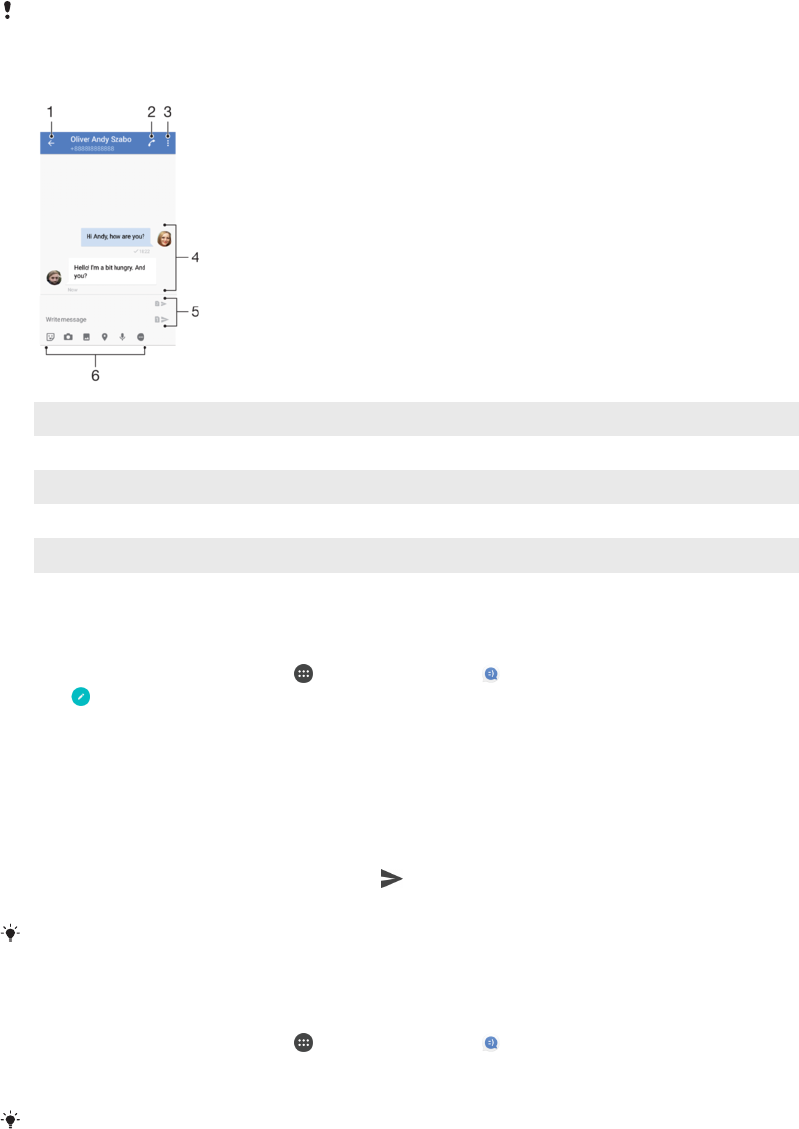
Messaging and chat
Reading and sending messages
The Messaging application shows your messages as conversations, which means
that all messages to and from a particular person are grouped together.
The number of characters that you can send in a single message varies depending on the
operator and the language you use. The maximum size of a multimedia message, which
includes the size of added media files, is also operator dependent. Contact your network
operator for more information.
1 Go back to the list of conversations
2 Call the message sender
3 View more options
4 Sent and received messages
5 Send a completed message
6 Add attachments
To create and send a message
1From your Home screen, tap , then find and tap .
2Tap .
3Enter the recipient’s name or phone number, then select from the suggestions
that appear. If the recipient is not listed as a contact, enter the recipient's
number manually.
4If you want to send a group message, repeat the procedure described above to
add more recipients.
5Tap Write message and enter your message text.
6If you want to add an attachment, select the relevant attachment option.
7To send the message, tap either of the buttons according to which SIM card
you wish to use.
If you exit a message before sending, it gets saved as a draft. The conversation gets tagged
with the word Draft.
To read a received message
1From your Home screen, tap , then find and tap .
2Tap the desired conversation.
3If the message is not yet downloaded, tap it.
All received messages are saved by default to the device memory.
81
This is an internet version of this publication. © Print only for private use.

To reply to a message
1From your Home screen, tap , then find and tap .
2Tap the conversation containing the message.
3Enter your reply and tap either of the buttons according to which SIM card
you wish to use.
To forward a message
1From your Home screen, tap , then find and tap .
2Tap the conversation containing the message that you want to forward.
3Touch and hold the message that you want to forward, then tap Forward
message.
4Enter the recipient’s name or phone number, then select from the suggestions
that appear. If the recipient is not listed as a contact, enter the recipient's
number manually.
5Edit the message if necessary, then tap either of the buttons according to
which SIM card you wish to use.
To save a file contained in a received message
1From your Home screen, tap , then find and tap .
2If the message has not been downloaded yet, tap it.
3Touch and hold the file that you want to save, then select the desired option.
Organising your messages
To delete a message
1From your Home screen, tap , then find and tap .
2Tap the conversation containing the message that you want to delete.
3Touch and hold the message that you want to delete, then tap Delete message
> DELETE.
To delete conversations
1From your Home screen, tap , then find and tap .
2Tap , then tap Delete conversations.
3Mark the checkboxes for the conversations that you want to delete, then tap
> DELETE.
To star a message
1From your Home screen, tap , then find and tap .
2Tap the conversation that you want to open.
3Touch and hold the message that you want to star, then tap Add star.
4To unstar a message, touch and hold the starred message, then tap Delete
star.
To view starred messages
1From your Home screen, tap , then find and tap .
2Tap , then tap Starred messages.
3All starred messages appear in a list.
To search for messages
1From your Home screen, tap , then find and tap .
2Tap .
3Enter your search keywords. The search results appear in a list.
82
This is an internet version of this publication. © Print only for private use.

Calling from Messaging
To call a message sender
1From your Home screen, tap , then find and tap .
2Tap a conversation and tap , then select a SIM card.
To save a sender's number as a contact
1From your Home screen, tap , then find and tap .
2Tap the icon next to the phone number, then tap SAVE.
3Select an existing contact, or tap Create new contact.
4Edit the contact information and tap SAVE.
Messaging settings
To change your message notification settings
1From your Home screen, tap , then find and tap .
2Tap , then tap Settings.
3To set a notification sound, tap Notification sound, then select an option or tap
and select a music file that is saved on your device.
4To confirm, tap DONE.
5To adjust additional notification settings, tap the sliders.
To enable or disable delivery reports for outgoing messages
1From your Home screen, tap , then find and tap .
2Tap , then tap Settings.
3Tap the Delivery report slider to enable or disable the function.
After delivery reports are turned on, a check mark is displayed for messages that have been
successfully delivered.
Video chat
You can use the Google Duo™ video chat application on your device to chat with
friends who also use the application on Android™ and iOS devices.
Go to https://support.google.com/duo/ to get more detailed information about how to
use this application.
The video call function only works on devices with a front camera.
To use the Duo™ application
1From your Home screen, tap .
2Find and tap Duo.
83
This is an internet version of this publication. © Print only for private use.
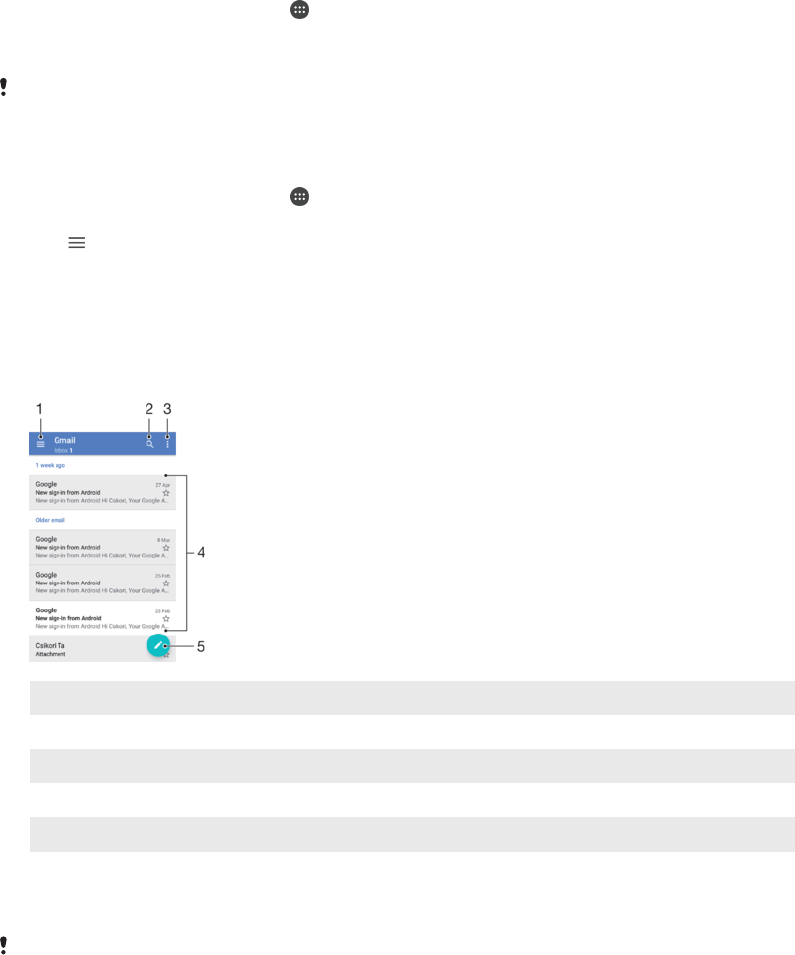
Email
Setting up email
Use the email application on your device to send and receive email messages
through your email accounts. You can have one or several email accounts at the
same time, including corporate Microsoft Exchange ActiveSync accounts.
To set up an email account
1From your Home screen, tap .
2Find and tap Email.
3Follow the instructions that appear on the screen to complete the setup.
For some email services, you may need to contact your email service provider for information
on detailed settings for the email account.
To add an extra email account
1From your Home screen, tap .
2Find and tap Email.
3Tap , then tap Settings > Add account.
4Follow the on-screen instructions. If the settings for the email account cannot
be downloaded automatically, complete the setup manually.
5When you are finished, tap NEXT.
Sending and receiving email messages
1 Access settings, view a list of all email accounts and folders
2 Search for email messages
3 Access other options
4 List of email messages
5 Write an email message
To download new email messages
•When the email inbox is open, swipe downwards on the message list.
Before trying to download new email messages, make sure that you have a working data
connection. For more information about ensuring successful data connections, see
Internet
and MMS settings
on page 46.
84
This is an internet version of this publication. © Print only for private use.

To read your email messages
1From your Home screen, tap .
2Find and tap Email.
3If you are using several email accounts, tap , then tap and select the
account that you want to check. If you want to check all your email accounts at
once, tap , then tap and select Combined inbox.
4In the email inbox, scroll up or down and tap the email message that you want
to read.
To create and send an email message
1From your Home screen, tap , then find and tap Email.
2If you are using several email accounts, tap , then tap and select the
account from which you want to send the email.
3Tap , then type the recipient's name or email address and select one or more
recipients from the drop-down list.
4Enter the email subject and message text, then tap .
To reply to an email message
1In your email inbox, find and tap the message that you want to reply to, then
tap REPLY or REPLY ALL.
2Enter your reply, then tap .
To forward an email message
1In your email inbox, find and tap the message that you want to forward, then
tap FORWARD.
2Enter the recipient's name or email address, then select one or more recipients
from the drop-down list.
3Enter your message text, then tap .
To save or view an email message attachment
1Find and tap the email message containing the attachment that you want to
view. Email messages with attachments are indicated by .
2After the email message opens, find the attachment in the email body, then tap
SAVE or VIEW next to it.
To save a sender's email address to your contacts
1Find and tap a message in your email inbox.
2Tap the name of the sender, tap Add to Contacts then tap OK.
3Select an existing contact, or tap Create new contact.
4Edit the contact information if desired, then tap SAVE.
Organising your email messages
To sort your emails
1From your Home screen, tap .
2Find and tap Email.
3If you are using several email accounts, tap , then tap and select the
account with the inbox that you want to sort. If you want to sort email in all
your email accounts at once, tap , then tap and select Combined inbox.
4Tap , then tap Sort.
5Select a sorting option.
85
This is an internet version of this publication. © Print only for private use.

To search for emails
1From your Home screen, tap , then find and tap Email.
2If you are using several email accounts, tap , then tap and select the
account that you want to search. If you want to search all your email accounts
at once, tap , then tap and select Combined inbox.
3Tap .
4Enter your search text.
5The search results appear in a list sorted by date. Tap the email message that
you want to open.
To view all folders for one email account
1From your Home screen, tap , then find and tap Email.
2Tap , then tap and select the account that you want to check.
3Under the account that you want to check, select Show all folders.
To delete email messages
1Tap and hold the message that you want to delete until the device vibrates.
2Mark the checkboxes for the messages that you want to delete.
3Tap
You can also flick the message to the right to delete it.
To move an email message to another folder
1In your email inbox, flick the message that you want to move to the left.
2Tap Move, then select a folder.
Email account settings
To remove an email account from your device
1From your Home screen, tap .
2Find and tap Email.
3Tap , then tap Settings.
4Select the account you want to remove.
5Tap Delete account > OK.
To change the inbox check frequency
1From your Home screen, tap .
2Find and tap Email.
3Tap , then tap Settings.
4Select the desired account.
5Tap Check frequency > Check frequency and select an option.
To set an Out of Office auto-reply in an Exchange ActiveSync account
1From your Home screen, tap , then find and tap Email.
2Tap , then tap Settings.
3Select the EAS (Exchange ActiveSync) account for which you want to set an
Out of Office auto-reply.
4Tap Out of office.
5Tap the slider to enable the function.
6If needed, mark the Set time range checkbox and set the time range for the
auto-reply.
7Enter your Out of Office message in the body text field.
8Tap OK to confirm.
Gmail™
If you have a Google™ account, you can use the Gmail™ application to read and
write email messages.
86
This is an internet version of this publication. © Print only for private use.

1 View a list of all Gmail accounts and folders
2 Search for email messages
3 List of email messages
4 Write an email message
To learn more about Gmail™
•When the Gmail application is open, tap , then find and tap Help & feedback.
87
This is an internet version of this publication. © Print only for private use.

Music and FM radio
Transferring music to your device
There are two ways to transfer music from a computer to your device:
•You can transfer music files between your device and a computer using the provided
USB Type-C™ cable. After connecting, select Transfer files on your device and then
simply copy and paste or drag and drop the files using the computer. See
Managing
files using a computer
on page 39.
•You can use the Xperia™ Companion software to transfer your media files between
the computer and your device. Learn more and download Xperia™ Companion for
Windows at http://support.sonymobile.com/tools/xperia-companion/ or Xperia™
Companion for Mac at http://support.sonymobile.com/tools/xperia-companion-mac/.
The Music application may not support all music file formats. For more information about
supported file formats and the use of multimedia (audio, image and video) files, download the
White paper for your device at
www.sonymobile.com/support/
.
Listening to music
Use the Music application to listen to your favourite music and audio books.
1 Minimise the full screen player
2 Search all songs saved to your device
3 View the current play queue
4 View menu options
5 Album art (if available)
6 Add or remove a song as a favourite
7 Elapsed time of current song
8 Add a song to a playlist
9 Progress indicator – drag the indicator or tap along the line to fast-forward or rewind
10 Total time length of current song
11 Repeat all songs in the current play queue
12 Tap to go to the next song in the play queue, touch and hold to fast-forward within the current song
13 Play or pause a song
14 Tap to go to the previous song in the play queue, touch and hold to rewind within the current song
15 Shuffle songs in the current play queue
88
This is an internet version of this publication. © Print only for private use.

Music home screen
1Tap in the top left corner to open the Music menu
2 Scroll up or down to view content
3 Play a song using the Music application
4 Play all songs in shuffle mode
5 Return to the music player screen
To play a song using the Music application
1From your Home screen, tap , then find and tap .
2Tap .
3Select a music category.
4Tap a song to play it.
You might not be able to play copyright-protected items. Make sure that you have the
necessary rights for the content you wish to use.
To find song-related information online
•While a song is playing in the Music application, tap the Album art and then tap
More about this.
Online resources related to the song can include videos on YouTube™, song lyrics, and artist
information on Wikipedia.
To edit music information and download album art
1From the Music application, tap the Album art and then tap Edit music info.
2Edit the information as desired.
3To set or download album art, tap , then select an option.
4When you are finished, tap SAVE.
You can also set album art to download automatically in the Music menu, under Settings.
To adjust the audio volume
•Press the volume key up or down.
To minimise the Music application
•When a song is playing, tap to go to the Home screen. The Music
application keeps running in the background.
To open the Music application when it is playing in the background
•While a song is playing in the background, drag the status bar downwards and
tap the Music application.
•Alternatively, from your Home screen, tap , then find and tap .
89
This is an internet version of this publication. © Print only for private use.

Music menu
The Music menu gives you an overview of all the songs on your device. From here
you can manage your albums and playlists.
1 Return to the Music home screen
2 View the current play queue
3 Browse all playlists
4 Browse all artists
5 Browse all albums
6 Browse all songs
7 Browse all genres
8 Browse all folders
9 Open the settings menu for the Music application
10 Open the support menu for the Music application
To open the Music menu
1From your Home screen, tap , then find and tap .
2Tap .
To return to the Music home screen
•When the Music menu is open, tap Home or simply tap on the screen to the
right of the menu.
To delete a song
1From the Music menu, browse to the song that you want to delete.
2Touch and hold the song title, then tap Delete from storage in the list that
appears.
3Tap DELETE to confirm.
You cannot delete a song that is currently playing.
Playlists
On the Music home screen, you can create your own playlists from the music that is
saved on your device.
To create your own playlists
1From the Music home screen, touch and hold the name of the album or song
that you want to add to a playlist.
2In the menu that opens, tap Add to playlist > Create new playlist.
3Enter a name for the playlist and tap OK.
You can also open the Music home screen menu, tap Playlists, then tap to create a new
playlist.
90
This is an internet version of this publication. © Print only for private use.

To play your own playlists
1Open the Music menu, then tap Playlists.
2Under Playlists, select the playlist that you want to open.
3If you want to play all songs, tap any song or Shuffle all.
To add songs to a playlist
1From the Music home screen, browse to the song or album that you want to
add to a playlist.
2Touch and hold the song or the album title, then tap Add to playlist.
3Tap the name of the playlist to which you want to add the album or song. The
album or song is now added to the playlist.
To remove a song from a playlist
1In a playlist, touch and hold the title of the song that you want to remove.
2Tap Remove from playlist.
To delete a playlist
1Open the Music menu, then tap Playlists.
2Touch and hold the playlist that you want to delete.
3Tap DELETE.
4Tap DELETE to confirm.
You cannot delete smart playlists.
Sharing music
To share a song
1From the Music home screen, browse to the song or album that you want to
share.
2Touch and hold the song title, then tap Share.
3Select an application from the list, then follow the on-screen instructions.
You can also share albums and playlists in the same way.
Enhancing the sound
To improve the sound quality using the Equaliser
1Open the Music menu, then tap Settings > Audio settings > Sound effects >
Equaliser.
2Drag the frequency band buttons to adjust the sound manually. To choose a
preset arrangement, tap to select an arrangement, then tap OK to confirm.
To turn on the Surround sound feature
1Open the Music menu, then tap Settings > Audio settings > Sound effects >
Surround sound (VPT).
2Flick left or right to select a setting, then tap OK to confirm.
Listening to the radio
The FM radio in your device works like any FM radio. For example, you can browse
and listen to FM radio stations and save them as favourites. You must connect a
wired headset or headphones to your device before you can use the radio. This is
because the headset or headphones act as an antenna. After one of these devices is
connected, you can then switch the audio to the speaker, if desired.
91
This is an internet version of this publication. © Print only for private use.

1 Favourites list
2 Radio on/off button
3 View menu options
4 Tuned frequency
5 Save or remove a channel as a favourite
6 Tuning dial
7 Frequency band – drag left or right to move between channels
8 Move up the frequency band to search for a channel
9 A saved favourite channel
10 Move down the frequency band to search for a channel
To listen to the FM radio
1Connect a headset or a set of headphones to your device.
2From your Home screen, tap .
3Find and tap . The available channels appear as you scroll through the
frequency band.
When you start the FM radio, available channels appear automatically. If a channel has RDS
information, it appears a few seconds after you start listening to the channel.
To move between radio channels
•Drag the frequency band left or right.
•Alternatively, tap the arrows on either side of the band to jump to the next clear
radio signal.
To start a new search for radio channels
1When the radio is open, tap .
2Tap Search for channels. The radio scans the whole frequency band and marks
all available channels.
To switch the radio sound to the speaker
1When the radio is open, press .
2Tap Play in speaker.
To switch the sound back to the wired headset or headphones, press and tap Play in
headphones.
92
This is an internet version of this publication. © Print only for private use.

Favourite radio channels
To save a channel as a favourite
1When the radio is open, navigate to the channel that you want to save as a
favourite.
2Tap .
3Enter a name and select a colour for the channel, then press SAVE.
To listen to a favourite radio channel
1Tap .
2Select an option.
To remove a channel as a favourite
1When the radio is open, navigate to the channel that you want to remove.
2Tap , then tap DELETE.
Radio sound settings
To switch between mono and stereo sound mode
1When the radio is open, press .
2Tap Enable stereo sound.
3To listen to the radio in mono sound mode again, press and tap Force mono
sound.
To select the radio region
1When the radio is open, press .
2Tap Set radio region.
3Select an option.
93
This is an internet version of this publication. © Print only for private use.
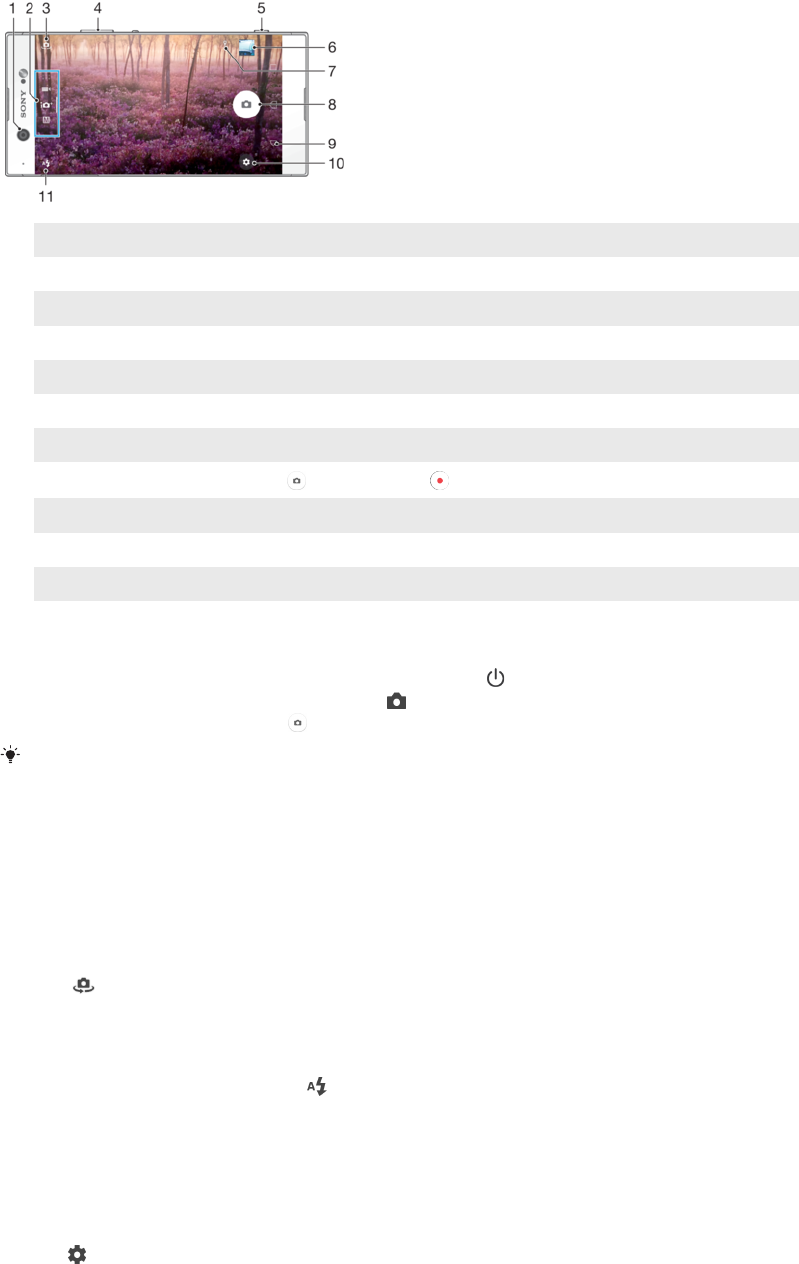
Camera
Taking photos and recording videos
1 Front camera lens
2 Select capturing mode
3 Switch between the front and main camera
4 Zoom in or out
5 Camera key – Activate the camera/Take photos/Record videos
6 View photos and videos
7 Save location
8Shutter button – Take photos or record videos
9 Go back a step or exit the camera
10 Capturing mode settings
11 Flash settings
To take a photo from the lock screen
1To activate the screen, briefly press the power key .
2To activate the camera, touch and hold , then swipe it anywhere.
3After the camera opens, tap .
You can activate the camera when the screen is locked and inactive. To do this, press the
camera key fully. Press again to take a photo.
To take a photo using the camera key
1Activate the camera.
2Press the camera key fully down.
To take a selfie using the front camera
1Activate the camera.
2Tap .
3To take the photo, press the camera key.
To use the still camera flash
1When the camera is open, tap .
2Select your desired flash setting.
3Take the photo.
To use the zoom function
•When the camera is open, pinch or spread on the camera screen.
•You can also use the volume key, pressing up or down. To enable this function,
tap then tap More > Use Volume key as.
94
This is an internet version of this publication. © Print only for private use.

To record a video using the camera key
1Activate the camera.
2Swipe the screen to select .
3To start recording a video, press the camera key.
4To stop recording, press the camera key again.
To record a video
1Activate the camera.
2If video mode is not selected, swipe the screen to select .
3Point the camera towards the subject.
4To start recording, tap .
5To pause when recording a video, tap . To resume recording, tap .
6To stop recording, tap .
To take a photo when recording a video
•To take a photo while recording a video, tap . The photo is taken as soon as
you release the camera button.
To view your photos and videos
1Activate the camera, then tap a thumbnail to open a photo or video.
2Flick left or right to view your photos and videos.
To delete a photo or video
1Find the photo or video that you want to delete.
2Tap the screen to display the toolbar.
3Tap .
4Tap DELETE to confirm.
General camera settings
Capturing modes overview
You can choose from a range of capturing modes and camera apps. Simply swipe
left or right on the camera screen to switch between them.
Manual
Manually adjust camera settings such as resolution, white balance and ISO.
Superior auto
Optimise your settings to suit any scene.
Video camera
Manually adjust video settings to suit any scene.
Camera apps
Select camera applications manually.
To learn more about how to take better photos, go to
support.sonymobile.com
.
Camera apps
AR effect
Take photos or videos with virtual scenes and characters.
Creative effect
Apply effects to photos or videos.
95
This is an internet version of this publication. © Print only for private use.

Sound Photo
Take photos with background sound.
Panorama
Take wide-angle and panoramic photos.
Panorama
You can take wide-angle and panoramic photos with an easy press-and-sweep
motion.
To take a panoramic photo
1Activate the camera.
2Swipe the screen to select , then select .
3Press the camera key and move the camera slowly and steadily in the direction
of movement indicated on the screen.
Auto face detection
The camera automatically detects faces and indicates them with frames. A coloured
frame shows which face has been selected for focus. Focus is set to the face closest
to the centre of the camera. You can also tap one of the frames to select which face
should be in focus.
Auto-capturing
Turn on auto-capturing to take pictures automatically using one of the options below.
Hand Shutter
Turn your palm towards the camera to turn on self-timer and take self-portraits in Manual and Superior
auto capturing modes.
Smile Shutter
Use Smile Shutter™ technology to photograph a face just as it smiles. The camera detects up to five
faces and selects one face for smile detection and auto focus. When the selected face smiles, the
camera automatically takes a photo.
Off
When auto-capturing is off, you can take photos using the shutter button or the camera key.
The Hand Shutter function is available for taking self-portraits only.
To turn on Smile Shutter™
1Activate the camera.
2Tap .
3Find and tap Auto-capturing > Smile Shutter.
4When the camera is open and Smile Shutter is turned on, point the camera at
your subject. The camera selects which face to focus on.
5The face appears inside a coloured frame and the photo is taken automatically
as soon as a smile is detected.
6If no smile is detected, you can press the camera key to take the photo
manually.
To turn on Hand Shutter
1Activate the camera.
2Switch to the front camera by tapping
3Tap .
4Tap More.
5Find and tap Auto-capturing > Hand Shutter.
96
This is an internet version of this publication. © Print only for private use.

Saving a photo's geographic location
Enable the Save location function to geotag your photos - saving the approximate
geographical location as you shoot. The geographical location is determined by
wireless networks and GPS technology.
When appears on the camera screen, Saving location is turned on but the
geographical position has not been found. When appears, Saving location is
turned on and the geographical location is available, so the geographical location can
be added to your photo. When neither of these two symbols appears, Saving location
is disabled.
To turn on geotagging
1Activate the camera.
2Tap .
3Tap More, then tap the slider beside Save location to enable or disable the
function.
4If you are enabling geotagging, you are prompted to enable Location services if
they are not already enabled. Tap OK, then tap the Location slider.
Touch capture
With Touch capture, simply tap anywhere on the camera screen to take a photo.
On
Front camera only
Off
Touch to adjust
Touch the screen to choose an area to focus on while taking pictures.
Focus only
Focus and brightness
This function is available in Superior auto mode only.
Auto photo/video preview
You can choose to preview photos or videos just after you shoot them.
On
After you shoot a photo or a video, a preview of it appears in the lower right corner of the screen for 3
seconds.
Front camera only
After you shoot a photo or video with the front camera, a preview of it appears in the lower right corner of
the screen for 3 seconds.
Off
The photo or video is saved after you shoot it, and no preview appears.
Use Volume key as
You can choose how you want to use the volume key when taking photos.
Zoom
Use the volume key to zoom in or out.
Volume
Use the volume key to adjust the volume of notifications, ringtones and music.
Shutter
Use the volume key to take photos.
97
This is an internet version of this publication. © Print only for private use.

Sound
When you take a photo or start recording a video, the Camera makes a shutter
sound. If you use the self-timer, it will make a series of beeps to mark the countdown.
You can choose to turn these sounds on or off.
Data storage
You can choose to save your data either to a removable SD card or to your device's
internal storage.
Internal storage
Photos or videos are saved on the device memory.
SD card
Photos or videos are saved on the SD card.
Grid lines
You can use grid lines as a visual aid while shooting to help you find the right
composition for your photo.
Grid lines are only shown on the camera screen while shooting, and do not appear in the final
photo.
Quick launch
Use Quick launch settings to launch the camera when the screen is locked.
Launch only
When this setting is activated, you can launch the camera when the screen is locked by pressing and
holding down the camera key.
Launch and capture
When this setting is activated, you can launch the camera and capture a photo automatically when the
screen is locked by pressing and holding down the camera key.
Launch and record video
When this setting is activated, you can launch the camera and start capturing video when the screen is
locked by pressing and holding down the camera key.
Off
To adjust colour and brightness
1Activate the camera.
2Tap > Colour and brightness.
3Drag the sliders to the desired positions to adjust colour and brightness.
This setting is only available in the Superior auto and Video camera modes.
White balance, focus, exposure and shutter speed
White balance, which is only available in Manual capturing mode, adjusts the colour
balance according to the lighting conditions. You can also adjust the exposure
manually in the -2.0 EV to +2.0 EV range. For example, you can increase the image
brightness or decrease the overall exposure by tapping the plus or minus controls
accordingly when is displayed. Focus and shutter speed can be set for either
manual or automatic adjustment.
White balance Auto
Adjust the colour balance automatically.
Incandescent
Adjust the colour balance for warm lighting conditions, such as
under light bulbs.
98
This is an internet version of this publication. © Print only for private use.

Fluorescent
Adjust the colour balance for fluorescent lighting.
Daylight
Adjust the colour balance for sunny outdoor conditions.
Cloudy
Adjust the colour balance for a cloudy sky.
Focus AF Adjust focus automatically.
Focus MF Adjust focus manually.
SS auto Adjust shutter speed automatically.
SS 1/8 Adjust shutter speed manually.
Still camera settings
To adjust the still camera settings
1Activate the camera.
2To display all settings, tap .
3Select the setting that you want to adjust, then edit as desired.
Still camera settings overview
Resolution
Choose between several resolutions and aspect ratios before taking a photo. A photo
with a higher resolution has a higher quality, but requires more memory.
Main camera:
23MP
5520×4140(4:3)
23 megapixel resolution with 4:3 aspect ratio. Suitable for photos you want to view
on non-widescreen displays or print in high resolution.
20MP
5984×3366(16:9)
20 megapixel resolution with 16:9 aspect ratio. Suitable for photos you want to view
on widescreen displays.
12MP
4000×3000(4:3)
12 megapixel resolution with 4:3 aspect ratio. Suitable for photos that you want to
view on non-widescreen displays or print in high resolution.
12MP
4608×2592(16:9)
12 megapixel resolution with 16:9 aspect ratio. Suitable for photos that you want to
view on widescreen displays.
3MP
2048×1536(4:3)
3 megapixel resolution with 4:3 aspect ratio. Suitable for photos you want to view
on non-widescreen displays or print in high resolution. This setting is only available
in Manual capturing mode.
99
This is an internet version of this publication. © Print only for private use.
2MP
1920×1080(16:9)
2 megapixel resolution with 16:9 aspect ratio. Suitable for photos you want to view
on widescreen displays. This setting is only available in Manual capturing mode.
Front camera:
16MP
5344×3008(16:9)
16 megapixel resolution with 16:9 aspect ratio. Suitable for photos that you want to
view on widescreen displays.
12MP
4000×3000(4:3)
12 megapixel resolution with 4:3 aspect ratio. Suitable for photos that you want to
view on non-widescreen displays or print in high resolution.
8MP
3264×2448(4:3)
8 megapixel resolution with 4:3 aspect ratio. Suitable for photos you want to view
on non-widescreen displays or print in high resolution.
8MP
3840×2160(16:9)
8 megapixel resolution with 16:9 aspect ratio. Suitable for photos that you want to
view on widescreen displays.
3MP
2048×1536(4:3)
3 megapixel resolution with 4:3 aspect ratio. Suitable for photos you want to view
on non-widescreen displays or print in high resolution. This setting is only available
in Manual capturing mode.
2MP
1920×1080(16:9)
2 megapixel resolution with 16:9 aspect ratio. Suitable for photos you want to view
on widescreen displays. This setting is only available in Manual capturing mode.
Self-timer
With the self-timer, you can take a photo without holding the device. Use this function
to take self-portraits or group photos with everyone in the photo. You can also use
the self-timer if you want to avoid shaking the camera when taking photos.
10 sec.
Set a 10-second delay in taking the photo from when you tap the shutter button or press the camera key.
3 sec.
Set a 3-second delay in taking the photo from when you tap the shutter button or press the camera key.
Off
The photo is taken as soon as you tap the shutter button or press the camera key.
Soft Skin Effect
You can turn on the Soft Skin Effect on your device to make skin tones slightly
softened while taking selfies in Manual and Superior auto capturing modes.
100
This is an internet version of this publication. © Print only for private use.

Object tracking
When you select an object by touching it in the viewfinder, the camera tracks it for
you.
HDR
Use the HDR (High Dynamic Range) setting to take a photo against strong back light
or in conditions where the contrast is sharp. HDR compensates for the loss of detail
and produces a picture that is representative of both dark and bright areas.
This setting is only available in Manual capturing mode.
ISO
The ISO sensitivity can be set to adjust automatically, or can be manually adjusted to
sensitivity settings ranging from 50 to 3200.
This setting is only available in Manual capturing mode.
Metering
This function automatically determines a well-balanced exposure by measuring the
amount of light striking the subject you want to capture.
Face
Measures the amount of light on your subject’s face, and adjusts the exposure so that the face is neither
too dark nor too bright.
Centre
Determines the centre of the image, and sets the exposure based on the brightness of the subject there.
Spot
Adjusts the exposure in a very small part of the subject that you want to capture.
Touch
Adjusts the exposure to the desired part of the subject when you touch the screen.
This setting is only available in Manual capturing mode.
Flash
Use the flash to take photos when lighting conditions are poor or when there is a
backlight. The following options are available when you tap the flash icon on the
camera screen:
Auto
The camera automatically determines whether the lighting conditions require the use of a flash.
Fill flash
Use this setting when the background is brighter than the subject. This setting removes unwanted
dark shadows.
Red-eye reduction
Reduces the red colour of eyes when taking a photo.
Off
The flash is turned off. Sometimes photo quality can be better without the flash, even if lighting
conditions are poor. Taking a good photo without using the flash requires a steady hand. Use the
self-timer to avoid blurred photos.
Torch
The flash shines continuously while taking pictures.
101
This is an internet version of this publication. © Print only for private use.

Video camera settings
To adjust the video camera settings
1Activate the camera.
2Swipe the screen to select .
3To display settings, tap .
4Select the setting that you want to adjust, then make your changes.
Video camera settings overview
Video resolution
Adjust the video resolution for different formats. HD refers to High Definition, while
FPS refers to Frames Per Second. A higher FPS rate provides a smoother video, at
the cost of a larger file size.
Main camera:
Full HD (30 fps)
1920×1080(16:9)
Full HD (Full High Definition) format with 30 FPS and 16:9 aspect ratio.
HD
1280×720(16:9)
HD (High Definition) format with 16:9 aspect ratio.
VGA
640×480(4:3)
VGA format with 4:3 aspect ratio.
MMS
Record videos suitable for sending in multimedia messages. The recording time of
this format is limited so that the video file can fit in a multimedia message.
Front camera:
Full HD
1920×1080(16:9)
Full HD (Full High Definition) format with 16:9 aspect ratio.
HD
1280×720(16:9)
HD (High Definition) format with 16:9 aspect ratio.
VGA
640×480(4:3)
VGA format with 4:3 aspect ratio.
MMS
Record videos suitable for sending in multimedia messages. The recording time of
this format is limited so that the video file can fit in a multimedia message.
Auto-capturing (video)
Turn on auto-capturing to take pictures automatically while recording a video. Using
the Smile Shutter™ feature the camera automatically takes snapshots of smiling
faces while you continue to record your video.
102
This is an internet version of this publication. © Print only for private use.

To turn on Smile Shutter™ (video)
1Activate the camera.
2Tap .
3Find and tap Auto-capturing (video) > Smile Shutter.
SteadyShot™
When recording a video, it can be difficult to hold the device steady. The stabiliser
helps you by compensating for small movements of the hand.
Torch
Use the torch to provide lighting for videos when ambient lighting conditions are poor
or when there is a backlight. The video flash icon is available on the video camera
screen. Note that the video quality can sometimes be better without a light even if
lighting conditions are poor.
On
Off
Further Camera support information
Use the Help menu to search for camera-related tests and other useful information.
To access support, follow the steps below.
1Open the camera application.
2Tap then tap More > Help
103
This is an internet version of this publication. © Print only for private use.

Photos and videos in Album
Viewing photos and videos
Use the Album application to view photos and play videos that you’ve taken with your
camera, or to view similar content that you've saved to your device. All photos and
videos are displayed in a chronologically ordered grid.
1Tap to open the Album home screen menu
2 View menu options
3 A slideshow of all your photos and videos, or of those added to favourites
4 Drag the left edge of the screen to the right to open the Album home screen menu
5 The date of items in the group
6 Tap a photo or video to view it
7 Scroll up or down to view content
To view photos and videos
1From your Home screen, tap .
2Find and tap Album.
3Tap a photo or video that you want to view. If prompted, tap .
4Flick left to view the next photo or video. Flick right to view the previous photo
or video.
To set the screen to rotate automatically when turned sideways, tap Rotate the contents of the
screen under Settings > Display > When device is rotated.
The Album application may not support all file formats. For more information about supported
file formats and the use of multimedia (audio, image and video) files, download the White
paper for your device at
www.sonymobile.com/support/
.
To change the size of the thumbnails
•When viewing thumbnails of photos and videos in Album, spread two fingers
apart to zoom in, or pinch two fingers together to zoom out.
To zoom a photo
•When you are viewing a photo, spread two fingers apart to zoom in, or pinch two
fingers together to zoom out.
To watch a slideshow of your photos
1When you are viewing a photo, tap the screen to display the toolbars, then tap
> Slideshow to start playing all the photos in an album.
2Tap a photo to end the slideshow.
104
This is an internet version of this publication. © Print only for private use.

To play a video
1In Album, find and tap the video that you want to play.
2Tap .
3If the playback controls are not displayed, tap the screen to display them. To
hide the controls, tap the screen again.
To pause a video
1When a video is playing, tap the screen to display the controls.
2Tap .
To fast-forward and rewind a video
1When a video is playing, tap the screen to display the controls.
2Drag the progress bar marker left to rewind, or right to fast-forward.
To adjust the sound volume of a video
•Press the volume key up or down.
Album home screen menu
From the Album home screen menu you can browse your photo albums, including
photos and videos taken using special effects, as well as content that you have
shared online via services such as Picasa™ and Facebook. Once you are logged in to
such platforms, you can manage content and view online images. From the Album
application you can also add geotags to photos, perform basic editing tasks, and use
methods such as Bluetooth® wireless technology and email to share content.
1 Return to the Album application home screen to view all content
2 View all photos and videos taken with your device's camera
3 View all photos and videos saved on your device in different folders
4 View all videos saved on your device
5 View your photos on a map or in Globe view
6 View your favourite photos and videos
7 Open the settings menu for the Album application
8 Open web support
9 View photos from online services
105
This is an internet version of this publication. © Print only for private use.

To view photos from online services in Album
1From your Home screen, tap .
2Find and tap Album, then tap .
3Tap the desired online service, then follow the on-screen instructions to get
started. All available online albums that you have uploaded to the service are
displayed.
4Tap any album to view its content, then tap a photo in the album.
5Flick left to view the next photo or video. Flick right to view the previous photo
or video.
Sharing and managing photos and videos
You can share photos and videos that you’ve saved on your device. You can also
manage them in different ways. For example, you can work with photos in batches,
delete photos and link them to contacts. If you have lots of photos saved on your
device, it’s a good idea to regularly transfer them to a computer or to an external
storage device in order to avoid any unpredictable loss of data. Doing so also frees
up more space on your device. See
Managing files using a computer
on page 39.
You might not be able to copy, send or transfer copyright-protected items. Also, some items
may not send if the file size is too large.
To share a photo or video
1In Album, find and tap the photo or video that you want to share.
2Tap the screen to display the toolbars, then tap .
3Tap the application that you want to use to share the photo, then follow the
steps to send it.
To use a photo as a contact picture
1When you are viewing a photo, tap the screen to display the toolbars, then tap
> Use as > Contact photo.
2Select a contact, then edit the photo as desired.
3Tap SAVE.
To use a photo as wallpaper
1When you are viewing a photo, tap the screen to display the toolbars, then tap
> Use as > Wallpaper.
2Follow the instructions on the screen.
To rotate a photo
1When you are viewing a photo, tap the screen to display the toolbars, then tap
.
2Tap Rotate, then select an option. The photo is saved in the new orientation.
To delete a photo or video
1When you are viewing a photo, tap the screen to display the toolbars, then tap
.
2Tap DELETE.
To work with batches of photos or videos in Album
1When viewing thumbnails of photos and videos in Album, touch and hold an
item until it is highlighted.
2Tap other items that you want to work with to select them. If you want to select
all items, tap , then tap Select all.
3Use the tools in the toolbar to work with your selected items.
106
This is an internet version of this publication. © Print only for private use.

Editing photos with the Photo editor application
You can edit and apply effects to original photos that you’ve taken with your camera.
For example, you can change the light effects. After you save the edited photo, the
original unchanged version of the photo remains on your device.
To edit a photo
•When you are viewing a photo, tap the screen to display the toolbars, then tap
.
To crop a photo
1When you are viewing a photo, tap the screen to display the toolbars, then tap
.
2If prompted, select Photo editor.
3Tap > Crop.
4Tap Crop to select an option.
5To adjust the crop frame, touch and hold the edge of the crop frame. When the
circles at the edges disappear, drag inward or outward to resize the frame.
6To resize all sides of the crop frame at the same time, touch and hold one of
the four corners. When the circles at the edges disappear, drag the corner
accordingly.
7To move the crop frame to another area of the photo, touch and hold inside the
frame, then drag it to the desired position.
8Tap .
9To save a copy of the cropped photo, tap SAVE.
To apply special effects to a photo
1When you are viewing a photo, tap the screen to display the toolbars, then tap
.
2If prompted, select Photo editor.
3Tap , or , then select an option.
4Edit the photo as desired, then tap SAVE.
To add a photo frame effect to a photo
1When you are viewing a photo, tap the screen to display the toolbars, then tap
.
2If prompted, select Photo editor.
3Tap , then select an option.
4To save a copy of the edited photo, tap SAVE.
To adjust the light settings for a photo
1When you are viewing a photo, tap the screen to display the toolbars, then tap
.
2If prompted, select Photo editor.
3Tap , then select an option and edit as desired.
4To save a copy of the edited photo, tap SAVE.
To set the saturation level of colours in a photo
1When you are viewing a photo, tap the screen to display the toolbars, then tap
.
2If prompted, select Photo editor.
3Tap , then select an option.
4To save a copy of the edited photo, tap SAVE.
Editing videos with the Video editor application
You can edit videos that you’ve taken with your camera. For example, you can trim a
video to the desired length or adjust the speed of a video. After you save the edited
video, the original unchanged version of the video remains on your device.
107
This is an internet version of this publication. © Print only for private use.

To trim a video
1In the Album, find and tap the video that you want to edit.
2Tap the screen to display the toolbars, then tap .
3If prompted, select Video Editor then tap Trim.
4To move the trim frame to another part of the timeline, touch and hold the edge
of the trim frame and drag it to the desired position, then tap Apply.
5To save a copy of the trimmed video, tap SAVE.
To adjust the speed of a video
1In the Album, find and tap the video that you want to play.
2Tap the screen to display the toolbars, then tap .
3If prompted, select Video Editor then tap Speed.
4Select an option, then touch and hold the edge of the timeline and drag it to
the desired position and tap Apply.
5To save a copy of the edited video, tap SAVE.
To capture a photo from a video
1In the Album, find and tap the video that you want to play.
2Tap the screen to display the toolbars, then tap .
3If prompted, select Video Editor then tap Photo Capture.
4With the help of the arrows, or by dragging the marker on the progress bar,
select the preferred frame that you want to capture, then tap Save.
Hiding photos and videos
You can hide any photos and videos from the Album home screen. Once photos and
videos are hidden from the Album home screen, they can only be viewed from the
Hidden folder.
To hide a photo or video
1In Album, find and tap the photo or video that you want to hide.
2Tap the screen to display the toolbars, then tap .
3Tap Hide > OK.
To view your hidden photos and videos
1In Album, tap , then tap Hidden.
2Tap a photo or video to view it.
3Flick left to view the next photo or video. Flick right to view the previous photo
or video.
To unhide a photo or video
1In Album, tap , then tap Hidden.
2Tap a photo or video that you want to unhide.
3Tap the screen to display the toolbars, then tap .
4Tap Don't hide.
Viewing your photos on a map
Adding location information to photos is referred to as geotagging. You can view and
tag your photos on a map and show friends and family where you were when you
took a particular photo. See
Saving a photo's geographic location
on page 97 for
more information.
108
This is an internet version of this publication. © Print only for private use.

1 View geotagged photos in Globe view
2 Search a location on the map
3 View menu options
4 Double tap to zoom in. Pinch to zoom out. Drag to view different parts of the map
5 A group of photos or videos geotagged with the same location
6 Thumbnails of the selected group of photos or videos. Tap an item to view it in full screen
To add or edit the geotag of a photo
1When you are viewing a photo, tap the screen to display the toolbars.
2Tap , then tap Add geotag or Edit geotag to open the map screen.
3Tap on the map to set the location for the photo.
4To reset the location for the photo, tap the new location on the map.
5When you are finished, tap OK.
If you have turned on location detection and activated geotagging in the camera, you can tag
your photos directly for map viewing at a later stage.
To view geotagged photos on a map
1From your Home screen, tap .
2Find and tap Album.
3Tap , then tap Places.
4Tap the photo that you want to view on a map.
If several photos were taken at the same location, only one of them appears on the map. The
total number of photos appears in the top right corner, for example, . To view all photos in
the group, tap the cover photo and then tap one of the thumbnails at the bottom of the
screen.
To view geotagged photos on a globe
1From your Home screen, tap .
2Find and tap Album.
3Tap , then tap Places > .
4Tap the photo that you want to view on a globe.
To change the geotag of a photo
1When viewing a photo on the map in Album, touch and hold the photo until its
frame turns blue, then tap the desired location on the map.
2Tap OK.
To change the map view
•When viewing the map in Album, tap , then switch between Classic view and
Satellite view.
109
This is an internet version of this publication. © Print only for private use.

Videos
The Video application
Use the Video application to play movies and other video content that you’ve saved
or downloaded to your device. The application also serves as a TV programme guide
with the option to show detailed programme information and related content,
including social media posts about the programme you are interested in. You can use
the application as a fully functioning remote controller with your compatible home
device. You can also play your movies on other devices that are connected to the
same network or saved in the cloud.
Some video files may not be playable in the Video application. The availability of the TV
programme guide and the remote controller vary by market and connected device.
1Tap to open the Video home screen menu
2 View the programme guide
3 Refresh content
4 Remote controller
5 Search content
6 Switch between viewing the contents of your library, Popular programmes, On Air programmes,
Films, TV Series, and Recommended programmes
7 Drag the left edge of the screen to the right to open the menu, browse content and adjust settings
8 Tap a programme to get detailed information and related content
To use your device as a remote controller
To use your device as a remote controller with another compatible home network
device, you first need to pair the two devices. In order to do this, both devices need
to be connected to the same network. For more information on compatible devices,
visit
Compatible device list
.
1From your Home screen, tap , then find and tap Video.
2Tap to open the home screen menu, then tap Add device.
3Select the home device from the list.
4Enter the registration number shown on the home device and follow the
instructions to finish pairing.
5After the successful pairing, the icon for the remote controller function
appears. You can now use your device as a fully functional remote controller
for the home device.
110
This is an internet version of this publication. © Print only for private use.

To change settings
1From your Home screen, tap , then find and tap Video.
2Tap to open the home screen menu, then tap Settings.
3Change the settings as desired.
To play a video
1From your Home screen, tap , then find and tap Video.
2Find and tap the video that you want to play. If the video is not displayed on
the screen, tap to open the home screen menu, then find and tap the video
that you want to play.
3To display or hide the controls, tap the screen.
4To pause playing, tap . To resume playing, tap .
5To rewind, drag the progress bar marker to the left. To fast-forward, drag the
progress bar marker to the right.
To change the sound settings while a video is playing
1While a video is playing, tap the screen to display the controls.
2Tap > Audio settings, then change the settings as desired.
To share a video
1When a video is playing, tap , then tap Share.
2Tap the application that you want to use to share the selected video, then
follow the instructions provided.
Transferring video content to your device
Before you start using the Video application, it’s a good idea to transfer movies, TV
shows and other video content to your device from other devices, such as a
computer. There are several ways to transfer your content:
•For Windows® only: Connect your device to a computer using a USB Type-C™ cable
and drag and drop the video files directly using the file manager application on the
computer. See
Managing files using a computer
on page 39.
•If you have a PC or an Apple® Mac® computer, use Xperia™ Companion to organise
content and transfer video files to your device.
Managing video content
To view movie information
1From your Home screen, tap , then find and tap Video.
2Tap to open the home screen menu, then tap Mobile device.
3Browse through the different categories and find the desired video.
4Tap the video thumbnail.
To delete a video
1From your Home screen, tap , then find and tap Video.
2Tap to open the home screen menu, then tap Mobile device.
3Browse through the different categories and find the desired video.
4Tap the video thumbnail, then tap .
5Tap Delete again to confirm.
Movie Creator
The Xperia™ Movie Creator automatically creates short videos using existing photos
and videos. The application automatically determines the timeline to create its movie.
For example, it can take a selection of photos and videos from a Saturday afternoon
outing or from a weekly, monthly, even a yearly period and create a movie for you.
When this highlight-style movie is ready, you get notified. You can then edit it as
desired. For example, you can edit the title, delete scenes, change the music or add
111
This is an internet version of this publication. © Print only for private use.

more photos and videos. You can create Highlight Movies by selecting photos and
videos manually. If you log in to a Facebook account, you can create Highlight
Movies from your Facebook events, featuring photos from the event, friends’ names,
and more.
To open Movie Creator
1From your Home screen, tap .
2Find and tap Movie Creator.
To enable or disable Movie Creator notifications
1From your Home screen, tap .
2Find and tap Movie Creator.
3Tap , then tap Settings, and tap the Notifications slider to enable or disable
notifications.
To enable or disable the automatic creation of Highlight Movies
1From your Home screen, tap .
2Find and tap Movie Creator.
3Tap , then tap Settings, and tap the Auto-creating slider to enable or disable
the function.
To manually create a Highlight Movie
1From your Home screen, tap .
2Find and tap Movie Creator.
3Tap > Create new.
4Select the desired photos or videos by tapping them.
5Tap CREATE. If you want to edit a Highlight Movie, tap View story, then use
the toolbar to edit as desired.
To create a Highlight Movie from Facebook events
1From your Home screen, tap .
2Find and tap Movie Creator.
3Tap > Settings.
4Tap the slider beside Link Facebook.
•Movie Creator is now linked with your Facebook account if you are already
logged in to Facebook.
•If you are not yet logged in to Facebook, follow the on-screen instructions.
5Tap , then scroll down to browse your Facebook events.
6Choose an event to create a Highlight Movie about and tap CREATE.
112
This is an internet version of this publication. © Print only for private use.

Connectivity
Mirroring the screen of your device wirelessly on a TV
You can use the Screen mirroring feature to show the screen of your device on a TV
or other large display without using a cable connection. Wi-Fi Direct™ technology
creates a wireless connection between the two devices, so you can sit back and
enjoy your favourite photos from the comfort of your couch. You can also use this
feature to listen to music from your device using the TV's speakers.
When using Screen mirroring, the image quality may sometimes be negatively impacted if
there is interference from other Wi-Fi networks.
To mirror the screen of your device on a TV screen
1TV: Follow the instructions in the User guide of your TV to turn on the Screen
mirroring function.
2Your device: From your Home screen, tap .
3Find and tap Settings > Device connection > Screen mirroring.
4Tap START.
5Tap OK and select a device.
Your TV must support Screen mirroring based on Wi-Fi CERTIFIED Miracast™ for the function
to work. If your TV does not support Screen mirroring, you may need to purchase a wireless
display adapter separately. Also, when using Screen mirroring, do not cover the Wi-Fi antenna
area of your device.
To stop screen mirroring between devices
1From your Home screen, tap .
2Find and tap Settings > Device connection > Screen mirroring.
3Tap Disconnect, then tap OK.
Displaying files on another device using Cast
Using DLNA™ technology, you can push media content from your device to another
device connected to the same Wi-Fi network. The receiving device must be able to
function as a Digital Media Renderer (DMR) device and play content received from
your device. A TV that supports DLNA™ or a PC running Windows® 7 or later are
examples of DMR devices.
The steps for playing shared media may vary depending on the client device. Refer to the user
guide of the DMR device for more information.
Content secured with Digital Rights Management (DRM) cannot be played on a Digital Media
Renderer device using DLNA™ technology.
To display photos or videos on a client device using Cast
1Make sure that you have correctly set up the DMR or DLNA™ client device and
that it is connected to the same Wi-Fi network as your device.
2From your Home screen, tap .
3Find and tap Album.
4Browse and open the photos or videos that you want to view.
5Swipe down the status bar with two fingers, then tap and select the device
that you want to share your content with.
6To stop sharing the photo or video with the client device, tap and then
select Stop casting.
You may also see Google Cast devices shown on the list when tapping .
113
This is an internet version of this publication. © Print only for private use.

To play a music track on a client device using Cast
1Make sure that you have correctly set up the DMR or DLNA™ client device and
that it is connected to the same Wi-Fi network as your device.
2From your Home screen, tap , then find and tap .
3Select a music category and browse to the track that you want to share, then
tap the track.
4Tap and select a client device to share your content with. The track starts
playing on the device that you select.
5To disconnect from the client device, tap and then select Stop casting.
You may also see Google Cast devices shown on the list when tapping .
Connecting your device to USB accessories
You can use a USB Type-C™ host adapter to connect your device to USB
accessories such as USB mass storage devices, game controllers, USB keyboards
and USB mice. If the USB accessory has a USB Type-C connector, a USB Type-C
host adapter is not necessary.
USB Type-C host adapters are sold separately. Sony does not guarantee that all USB
accessories are supported by your device.
This device has a capless USB Type-C port. If your device gets exposed to water, ensure that
the port is completely dry before connecting a USB Type-C cable.
To access content on a USB mass storage device using a USB Type-C™ host
adapter
1Attach the USB Type-C host adapter to your device, then connect the adapter
to the USB mass storage device.
2To access files and folders on the USB storage device, use a file manager app
such as File Commander.
You can also open the relevant media application on your device to view content directly. For
example, you can open the Album application to view photos stored on USB mass storage
devices.
To disconnect a USB mass storage device
1To open the Notification Panel, drag the status bar downwards.
2Tap the drop-down arrow beside Android System.
3Tap EJECT in the drop-down list.
4Detach the USB Type-C™ host adapter from your device.
If the notification does not appear, tap Settings > Storage & memory > > Advanced > Storage
> next to Portable storage.
To connect a USB accessory using a USB Type-C™ host adapter
1Attach the USB Type-C host adapter to your device, then connect the adapter
to the USB accessory.
2From your Home screen , tap .
3Find and tap Settings > Device connection > USB Connectivity > Detect USB
device.
Additional steps or software may be required to set up game controllers, USB audio and USB
Ethernet accessories. Sony does not guarantee that all USB accessories are supported by
your device.
114
This is an internet version of this publication. © Print only for private use.
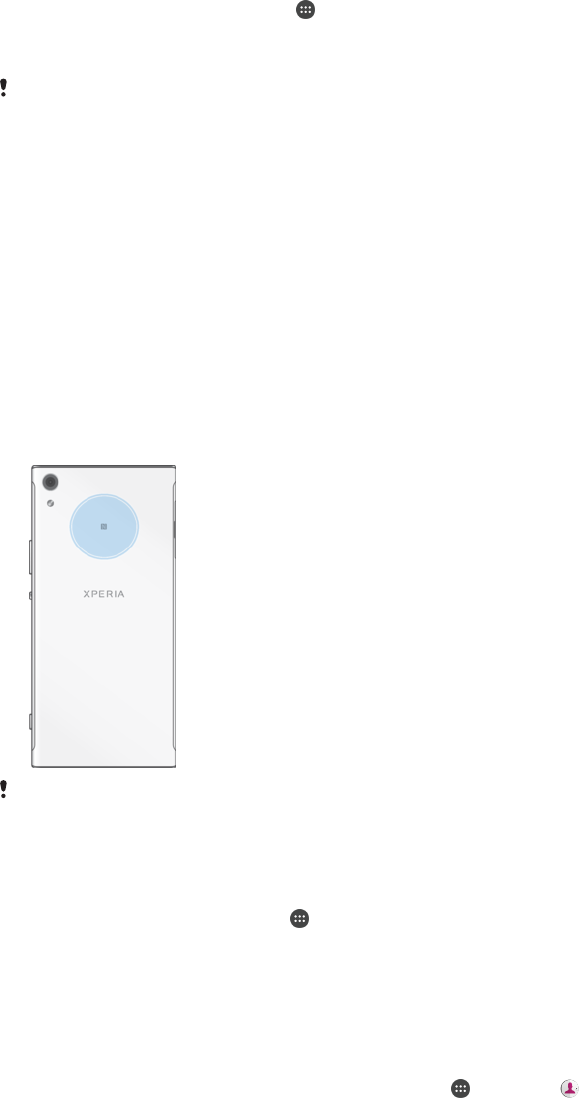
To connect a USB Type-C™ accessory using a USB Type-C connector
1Attach the USB Type-C connector of the USB Type-C accessory to your
device.
2From your Home screen , tap .
3Find and tap Settings > Device connection > USB Connectivity > Detect USB
device.
Sony does not guarantee that all USB Type-C accessories with a USB Type-C connector are
supported by your device.
NFC
Use Near Field Communication (NFC) to share data with other devices, such as
videos, photos, web page addresses, music files or contacts. You can also use NFC
to scan tags that give you more information about a product or service as well as
tags that activate certain functions on your device.
NFC is a wireless technology with a maximum range of one centimetre, so the
devices sharing data must be held close to each other. Before you can use NFC, you
must first turn on the NFC function, and the screen of your device must be active.
The NFC detection area is located on the back of the device. Hold your device close
to another device or an NFC reader so that the NFC detection areas touch each
other.
NFC may not be available in all countries or regions. Using certain apps, some NFC functions
can be enabled even when the device is switched off. Note that not all devices support this
feature.
To enable or disable the NFC function
1From your Home screen, tap .
2Find and tap Settings > More.
3Tap the NFC slider.
To share a contact with another device using NFC
1Make sure that both devices have the NFC function turned on, and that both
screens are active and unlocked.
2To view contacts, go to your Home screen, tap , then tap .
3Tap the contact that you want to share.
4Hold your device and the receiving device close to each other so that the NFC
detection areas of each device touch. When the devices connect, a thumbnail
of the contact appears.
5Tap the thumbnail to start the transfer.
6When the transfer is done, the contact information is saved on the receiving
device and displayed on its screen.
115
This is an internet version of this publication. © Print only for private use.

To share a music file with another device using NFC
1Make sure that both your device and the receiving device have the NFC
function turned on, and that both screens are active and unlocked.
2To open the Music application, tap , then find and tap .
3Select a music category and browse to the track you want to share.
4Tap the track to play it. You can then tap to pause the track. The transfer
works whether the track is playing or paused.
5Make sure the track is displayed on full screen.
6Hold your device and the receiving device close to each other so that the NFC
detection areas of each device touch. When the devices connect, a thumbnail
of the track appears.
7Tap the thumbnail to start the transfer.
8When the transfer is done, the music file is saved on the receiving device.
9To display the music file, double-tap the status bar to open the Notification
panel, and then tap Beam complete .
To share a photo or video with another device using NFC
1Make sure that both devices have the NFC function turned on, and that both
screens are active and unlocked.
2To view photos and videos on your device, go to your Home screen, tap ,
then find and tap Album.
3Tap the photo or video that you want to share.
4Hold your device and the receiving device close to each other so that the NFC
detection areas of each device touch. When the devices connect, a thumbnail
of the photo or video appears.
5Tap the thumbnail to start the transfer.
6When the transfer is done, the photo or video is saved on the receiving device.
To share a web address with another device using NFC
1Make sure that both devices have the NFC function turned on, and that both
screens are active and unlocked.
2From your Home screen, tap .
3To open the web browser, find and tap .
4Load the web page that you want to share.
5Hold your device and the receiving device close to each other so that the NFC
detection areas of each device touch. When the devices connect, a thumbnail
of the web page appears.
6Tap the thumbnail to start the transfer.
7When the transfer is done, the web page is displayed on the screen of the
receiving device.
Scanning NFC tags
Your device can scan various kinds of NFC tags to receive additional information,
such as a web address. For example, it can scan embedded tags on a poster, on a
billboard advertisement, or beside a product in a retail store.
To scan an NFC tag
1Make sure that your device has the NFC function turned on and that the screen
is active and unlocked.
2Place your device over the tag so that the NFC detection area touches it. Your
device scans the tag and displays the content collected. Tap the content of the
tag to open it.
116
This is an internet version of this publication. © Print only for private use.

Connecting to an NFC compatible device
You can connect your device to other NFC compatible devices produced by Sony,
such as a speaker or a headphone. When establishing this kind of connection, refer
to the User guide of the compatible device for more information.
You may need to have Wi-Fi or Bluetooth® activated on both devices for the connection to
work.
Bluetooth® wireless technology
Use the Bluetooth® function to send files to other Bluetooth® compatible devices, or
to connect to handsfree accessories. Bluetooth® connections work better within 10
metres (33 feet), with no solid objects in between. In some cases you have to
manually pair your device with other Bluetooth® devices.
Interoperability and compatibility among Bluetooth® devices can vary.
If you are using a device with multiple users, each user can change the Bluetooth® settings,
and the changes affect all users.
To turn the Bluetooth® function on or off
1From your Home screen, tap .
2Find and tap Settings > Bluetooth.
3Tap the Bluetooth slider to enable or disable the function.
Naming your device
You can give your device a name. This name is shown to other devices after you
have turned on the Bluetooth® function and your device is set to visible.
To give your device a name
1Make sure that the Bluetooth® function is turned on.
2From your Home screen, tap .
3Find and tap Settings > Bluetooth.
4Tap > Rename this device.
5Enter a name for your device.
6Tap RENAME.
Pairing with another Bluetooth® device
When you pair your device with another device, you can for example connect your
device to a Bluetooth® headset or a Bluetooth® car kit, and use these other devices
to share music.
Once you pair your device with another Bluetooth® device, your device remembers
this pairing. When pairing your device with a Bluetooth® device for the first time, you
may need to enter a passcode. Your device will automatically try the generic
passcode 0000. If this does not work, refer to the user guide for your Bluetooth®
device to get the device passcode. You do not need to re-enter the passcode the
next time you connect to a previously paired Bluetooth® device.
Some Bluetooth® devices, for example, most Bluetooth® headsets, require you to both pair
and connect with the other device.
You can pair your device with several Bluetooth® devices, but you can only connect to one
Bluetooth® profile at the same time.
117
This is an internet version of this publication. © Print only for private use.

To pair your device with another Bluetooth® device
1Make sure that the device you want to pair with has the Bluetooth® function
activated and is visible to other Bluetooth® devices.
2From your device’s Home screen, tap .
3Find and tap Settings > Bluetooth.
4Tap the Bluetooth slider to enable the function. A list of the available
Bluetooth® devices appears.
5Tap the Bluetooth® device that you want to pair with.
6Enter a passcode, if required, or confirm the same passcode on both devices.
To connect your device to another Bluetooth® device
1From your Home screen, tap .
2Find and tap Settings > Bluetooth.
3Tap the Bluetooth® device that you want to connect to.
To unpair a Bluetooth® device
1From your Home screen, tap .
2Find and tap Settings > Bluetooth.
3Under Paired devices, tap beside the name of the device that you want to
unpair.
4Tap FORGET.
Sending and receiving items using Bluetooth® technology
Use Bluetooth® technology to share items with other Bluetooth® compatible devices
such as phones or computers. You can send and receive the following kinds of items:
•Photos and videos
•Music and other audio files
•Web pages
To send items using Bluetooth®
1Receiving device: Make sure the Bluetooth® function is turned on and that the
device is visible to other Bluetooth® devices.
2Sending device: Open the application which contains the item that you want to
send, and scroll to the item.
3Depending on the application and on the item that you want to send, you may
need to, for example, touch and hold the item, open the item, and press .
4Select Bluetooth.
5Turn on Bluetooth® if you are prompted to do so.
6Tap the name of the receiving device.
7Receiving device: If prompted, accept the connection.
8Sending device: If prompted, confirm the transfer to the receiving device.
9Receiving device: Accept the incoming item.
To receive items using Bluetooth®
1Make sure that the Bluetooth® function is on and is visible to other Bluetooth®
devices.
2The sending device now starts sending data to your device.
3If prompted, enter the same passcode on both devices, or confirm the
suggested passcode.
4When you are notified of an incoming file to your device, drag the status bar
downwards and tap the notification to accept the file transfer.
5Tap Accept to start the file transfer.
6To view the progress of the transfer, drag the status bar downwards.
7To open a received item, drag the status bar downwards and tap the relevant
notification.
118
This is an internet version of this publication. © Print only for private use.

To view files you have received using Bluetooth®
1From your Home screen, tap .
2Find and tap Settings > Bluetooth.
3Press and select Show files received.
119
This is an internet version of this publication. © Print only for private use.

Smart apps and features that save you
time
Google Search & Now
Use the Google app to search the internet. You can also enable a feed for regular
updates ‒ for example, you can get traffic information before commuting to work, find
popular restaurants in your area, see your favourite team's current score, and more.
The app can be accessed by tapping in the application list, or you can reserve a
pane on your Home screen for quick access and easy reading.
To enable or disable Your feed
1From your Home screen, tap .
2Find and tap Settings > Google > Search > Your feed.
3Tap the slider to enable or disable the feed.
To reserve a pane on the Home screen for Google Search & Now
1Touch and hold any area on your Home screen until the device vibrates.
2Tap , then tap the Google Now™ slider.
3You can now swipe to the left-most pane on the Home screen to access the
Google Search & Now interface.
If you reserve the left-most pane for Google Search & Now, the main Home screen pane
cannot be changed and additional panes cannot be added to the left. Only the left-most pane
can be reserved.
Using the News Suite application
News Suite is a two-in-one news app featuring a new two-tab concept: switch
between the News tab, where you can find out about all the latest current affairs and
the My Feeds tab, where you can read up on all the news that's most relevant to your
own interests
.
The News Suite application is not available in all markets.
To open the News Suite application
1From your Home screen, tap .
2Find and tap .
Using your device as a wallet
You can use your device to pay for goods without reaching for your real wallet and
manage all payment services in one place. When making a payment, remember to
turn on the NFC function before you touch your device to a card reader. For more
information about NFC, see
NFC
on page 115.
NFC-initiated payments are only supported when an NFC-enabled SIM card is inserted in SIM
card slot 1. Also, mobile payment services may not be available in your region.
To manage payment services
1From your Home screen, tap .
2Find and tap Settings > More > Tap & pay. A list of payment services appears.
3Manage the payment services as desired, for example, you can change your
default payment service.
120
This is an internet version of this publication. © Print only for private use.

Travel and maps
Using location services
Location services allow applications such as Maps and the camera to use information
from your mobile or Wi-Fi network as well as Global Positioning System (GPS)
information to determine your approximate location. If you're not within a clear line of
sight to GPS satellites, your device can determine your location using the Wi-Fi
function. And if you're not within range of a network, your device can determine your
location using your mobile network.
In order to use your device to find out where you are, you need to enable location
services.
You may incur data connection charges when you connect to the internet from your device.
To enable or disable location services
1From your Home screen, tap .
2Find and tap Settings > Location, then tap the slider to enable or disable
location services.
Improving GPS accuracy
The first time you use the GPS function in your device, it can take a few minutes for
your location to be found. To help the search, make sure you have a clear view of the
sky. Stand still and don't cover the GPS antenna (the highlighted area in the image).
GPS signals can pass through clouds and plastic, but not through most solid objects
such as buildings and mountains. If your location isn't found after a few minutes,
move to another location.
Google Maps™ and navigation
Use Google Maps™ to track your current location, view real-time traffic situations
and receive detailed directions to your destination.
The Google Maps™ application requires an internet connection when used online.
You may incur data connection charges when you connect to the internet from your
device. To get more detailed information about how to use this application, go to
http://support.google.com and click the “Maps for mobile” link.
The Google Maps™ application may not be available in every market, country or region.
To use Google Maps™
1From your Home screen, tap .
2Find and tap Google > Maps.
121
This is an internet version of this publication. © Print only for private use.

Using data traffic when travelling
When you travel outside of your home mobile network, you may need to access the
internet using mobile data traffic. If so, you need to activate data roaming on your
device. You may incur additional charges when you activate data roaming. It is
recommended to check the relevant data transmission charges in advance.
If you are using a device with multiple users, you may need to log in as the owner, that is, the
primary user, to activate or deactivate data roaming.
To enable or disable data roaming
1From your Home screen, tap .
2Find and tap Settings > More > Mobile networks.
3Select a SIM card.
4Tap the Data roaming slider to enable or disable the function.
You can’t activate data roaming while mobile data traffic is turned off.
Aeroplane mode
In Aeroplane mode, the network and radio transceivers are turned off to prevent
disturbance to sensitive equipment. However, you can still make emergency calls,
play games, listen to music, watch videos and other content, as long as all this
content is saved on your memory card or internal storage. You can also be notified
by alarms, if alarms are activated.
Turning on Aeroplane mode reduces battery consumption.
To turn on Aeroplane mode
1From your Home screen, tap .
2Find and tap Settings > More.
3Tap the Airplane mode slider.
122
This is an internet version of this publication. © Print only for private use.
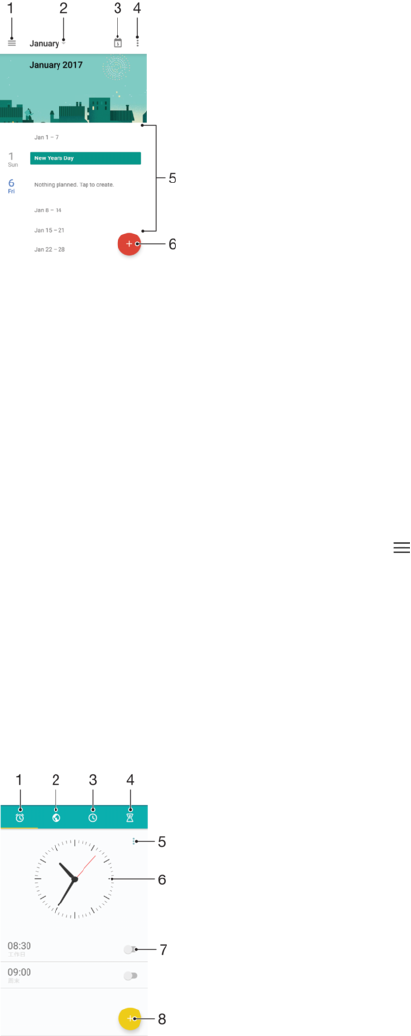
Clock and Calendar
Calendar
Use the Calendar application to manage your time schedule. If you have signed in to
and synchronised your device with one or several online accounts that include
calendars, for example, your Google™ account, then calendar events from these
accounts will also appear in the Calendar application. You can select which
calendars you want to integrate into the combined Calendar view.
When an appointment time approaches, your device plays a notification sound to
remind you.
1 Access settings, select a view type and the calendars that you want to view
2 Access an overview of the current month
3 Return to the current date
4 Access other options
5 Scroll up or down to browse the calendar
6 Add a calendar entry
To learn more about Calendar
•When the Calendar application is open, tap , then find and tap Help &
feedback.
Clock
You can set one or several alarms and use any sound file saved on your device as the
alarm signal. The alarm does not sound if your device is turned off.
The alarm time format displayed is the same as the format you select for your general
time settings, for example, 12-hour or 24-hour.
1 Access the alarms tab
2 Access the world clock tab
123
This is an internet version of this publication. © Print only for private use.

3 Access the stopwatch tab
4 Access the timer tab
5 View options for the current tab
6 Open date and time settings
7 Turn an alarm on or off
8 Add a new alarm
To set a new alarm
1From your Home screen, tap .
2Find and tap Clock.
3Tap .
4Tap Time and select the desired value.
5Tap OK.
6If desired, edit other alarm settings.
7Tap SAVE.
To snooze an alarm when it sounds
•Tap SNOOZE.
To turn off an alarm when it sounds
•Drag to the right.
To turn off a snoozed alarm, you can drag down the status bar to open the Notification panel
and then tap .
To edit an existing alarm
1Find and tap Clock, then tap the alarm that you want to edit.
2Make the desired changes.
3Tap SAVE.
To turn an alarm on or off
•Find and tap Clock, then tap the slider for the alarm you want to turn on or off.
To delete an alarm
1Find and tap Clock, then touch and hold the alarm that you want to delete.
2Tap Delete alarm, then tap YES.
To set the sound for an alarm
1Find and tap Clock, then tap the alarm that you want to edit.
2Tap Alarm sound and select an option, or tap and select a music file.
3Tap DONE, then tap SAVE.
For more information about how to adjust the alarm volume levels, see
Volume settings
on
page 56.
To adjust the volume level for an alarm
1Find and tap Clock, then tap the alarm that you want to edit.
2Drag the volume slider under Alarm volume to the desired position.
3Tap SAVE.
To set a recurring alarm
1Find and tap Clock, then tap the alarm that you want to edit.
2Tap Repeat.
3Mark the checkboxes for the relevant days, then tap OK.
4Tap SAVE.
124
This is an internet version of this publication. © Print only for private use.
To activate the vibrate function for an alarm
1Find and tap Clock, then tap the alarm that you want to edit.
2Tap the Vibrate slider to enable or disable the function.
3Tap SAVE.
To set the side keys behaviour
1Find and tap Clock, then select the alarm that you want to edit.
2Tap Side keys behaviour, then select the desired behaviour of side keys when
they are pressed during the alarm.
3Tap SAVE.
125
This is an internet version of this publication. © Print only for private use.

Accessibility
Magnification gesture
Magnification gesture allows you to zoom in to parts of the screen by tapping an area
of the touchscreen three times in succession.
To enable or disable Magnification gesture
1From your Home screen, tap .
2Find and tap Settings > Accessibility > Magnification gesture.
3Tap the slider under Magnification gesture.
To magnify an area and pan across the screen
1Make sure that Magnification gesture is enabled.
2To temporarily magnify an area, tap it three times.
3Move the area by dragging it with two or more fingers.
4To exit zoom mode, tap the area three times again.
With certain applications, you can also zoom in or out by pinching an area.
Font size
You can enable the Font size option to increase the default size of text displayed on
your device.
To set Font size
1From your Home screen, tap .
2Find and tap Settings > Accessibility.
3Tap Font size, and then set the desired font size by tapping the scale.
Display size
You can use the Display size setting to increase or decrease all elements on your
screen, not just text.
To set Display size
1From your Home screen, tap .
2Find and tap Settings > Accessibility.
3Tap Display size, and then set the desired display size by tapping the scale.
Colour correction
The Colour correction setting adjusts how colours are displayed on the screen for
users who are colour blind or have difficulty distinguishing between colours.
To enable Colour correction
1From your Home screen, tap .
2Find and tap Settings > Accessibility > Colour correction.
3Tap the slider under Colour correction.
4Tap Correction mode, then select the appropriate colour sensitivity.
Colour correction is currently an experimental feature and may affect device performance.
TalkBack
TalkBack is a screen reader service for visually impaired users. TalkBack uses spoken
feedback to describe any events or actions performed on your Android device.
126
This is an internet version of this publication. © Print only for private use.

TalkBack describes the user interface and reads out software errors, notifications and
messages.
To enable TalkBack
1From your Home screen, tap .
2Find and tap Settings > Accessibility > TalkBack.
3Tap the slider under TalkBack and then tap OK.
To change speech, feedback and touch preferences for TalkBack, tap Settings, then tap the
screen twice.
TalkBack launches a tutorial immediately after you enable the feature. To exit the tutorial, tap
, then tap the screen twice.
To disable TalkBack
1From your Home screen, tap , then tap anywhere on the screen twice.
2Find and tap Settings, then tap anywhere on the screen twice.
3Find and tap Accessibility by scrolling through the list with two or more fingers,
then tap anywhere on the screen twice.
4Find and tap TalkBack by scrolling through the list with two or more fingers,
then tap anywhere on the screen twice.
5Tap the on-off switch, and then tap anywhere on the screen twice.
6Tap OK, and then tap anywhere on the screen twice.
Mono audio
The Mono audio setting makes both left and right audio channels get played back
simultaneously when playing audio. Using Mono instead of Stereo playback is most
useful for users with certain types of hearing loss or for safety reasons, for example
when you need to listen to your surroundings.
To enable or disable Mono audio
1From your Home screen, tap .
2Find and tap Settings > Accessibility.
3Tap the slider beside Mono audio.
TTY (Teletypewriter) mode
The TTY (Teletypewriter) feature on your device allows people who are deaf, hard of
hearing, or who have speech or language disabilities, to communicate using a TTY
device or a relay service.
To enable TTY mode
1From your Home screen, tap .
2Find and tap Settings > Call.
3Choose a SIM card, then tap Accessibility > TTY mode.
4Select the applicable TTY mode.
Switch Access
With Switch Access, you can interact with your Xperia™ device using one or more
switches. A switch is a device used to send a keystroke signal to your Android
device. These can be helpful for users with mobility limitations. For more information
about Switch Access, see Settings > Accessibility > Switch Access > SETTINGS >
Help.
127
This is an internet version of this publication. © Print only for private use.

To enable or disable Switch Access
1From your Home screen, tap .
2Find and tap Settings > Accessibility > Switch Access.
3Tap the slider to enable or disable the function, then tap OK.
128
This is an internet version of this publication. © Print only for private use.

Support and legal
Support application
Use the Support application on your device to browse User guides, troubleshooting
guides, and to find information about software updates and other product-related
information.
To access the Support application
1From your Home screen, tap .
2Find and tap , then select the required support item.
Connect to the internet when using the Support application for the best available support.
Xperia™ Tips
Using Xperia™ Tips you can get useful information for your device via notifications,
and learn all you need to get started.
To enable or disable Xperia™ Tips
1From your Home screen, tap .
2Find and tap Settings > Introduction & Tips.
3Tap the Xperia™ Tips slider.
Help in menus and applications
Some applications and settings have help available in the options menu, which is
normally indicated by in the individual applications.
Running diagnostic tests on your device
The Xperia™ Diagnostics application can test a specific function or run a full
diagnostic test to check if your Xperia™ device is working properly.
Xperia™ Diagnostics can:
•Assess potential hardware or software issues on your Xperia™ device.
•Analyse how well applications perform on your device.
•Log the number of dropped calls during the previous 10 days.
•Identify installed software and provide useful details about your device.
The Xperia™ Diagnostics application is pre-installed on most Android™ devices from Sony. If
the Diagnostics option is not available under Settings > About phone or from the TOOLS
menu in the Support application, you can download a light version using the Play Store™
application.
Restarting, resetting and repairing
You can force your device to restart or shut down if it stops responding or won't
restart normally. No settings or personal data get deleted.
You can also reset your device to its original factory settings. This action is
sometimes necessary if your device stops functioning properly, but note that if you
want to keep any important data, you should first back up this data to a memory card
or other non-internal memory. For more information, see
Backing up and restoring
content
on page 42.
129
This is an internet version of this publication. © Print only for private use.

If your device fails to turn on or you want to reset your device’s software, you can use
Xperia™ Companion to repair your device. For more information on using Xperia™
Companion, see
Xperia™ Companion
on page 39.
If you are sharing a device with multiple users, you may need to log in as the owner, that is,
the primary user, to reset your device to its original factory settings.
To restart your device
Your device may fail to restart if the battery level is low. Connect your device to a charger and
try restarting again.
1Press and hold down the power key .
2In the menu that opens, tap Restart. The device restarts automatically.
To force the device to restart or shut down
1Press and hold down the power key and the volume up key at the same time
for 6 seconds.
2Your device vibrates once. Depending on whether you wish to force the device
to restart or shut down, proceed as follows.
•If you wish to force restart the device: Release the keys at this point. The
device restarts.
•If you wish to force shut down the device: Continue pressing the keys. After
a few more seconds, the device vibrates three times and turns off.
To perform a factory data reset
To avoid permanent damage to your device, do not interrupt a factory data reset procedure.
1Back up any important data that is saved on the internal memory of your
device to a memory card or other non-internal memory. If you have any
encrypted files stored on an SD card, you should also remove the encryption to
ensure you can still access them after the reset.
2From your Home screen, tap .
3Find and tap Settings > Backup & reset > Factory data reset.
4Tap Reset phone.
5If required, draw your screen unlock pattern or enter your screen unlock
password or PIN to continue.
6To confirm, tap Erase everything.
Your device does not revert to an earlier software version of Android™ when you perform a
factory data reset.
Repairing the device software
If you forget your screen unlock password, PIN or pattern, you can use the device
repair feature in Xperia™ Companion to erase the security layer. You need to provide
your Google account login details to perform this operation. By running the repair
feature, you reinstall software for your device and you may lose some personal data
in the process.
If you can’t turn off your device before performing a software repair, force it to shut
down.
When you receive a new Google™ account username or password, you might not be able to
use them to log in to and recover your device for 72 hours.
To repair the device software using Xperia™ Companion
Before performing a software repair, make sure you know your Google™ account username
and password. Depending on your security settings, you may need to enter them in order to
restart the device after a software repair.
If your device seems to have frozen, restarts repeatedly or doesn’t start at all after
you’ve updated the Xperia™ software or after you’ve performed a software repair or a
factory data reset, try forcing the device to shut down then try turning it back on. If
130
This is an internet version of this publication. © Print only for private use.

the problem still exists, force the device to shut down then perform a software repair
by following the steps below:
1Make sure that Xperia™ Companion is installed on your PC or Mac®.
2Open the Xperia™ Companion software on the computer and click on Software
repair on the main screen.
3Follow the instructions that appear on the screen to reinstall the software and
complete the repair.
Help us improve our software
You can allow the sending of usage info from your device so that Sony Mobile can
receive anonymous bug reports and statistics that help improve our software. None
of the information gathered includes personal data.
To allow the sending of usage info
1From your Home screen, tap .
2Find and tap Settings > About phone > Usage info settings.
3Mark the Send usage info checkbox if it is not already marked.
4Tap Agree.
Warranty, SAR and usage guidelines
For information about warranty, SAR (Specific Absorption Rate) and safety guidelines,
please read the Important information provided under Settings > About phone > Legal
information on your device.
Recycling your device
Got an old device lying around the house? Why not recycle it? By doing so, you will
help us reuse its materials and components, and you’ll protect the environment too!
Find out more about the recycling options in your region at
www.sonymobile.com/
recycle/
.
Legal information
Sony G3212/G3226
This User guide is published by Sony Mobile Communications Inc. or its local affiliated company, without any
warranty. Improvements and changes to this User guide necessitated by typographical errors, inaccuracies of
current information, or improvements to programs and/or equipment, may be made by Sony Mobile
Communications Inc. at any time and without notice. Such changes will, however, be incorporated into new
editions of this User guide. All illustrations are for illustration purposes only and may not accurately depict the
actual device.
All product and company names mentioned herein are the trademarks or registered trademarks of their
respective owners. All other trademarks are property of their respective owners. Any rights not expressly
granted herein are reserved. Visit
www.sonymobile.com/us/legal/
for more information.
This User guide may reference services or applications provided by third parties. Use of such programming or
services may require separate registration with the third party provider and may be subject to additional terms
of use. For applications accessed on or through a third-party website, please review such websites’ terms of
use and applicable privacy policy in advance. Sony does not warrant or guarantee the availability or
performance of any third-party websites or offered services.
Your mobile device has the capability to download, store and forward additional content, for example,
ringtones. The use of such content may be restricted or prohibited by rights of third parties, including but not
limited to restriction under applicable copyright laws. You, and not Sony, are entirely responsible for additional
content that you download to or forward from your mobile device. Prior to your use of any additional content,
please verify that your intended use is properly licensed or is otherwise authorized. Sony does not guarantee
the accuracy, integrity or quality of any additional content or any other third party content. Under no
circumstances will Sony be liable in any way for your improper use of additional content or other third party
content.
Visit
www.sonymobile.com
for more information.
This product is protected by certain intellectual property rights of Microsoft. Use or distribution of such
technology outside of this product is prohibited without a licence from Microsoft.
Content owners use Windows Media digital rights management technology (WMDRM) to protect their
intellectual property, including copyrights. This device uses WMDRM software to access WMDRM-protected
content. If the WMDRM software fails to protect the content, content owners may ask Microsoft to revoke the
software's ability to use WMDRM to play or copy protected content. Revocation does not affect unprotected
content. When you download licences for protected content, you agree that Microsoft may include a
revocation list with the licences. Content owners may require you to upgrade WMDRM to access their content.
If you decline an upgrade, you will not be able to access content that requires the upgrade.
131
This is an internet version of this publication. © Print only for private use.
This product is licensed under the MPEG-4 visual and AVC patent portfolio licences for the personal and non-
commercial use of a consumer for (i) encoding video in compliance with the MPEG-4 visual standard
("MPEG-4 video") or the AVC standard ("AVC video") and/or (ii) decoding MPEG- 4 or AVC video that was
encoded by a consumer engaged in a personal and non-commercial activity and/or was obtained from a video
provider licenced by MPEG LA to provide MPEG-4 and/or AVC video. No licence is granted or shall be implied
for any other use. Additional information including that relating to promotional, internal and commercial uses
and licensing may be obtained from MPEG LA, L.L.C. See
www.mpegla.com
. MPEG Layer-3 audio decoding
technology licenced from Fraunhofer IIS and Thomson.
SONY MOBILE WILL NOT BE LIABLE FOR ANY LOSS, DELETION AND/OR DATA-OVERWRITING OF
PERSONAL DATA OR FILES STORED ON YOUR DEVICE (INCLUDING BUT NOT LIMITED TO CONTACTS,
MUSIC TRACKS AND PICTURES) ARISING OUT OF ANY UPDATE OF YOUR DEVICE BY ANY OF THE
METHODS DESCRIBED IN THIS USER GUIDE OR DOCUMENTATION. IN NO EVENT SHALL SONY MOBILE’S
OR ITS SUPPLIERS’ TOTAL LIABILITY TO YOU FOR ANY AND ALL DAMAGES, LOSSES AND CAUSES OF
ACTION (WHETHER IN CONTRACT OR TORT, INCLUDING, BUT NOT LIMITED TO NEGLIGENCE OR
OTHERWISE) EXCEED THE AMOUNT ACTUALLY PAID BY YOU FOR YOUR DEVICE.
© 2017 Sony Mobile Communications Inc.
All rights reserved.
132
This is an internet version of this publication. © Print only for private use.